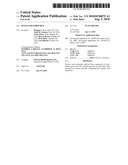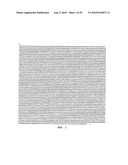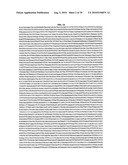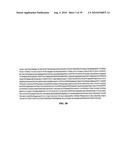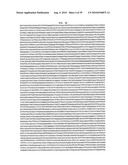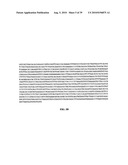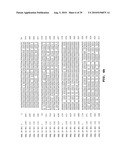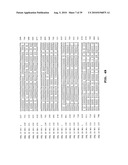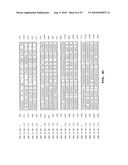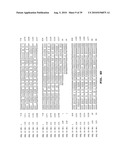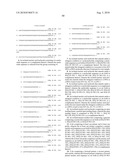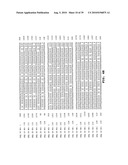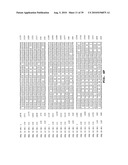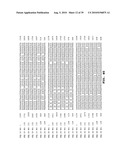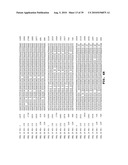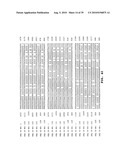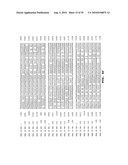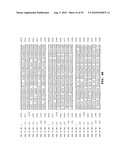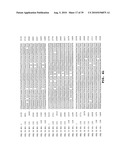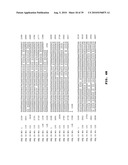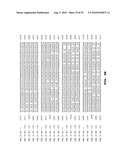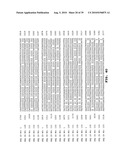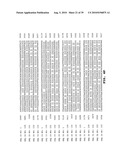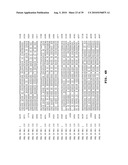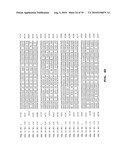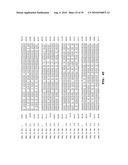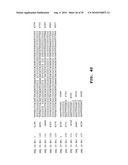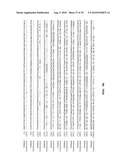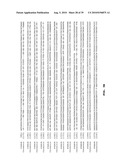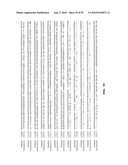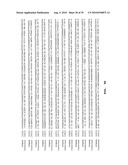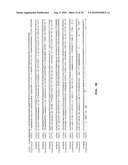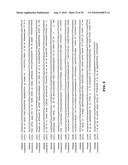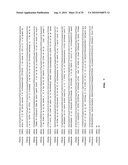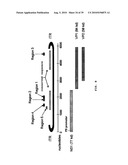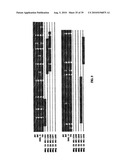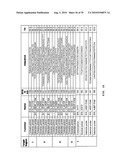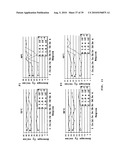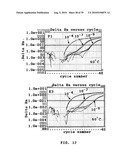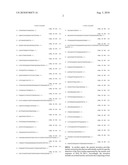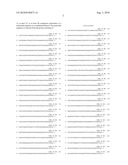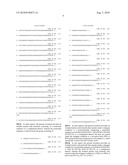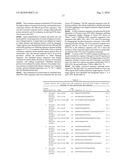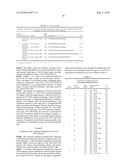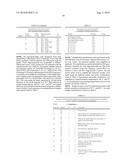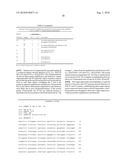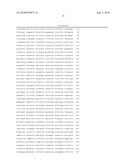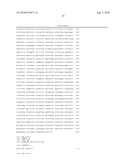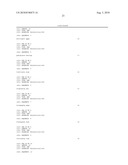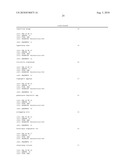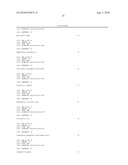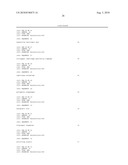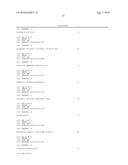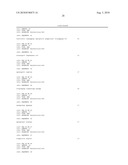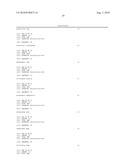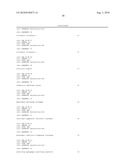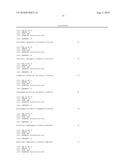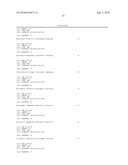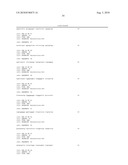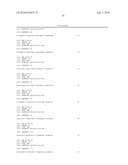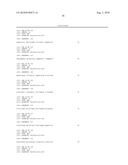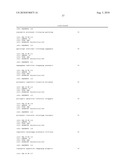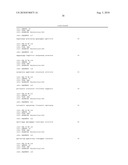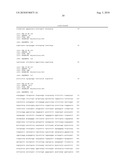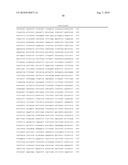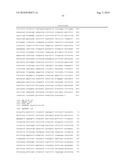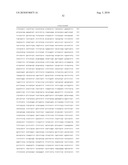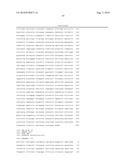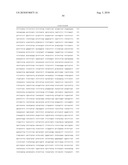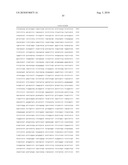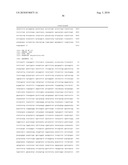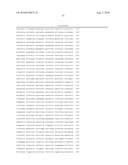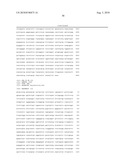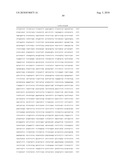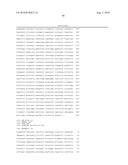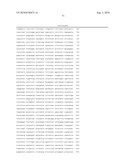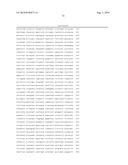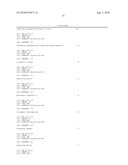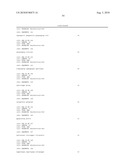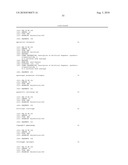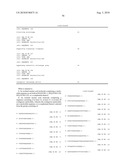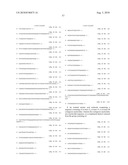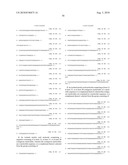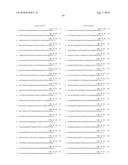Patent application title: HUMAN ERYTHROVIRUS
Inventors:
Douglas C. Lee (Apex, NC, US)
Todd M. Gieman (Cary, NC, US)
Chris Glenn (Holly Springs, NC, US)
Burton Beams (Raleigh, NC, US)
Brett Buno (Durham, NC, US)
Lori Rinckel (Clayton, NC, US)
Assignees:
Talecris Biotherapeutics, Inc.
IPC8 Class: AC12Q170FI
USPC Class:
435 5
Class name: Chemistry: molecular biology and microbiology measuring or testing process involving enzymes or micro-organisms; composition or test strip therefore; processes of forming such composition or test strip involving virus or bacteriophage
Publication date: 2010-08-05
Patent application number: 20100196875
Claims:
1. An isolated nucleic acid molecule comprising a nucleotide sequence as
set forth in SEQ ID NO: 1, SEQ ID NO:128, SEQ ID NO:129, or a complement
thereof.
2. An isolated nucleic acid molecule comprising a sequence consisting of at least 12, at least 15, or at least 20 contiguous nucleotides, wherein the contiguous nucleotides are a nucleotide sequence, or a complement thereof, selected from the group consisting of: TABLE-US-00010 (SEQ ID NO: 2) 5'-GATAACTGGTGGTGCTCT-3'; (SEQ ID NO: 3) 5'-ACTTCTGACTGGGA-3'; (SEQ ID NO: 4) 5'-GAATGTAACAAATTTGA-3'; (SEQ ID NO: 5) 5'-TTATTTAATAATGT-3'; (SEQ ID NO: 6) 5'-CTTGTAACTGAAA-3'; (SEQ ID NO: 7) 5'-TTTAGAGATGGAGA-3'; (SEQ ID NO: 8) 5'-TTAATGAAAAAAAT-3'; (SEQ ID NO: 9) 5'-CCTTTAAATGTTGT-3'; (SEQ ID NO: 10) 5'-CAGACTTTGAGCAGG-3'; (SEQ ID NO: 11) 5'-TGGAATAATGAAAA-3'; (SEQ ID NO: 12) 5'-TTTCCATTTAATGATGTAGC-3'; (SEQ ID NO: 13) 5'-TTGGTGGTCTGGGATGA-3'; (SEQ ID NO: 14) 5'-GAAGCTGCAAAAGCCATTTTAGG-3'; (SEQ ID NO: 15) 5'-ACCAGGGTAGATCA-3'; (SEQ ID NO: 16) 5'-ATAACCAGCAATGGTGACATTAC-3'; (SEQ ID NO: 17) 5'-CATGCTAAAGCCTTAAA-3'; (SEQ ID NO: 18) 5'-AGCCCTGACATGGG-3'; (SEQ ID NO: 19) 5'-TGGTGTAATGCACAAAGCTGG-3'; (SEQ ID NO: 20) 5'-CCACTATGAAAACTGGGCAATAAACTACAC-3'; (SEQ ID NO: 21) 5'-TTTGATTTCCCTGGAAT-3'; (SEQ ID NO: 22) 5'-AATGCAGATGCCCTCCACCCAGA-3'; (SEQ ID NO: 23) 5'-CTCCAAACCACCCC-3'; (SEQ ID NO: 24) 5'-TCAGCAGCAGTGGTGGTGAAAGCTCTGAAGAACTC-3'; (SEQ ID NO: 25) 5'-CCAGGCGCCTGGAACA-3'; (SEQ ID NO: 26) 5'-TGAAACCCCGCGCTCTAGTACGCC-3'; (SEQ ID NO: 27) 5'-TCCCCGGGACCAGTTCAGGAGAATCATTTGTCGGAAGC-3'; (SEQ ID NO: 28) 5'-CAGTTTCGTGAACTGTTAGT-3'; (SEQ ID NO: 29) 5'-GCTTGGTATAATGGATGGAA-3'; (SEQ ID NO: 30) 5'-AAATGTGCTTACCT-3'; (SEQ ID NO: 31) 5'-TTTGTAGATTATGAGTAAA-3'; (SEQ ID NO: 32) 5'-ATTTCTTTAGATAATCC-3'; (SEQ ID NO: 33) 5'-TATATAGTCATCATTTTCA-3'; (SEQ ID NO: 34) 5'-CATGGACAGTTATCTGACCACCCCCATGCCTTATCATCCAGTA-3'; (SEQ ID NO: 35) 5'-CAGAACCTAGAGGAGAAAATGCAGTATTATCTA-3'; (SEQ ID NO: 36) 5'-TGAAGACTTACACAAGCCTGGGCAAGTTAGC-3'; (SEQ ID NO: 37) 5'-TACCCGGTACTAACTATGTTGGGCCTGGCAATGAG-3'; (SEQ ID NO: 38) 5'-TACAAGCTGGGCC-3'; (SEQ ID NO: 39) 5'-GACAGTGCTGCAAGGATTCATGACTTTAGGTATAGCCAA-3'; (SEQ ID NO: 40) 5'-TTAAAAAATATAAAAAATGAAAC-3'; (SEQ ID NO: 41) 5'-TACTTTACTTTAAAAGGTGCAGCTGCCCCTGTGGCCCATTTTCAAGG AAGTTT-3'; (SEQ ID NO: 42) 5'-TACAACGCCTCAGAAAAATACCC-3'; (SEQ ID NO: 43) 5'-AGCATGACTTCAGTTAA-3'; (SEQ ID NO: 44) 5'-TCTGCAGAAGCCAGCACTGGTGCAGG-3'; (SEQ ID NO: 45) 5'-AAAAGCATGTGGAGTGA-3'; (SEQ ID NO: 46) 5'-AGTAGCTGCCACAATGC-3'; (SEQ ID NO: 47) 5'-TTAGATTTTAATGCTTT-3'; (SEQ ID NO: 48) 5'-GATGCTTTAACTGT-3'; (SEQ ID NO: 49) 5'-TATGCTTACTTAACAGTAGG-3'; (SEQ ID NO: 50) 5'-AGTGAAGAATCAGC-3'; (SEQ ID NO: 51) 5'-TTTTATGAAATGTACAA-3'; (SEQ ID NO: 52) 5'-GCTGAAGACAAAGAGTATCA-3'; (SEQ ID NO: 53) 5'-AATGAAAAAGAACA-3'; (SEQ ID NO: 54) 5'-TGGAACAGAAGAGC-3'; (SEQ ID NO: 55) 5'-CTTCACTATGAAAG-3'; (SEQ ID NO: 56) 5'-CCTCAAATATTTTTAAAAATA-3'; (SEQ ID NO: 57) 5'-CCTCAAATATTTTTAAAAATA-3'; (SEQ ID NO: 58) 5'-CATTTACCATATGTACT-3'; (SEQ ID NO: 59) 5'-TATGACCCCACAGCTACAGATGCAAA-3'; (SEQ ID NO: 60) 5'-GGATATGAAAAGCCTGAAGAATTGTGGAC-3'; (SEQ ID NO: 134) 5'-TCAGCAGCAGTGGTGGTGAAAGCTCTGAAGAACTCAGTGAAAGCAGC TTT-3'; and (SEQ ID NO: 135) 5'-CTTAAAAACTCTCCAGAC-3'.
3. An isolated nucleic acid molecule comprising a sequence consisting of at least 12, at least 15, or at least 20 contiguous nucleotides, wherein the contiguous nucleotides are a nucleotide sequence, or a complement thereof, selected from the group consisting of: TABLE-US-00011 (SEQ ID NO: 13) 5'-TTGGTGGTCTGGGATGA-3'; (SEQ ID NO: 14) 5'-GAAGCTGCAAAAGCCATTTTAGG-3'; (SEQ ID NO: 15) 5'-ACCAGGGTAGATCA-3'; (SEQ ID NO: 16) 5'-ATAACCAGCAATGGTGACATTAC-3'; (SEQ ID NO: 17) 5'-CATGCTAAAGCCTTAAA-3'; (SEQ ID NO: 18) 5'-AGCCCTGACATGGG-3'; (SEQ ID NO: 19) 5'-TGGTGTAATGCACAAAGCTGG-3'; (SEQ ID NO: 20) 5'-CCACTATGAAAACTGGGCAATAAACTACAC-3'; (SEQ ID NO: 21) 5'-TTTGATTTCCCTGGAAT-3'; (SEQ ID NO: 22) 5'-AATGCAGATGCCCTCCACCCAGA-3'; (SEQ ID NO: 23) CTCCAAACCACCCC-3'; (SEQ ID NO: 24) 5'-TCAGCAGCAGTGGTGGTGAAAGCTCTGAAGAACTC-3'; (SEQ ID NO: 25) 5'-CCAGGCGCCTGGAACA-3'; (SEQ ID NO: 26) 5'-TGAAACCCCGCGCTCTAGTACGCC-3'; (SEQ ID NO: 27) 5'-TCCCCGGGACCAGTTCAGGAGAATCATTTGTCGGAAGC-3'; (SEQ ID NO: 28) 5'-CAGTTTCGTGAACTGTTAGT-3'; (SEQ ID NO: 29) 5'-GCTTGGTATAATGGATGGAA-3'; (SEQ ID NO: 30) 5'-AAATGTGCTTACCT-3'; (SEQ ID NO: 31) 5'-TTTGTAGATTATGAGTAAA-3'; (SEQ ID NO: 32) 5'-ATTTCTTTAGATAATCC-3'; (SEQ ID NO: 33) 5'-TATATAGTCATCATTTTCA-3'; (SEQ ID NO: 34) 5'-CATGGACAGTTATCTGACCACCCCCATGCCTTATCATCCAGTA-3'; (SEQ ID NO: 35) 5'-CAGAACCTAGAGGAGAAAATGCAGTATTATCTA-3'; (SEQ ID NO: 36) 5'-TGAAGACTTACACAAGCCTGGGCAAGTTAGC-3'; (SEQ ID NO: 37) 5'-TACCCGGTACTAACTATGTTGGGCCTGGCAATGAG-3'; (SEQ ID NO: 38) 5'-TACAAGCTGGGCC-3'; (SEQ ID NO: 134) 5'-TCAGCAGCAGTGGTGGTGAAAGCTCTGAAGAACTCAGTGAAAGCAGC TTT-3'; and (SEQ ID NO: 135) 5'-CTTAAAAACTCTCCAGAC-3'.
4. An isolated nucleic acid molecule comprising a sequence consisting of at least 12, at least 15, or at least 20 contiguous nucleotides, wherein the contiguous nucleotides are a nucleotide sequence, or a complement thereof, selected from the group consisting of: TABLE-US-00012 (SEQ ID NO: 13) 5'-TTGGTGGTCTGGGATGA-3'; (SEQ ID NO: 17) 5'-CATGCTAAAGCCTTAAA-3'; (SEQ ID NO: 18) 5'-AGCCCTGACATGGG-3'; (SEQ ID NO: 19) 5'-TGGTGTAATGCACAAAGCTGG-3'; (SEQ ID NO: 22) 5'-AATGCAGATGCCCTCCACCCAGA-3'; (SEQ ID NO: 24) 5'-TCAGCAGCAGTGGTGGTGAAAGCTCTGAAGAACTC-3'; (SEQ ID NO: 25) 5'-CCAGGCGCCTGGAACA-3'; (SEQ ID NO: 27) 5'-TCCCCGGGACCAGTTCAGGAGAATCATTTGTCGGAAGC-3'; (SEQ ID NO: 31) 5'-TTTGTAGATTATGAGTAAA-3'; (SEQ ID NO: 35) 5'-CAGAACCTAGAGGAGAAAATGCAGTATTATCTA-3'; (SEQ ID NO: 36) 5'-TGAAGACTTACACAAGCCTGGGCAAGTTAGC-3'; and (SEQ ID NO: 134) 5'-TCAGCAGCAGTGGTGGTGAAAGCTCTGAAGAACTCAGTGAAAGCAGC TTT-3'.
5. An isolated nucleic acid molecule comprising at least 12, at least 15, or at least 20 contiguous nucleotides of a nucleotide sequence or a complement thereof, wherein the contiguous nucleotides are contained in a nucleotide sequence, or a complement thereof, selected from the group consisting of: TABLE-US-00013 (SEQ ID NO: 61) 5'-CACTTCTGACTGGGAACCATTAACTCATTCTAACAGACT-3', (SEQ ID NO: 62) 5'-ATGTAAAGCTTAAATTTTTACCAGGAATGACTACAAAAG-3', (SEQ ID NO: 63) 5'-AATATTTTAGAGATGGAGAACAATTTATAGAAAATTATT-3', (SEQ ID NO: 64) 5'-ATTTTAGAGATGGAGAACAATTTATAGAAAATTATTTAA-3', (SEQ ID NO: 65) 5'-TAACCAATATTGATGGGTACATAGATACCTGCATTTCTG-3', (SEQ ID NO: 66) 5'-ATGGGTACATAGATACCTGCATTTCTGCTTCTTTTAGAC-3', (SEQ ID NO: 67) 5'-TTAGACGGGGAGCCTTTCAGGCTAAAAAACCCCGCATTA-3', (SEQ ID NO: 68) 5'-GAACCAGGGGAATCTAGCGCTACAGGGGGAGATGTTGTG-3', (SEQ ID NO: 69) 5'-TGCCATTTGCTGGGAAGGGGACTAAAGCTGGAATAAAAT-3', (SEQ ID NO: 70) 5'-GGACTAAAGCTGGAATAAAATTTCAAACTATGGTAAATT-3', (SEQ ID NO: 71) 5'-TAAATTGGTTGTGTGAAAATAGGGTTTTTACAGAGGATA-3', (SEQ ID NO: 72) 5'-ATTGGTTGTGTGAAAATAGGGTTTTTACAGAGGATAAGT-3', (SEQ ID NO: 73) 5'-TTAACCAGTACACTTTACTTAGCAGTAGTCACAGTGGGA-3', (SEQ ID NO: 74) 5'-TAAAACTAGCTATTTATAAGGCTACCAATTTAGTGCCTA-3', (SEQ ID NO: 75) 5'-TAGCTATTTATAAGGCTACCAATTTAGTGCCTACAAGTA-3', (SEQ ID NO: 76) 5'-CTACCAATTTAGTGCCTACAAGTACATTTTTGTTACACA-3', (SEQ ID NO: 77) 5'-CAAGTACATTTTTGTTACACACAGACTTTGAGCAGGCTA-3', (SEQ ID NO: 78) 5'-CACACAGACTTTGAGCAGGCTAACTGTATTAAAGAAAAT-3', (SEQ ID NO: 79) 5'-GTGTCAAAATTATGACCCCTTGTTGGTGGGACAGCATGT-3', (SEQ ID NO: 80) 5'-GGATTGATAAAAAATGTGGCAAAAAAAATACACTGTGGT-3', (SEQ ID NO: 81) 5'-ATACACTGTGGTTTTATGGCCCACCAAGTACAGGAAAAA-3', (SEQ ID NO: 82) 5'-GTACAGGAAAAACAAATTTAGCAATGGCTATTGCTAAAA-3', (SEQ ID NO: 83) 5'-GCTTGGTGGTCTGGGATGAGGGTATTATTAAGTCTACTA-3', (SEQ ID NO: 84) 5'-GCTTACTTACAGAGGCTGACGTGCAGCAATGGCTTACAT-3', (SEQ ID NO: 85) 5'-CCCCGCGCTCTAGTACGCCAGTCCCCGGGACCAGTTCAG-3', (SEQ ID NO: 86) 5'-AGAATCATTTGTCGGAAGCTCAATTTCCTCCGAAGCTGT-3', (SEQ ID NO: 87) 5'-ATCATTTGTCGGAAGCTCAATTTCCTCCGAAGCTGTAGC-3', (SEQ ID NO: 88) 5'-AGCTCAATTTCCTCCGAAGCTGTAGCTGCATCGTGGGAA-3', (SEQ ID NO: 89) 5'-TGACTATGTATGGGATGGTATAAGGGGTTTACCTGTTTG-3', (SEQ ID NO: 90) 5'-TTAATAACAGTGGGGGAGGCTTGGGATTTTGTCCCCATT-3', (SEQ ID NO: 91) 5'-CAGTGGGGGAGGCTTGGGATTTTGTCCCCATTGCATTAA-3', (SEQ ID NO: 92) 5'-GCAAAAAATGTGCTTACCTATCTGGCTTGCAAAGTTTTG-3', (SEQ ID NO: 93) 5'-AATGTGCTTACCTATCTGGCTTGCAAAGTTTTGTAGATT-3', (SEQ ID NO: 94) 5'-TTTGTAGATTATGAGTAAAGAAATTGGTAAATGGTGGGA-3', (SEQ ID NO: 95) 5'-TTATGAGTAAAGAAATTGGTAAATGGTGGGAAAGTGATG-3', (SEQ ID NO: 96) 5'-CTTCTTTGTTTGACTTAGTGGCTCGTATTAAAAGTAACC-3', (SEQ ID NO: 97) 5'-ATGAAACTGGGTTTCAAGCTCAAGTAGTAAAAGACTACT-3', (SEQ ID NO: 98) 5'-TCCTGATGCTTTAACTGTTGCCATATCAGAAATTGCCAT-3', (SEQ ID NO: 99) 5'-TTGCCATATCAGAAATTGCCATTAAAGATGTTACAGACA-3', (SEQ ID NO: 100) 5'-TGCCATATCAGAAATTGCCATTAAAGATGTTACAGACAA-3', (SEQ ID NO: 101) 5'-AATACAAGTACCCATATGTATTAGGTCAAGGACAAGATA-3', (SEQ ID NO: 102) 5'-AAGATACCTTAGCCCCAGAGCTTCCAATTTGGGTGTACT-3', (SEQ ID NO: 103) 5'-CAGTAGGAGATGTAAACACGCAGGGAATTTCTGGGGACA-3', (SEQ ID NO: 104) 5'-AGAATCAGCGTTTTATGTCCTGGAACACAGCTCTTTTGA-3', (SEQ ID NO: 105) 5'-CTACTATGTCTTATAAGTTCCCTCCAGTGCCCCCAGAGA-3', (SEQ ID NO: 106) 5'-TCCCTCCAGTGCCCCCAGAGAATTTAGAAGGCTGTAGTC-3', (SEQ ID NO: 107) 5'-CCCGTTTAGGAGTCCCTGATACATTAGGAGGGGACCCCA-3', (SEQ ID NO: 108) 5'-AACACATGAAGACCACGCAGTTCAGCCACAAAATTTTAT-3', (SEQ ID NO: 109) 5'-ACGCAGTTCAGCCACAAAATTTTATGCCAGGGCCACTGG-3', (SEQ ID NO: 110) 5'-GGCCACTGGTAAACTCAGTTTCCACAAAGGAGGGAGACA-3', (SEQ ID NO: 111) 5'-AGGAGGGAGACAGTTCTAACACAGGAGCGGGAAAAGCCC-3', (SEQ ID NO: 112) 5'-GTCAAAGTACTAGAATATCATTACGCCCTGGTCCAGTGT-3', (SEQ ID NO: 113) 5'-GCCCTGGTCCAGTGTCTCAACCATATCACCACTGGGACA-3', (SEQ ID NO: 114) 5'-GTCCAGTGTCTCAACCATATCACCACTGGGACACAGATA-3', (SEQ ID NO: 115) 5'-CAGATAAATATGTAACAGGGATAAATGCCATTTCTCATG-3', (SEQ ID NO: 116) 5'-CTGAAGACAAAGAGTATCAACAGGGCGTGGGTAGGTTTC-3', (SEQ ID NO: 117) 5'-AAGACAAAGAGTATCAACAGGGCGTGGGTAGGTTTCCCA-3', (SEQ ID NO: 118) 5'-AGGGCGTGGGTAGGTTTCCCAATGAAAAAGAACAACTAA-3', (SEQ ID NO: 119) 5'-AACAGTTACAGGGTTTAAATATACACACATATTTTCCCA-3', (SEQ ID NO: 120) 5'-GTTTAAATATACACACATATTTTCCCAATAAAGGTACCC-3', (SEQ ID NO: 121) 5'-TACCAAATTTAGATGACAGCTTTAAAACTCAGTTTGCAG-3', (SEQ ID NO: 122) 5'-AGCTTTAGGAGGTTGGGGACTACATCAGCCACCCCCTCA-3', (SEQ ID NO: 123) 5'-GGCCAATTGGGGGTATTAAGTCAATGGGAATAACAACAT-3', (SEQ ID NO: 124) 5'-TTAAGTCAATGGGAATAACAACATTAGTTCAATATGCTG-3', (SEQ ID NO: 125) 5'-TAGTTCAATATGCTGTGGGTATTATGACAGTAACTATGA-3', (SEQ ID NO: 126) 5'-TAACTATGACATTTAAATTAGGGCCTCGCAAAGCTACAG-3', and (SEQ ID NO: 127) 5'-ACCCTCCTCACGCAGCAGGCCATTTACCATATGTACTAT-3'.
6. An isolated nucleic acid molecule consisting of a nucleotide sequence or a complement thereof, wherein the nucleotide sequence is selected from the group consisting of: TABLE-US-00014 (SEQ ID NO: 136) 5'-TGAAACCCCGCGCTCTA-3'; (SEQ ID NO: 137) 5'-AACTAACAGTTCACGAAACTG-3'; (SEQ ID NO: 138) 5'-TCCCCGGGACCAGTTCAGGAGAA-3'; (SEQ ID NO: 139) 5'-TCAGCAGCAGTGGTGGT-3'; (SEQ ID NO: 140) 5'-TAGAGCGCGGGGTTTCA-3'; (SEQ ID NO: 141) 5'-TGAAAGCTCTGAAGAACTCAGTGAAAGCAGCTTT-3'; (SEQ ID NO: 142) 5'-AATGCAGATGCCCTCCAC-3'; (SEQ ID NO: 143) 5'-TCAGCAGCAGTGGTGGTGAAAGCTCTGAA-3'; (SEQ ID NO: 144) 5'-TGTTCCAGGCGCCTG-3'; (SEQ ID NO: 145) 5'-CACAGCTACAGATGCAAA-3'; (SEQ ID NO: 146) 5'-GGTGCACACGGCTTTT-3'; (SEQ ID NO: 147) 5'-TGTCCACAATTCTTCAGGCTTTTCATATCC-3'; (SEQ ID NO: 148) 5'-TGGATATGAAAAGCCTGAAGTATTGTGGAC-3'; (SEQ ID NO: 149) 5'-GGTCATTTACCATATGTACT-3'; (SEQ ID NO: 150) 5'-AGCTACAGATGCAAANCAACACCACAGACA-3'; (SEQ ID NO: 151) 5'-GAAAACTTTCCATTTAATGATGT-3'; (SEQ ID NO: 152) 5'-ATTTTTTGATCTACCCTGGT-3'; (SEQ ID NO: 153) 5'-TTGGTGGTCTGGGATGAAGG-3'; (SEQ ID NO: 154) 5'-GTTTTATGGGCCGCCAAGTA-3'; (SEQ ID NO: 155) 5'-TTCATCCCAGACCACCAAGG-3'; (SEQ ID NO: 156) 5'-ATGGCTATTGCTAAAACTGTTCCAGTGTA-3'; (SEQ ID NO: 157) 5'-TGGAATAATGAAAACTTTCCATTTAATGATGTAG-3'; and (SEQ ID NO: 158) 5'-CAATGGCCATTGCTAAAAGTGTTCCA-3'.
7. An isolated nucleic acid molecule that anneals under a stringent condition to a polynucleotide comprising a nucleotide sequence as set forth in SEQ ID NO: 1, SEQ ID NO:128, SEQ ID NO:129, or a complement thereof, but does not anneal under the stringent condition to a non-parvovirus B19 DNA or RNA molecules that may be present in a test sample.
8. An isolated nucleic acid molecule that anneals under a stringent condition to a nucleotide sequence as set forth in SEQ ID NO: 1, SEQ ID NO:128, SEQ ID NO:129, or a complement thereof, wherein the isolated nucleic acid molecule also anneals under the stringent condition to a DNA or a RNA of parvovirus B19 Au, A6, V9, or D91.1.
9. An isolated nucleic acid molecule that anneals under a stringent condition to a nucleotide sequence or a complement thereof, wherein the nucleotide sequence is as set forth in SEQ ID NO: 1, SEQ ID NO:128, SEQ ID NO:129, SEQ ID NO:130, SEQ ID NO:131, SEQ ID NO:132, and SEQ ID NO:133.
10. An isolated nucleic acid molecule that anneals under a stringent condition to a nucleotide sequence as set forth in SEQ ID NO: 1, SEQ ID NO:128, SEQ ID NO:129, or a complement thereof, wherein the isolated nucleic acid molecule does not anneal under the stringent condition to a DNA or a RNA of parvovirus B19 Au, A6, V9, or D91.1.
11. An isolated nucleic acid molecule comprising an open reading frame, a partial open reading frame, wherein the open reading frame is comprised in SEQ ID NO: 1, SEQ ID NO:128, SEQ ID NO:129, or a complement thereof.
12. An isolated human erythrovirus comprising a genome comprising a nucleotide sequence as set forth in SEQ ID NO: 1, SEQ ID NO:128, or SEQ ID NO:129.
13. A kit comprising at least one primer and at least one probe, wherein the at least one primer comprises a primer nucleic acid sequence as set forth in (SEQ ID NO: 136), (SEQ ID NO: 137), (SEQ ID NO: 139), (SEQ ID NO: 140), (SEQ ID NO: 142), (SEQ ID NO: 144), (SEQ ID NO: 145), (SEQ ID NO: 146), (SEQ ID NO: 149), (SEQ ID NO: 151), (SEQ ID NO: 152), (SEQ ID NO: 154), or (SEQ ID NO: 155), wherein the at least one probe comprises a probe nucleic acid sequence as set forth in (SEQ ID NO: 138), (SEQ ID NO: 141), (SEQ ID NO: 143), (SEQ ID NO: 147), (SEQ ID NO: 148), (SEQ ID NO: 150), (SEQ ID NO: 153), (SEQ ID NO: 156), (SEQ ID NO: 157), (SEQ ID NO: 158), or complements thereof.
14. A kit comprising a forward primer, a reverse primer, and a probe, wherein the forward primer comprises a forward primer nucleic acid sequence as set forth in (SEQ ID NO: 136), (SEQ ID NO: 139), (SEQ ID NO: 142), (SEQ ID NO: 145), (SEQ ID NO: 149), (SEQ ID NO: 151), or (SEQ ID NO: 154), wherein the reverse primer comprises a reverse primer nucleic acid sequence as set forth in (SEQ ID NO: 137), (SEQ ID NO: 140), (SEQ ID NO: 144), (SEQ ID NO: 146), (SEQ ID NO: 152), or (SEQ ID NO: 155), wherein the probe comprises a probe nucleic acid sequence as set forth in (SEQ ID NO: 136), (SEQ ID NO: 137), (SEQ ID NO: 138), (SEQ ID NO: 139), (SEQ ID NO: 140), (SEQ ID NO: 141), (SEQ ID NO: 142), (SEQ ID NO: 143), (SEQ ID NO: 144), (SEQ ID NO: 145), (SEQ ID NO: 146), (SEQ ID NO: 147), (SEQ ID NO: 148), (SEQ ID NO: 149), (SEQ ID NO: 150), (SEQ ID NO: 151), (SEQ ID NO: 152), (SEQ ID NO: 153), (SEQ ID NO: 154), (SEQ ID NO: 155), (SEQ ID NO: 156), (SEQ ID NO: 157), (SEQ ID NO: 158), or complements thereof.
15. A method for detecting a parvovirus B19 in a sample, the method comprising:a) performing PCR with at least a portion of the sample using a forward primer having a forward primer nucleic acid sequence and a reverse primer having a reverse primer nucleic acid sequence, wherein the forward primer nucleic acid sequence is as set forth in (SEQ ID NO: 136), (SEQ ID NO: 139), (SEQ ID NO: 142), (SEQ ID NO: 145), (SEQ ID NO: 149), (SEQ ID NO: 151), or (SEQ ID NO:154), wherein the reverse primer nucleic acid sequence is as set forth in (SEQ ID NO: 137), (SEQ ID NO: 140), (SEQ ID NO: 144), (SEQ ID NO: 146), (SEQ ID NO: 152), or (SEQ ID NO:155); andb) determining the presence or absence of an amplicon, wherein the presence of the amplicon is indicative of the presence of the parvovirus B19 in the sample, wherein determining comprises annealing an oligonucleotide to the amplicon.
16. The method of claim 15, wherein the oligonucleotide comprises a sequence as set forth in (SEQ ID NO: 138), (SEQ ID NO: 141), (SEQ ID NO: 143), (SEQ ID NO: 147), (SEQ ID NO: 148), (SEQ ID NO: 150), (SEQ ID NO: 153), (SEQ ID NO: 156), (SEQ ID NO: 157), (SEQ ID NO: 158), or complements thereof.
17. A method for determining parvovirus B19 in a sample, the method comprising:a) amplifying parvovirus B19 nucleic acid in the sample using at least one nucleic acid molecule comprisingi) a sequence consisting of at least 12, at least 15, or at least 20 contiguous nucleotides or a complement thereof, wherein the contiguous nucleotides are contained in a nucleotide sequence selected from the group consisting of (SEQ ID NO: 2), (SEQ ID NO: 3), (SEQ ID NO: 4), (SEQ ID NO: 5), (SEQ ID NO: 6), (SEQ ID NO: 7), (SEQ ID NO: 8), (SEQ ID NO: 9), (SEQ ID NO: 10), (SEQ ID NO: 11), (SEQ ID NO: 12), (SEQ ID NO: 13), (SEQ ID NO: 14), (SEQ ID NO: 15), (SEQ ID NO: 16), (SEQ ID NO: 17), (SEQ ID NO: 18), (SEQ ID NO: 19), (SEQ ID NO: 20), (SEQ ID NO: 21), (SEQ ID NO: 22), (SEQ ID NO: 23), (SEQ ID NO: 24), (SEQ ID NO: 25), (SEQ ID NO: 26), (SEQ ID NO: 27), (SEQ ID NO: 28), (SEQ ID NO: 29), (SEQ ID NO: 30), (SEQ ID NO: 31), (SEQ ID NO: 32), (SEQ ID NO: 33), (SEQ ID NO: 34), (SEQ ID NO: 35), (SEQ ID NO: 36), (SEQ ID NO: 37), (SEQ ID NO: 38), (SEQ ID NO: 39), (SEQ ID NO: 40), (SEQ ID NO: 41), (SEQ ID NO: 42), (SEQ ID NO: 43), (SEQ ID NO: 44), (SEQ ID NO: 45), (SEQ ID NO: 46), (SEQ ID NO: 47), (SEQ ID NO: 48), (SEQ ID NO: 49), (SEQ ID NO: 50), (SEQ ID NO: 51), (SEQ ID NO: 52), (SEQ ID NO: 53), (SEQ ID NO: 54), (SEQ ID NO: 55), (SEQ ID NO: 56), (SEQ ID NO: 57), (SEQ ID NO: 58), (SEQ ID NO: 59), and (SEQ ID NO: 60); orii) at least 12, at least 15, or at least 20 contiguous nucleotides of a nucleotide sequence or a complement thereof, wherein the nucleotide sequence is selected from the group consisting of: (SEQ ID NO: 61), (SEQ ID NO: 62), (SEQ ID NO: 63), (SEQ ID NO: 64), (SEQ ID NO: 65), (SEQ ID NO: 66), (SEQ ID NO: 67), (SEQ ID NO: 68), (SEQ ID NO: 69), (SEQ ID NO: 70), (SEQ ID NO: 71), (SEQ ID NO: 72), (SEQ ID NO: 73), (SEQ ID NO: 74), (SEQ ID NO: 75), (SEQ ID NO: 76), (SEQ ID NO: 77), (SEQ ID NO: 78), (SEQ ID NO: 79), (SEQ ID NO: 80), (SEQ ID NO: 81), (SEQ ID NO: 82), (SEQ ID NO: 83), (SEQ ID NO: 84), (SEQ ID NO: 85), (SEQ ID NO: 86), (SEQ ID NO: 87), (SEQ ID NO: 88), (SEQ ID NO: 89), (SEQ ID NO: 90), (SEQ ID NO: 91), (SEQ ID NO: 92), (SEQ ID NO: 93), (SEQ ID NO: 94), (SEQ ID NO: 95), (SEQ ID NO: 96), (SEQ ID NO: 97), (SEQ ID NO: 98), (SEQ ID NO: 99), (SEQ ID NO: 100), (SEQ ID NO: 101), (SEQ ID NO: 102), (SEQ ID NO: 103), (SEQ ID NO: 104), (SEQ ID NO: 105), (SEQ ID NO: 106), (SEQ ID NO: 107), (SEQ ID NO: 108), (SEQ ID NO: 109), (SEQ ID NO: 110), (SEQ ID NO: 111), (SEQ ID NO: 112), (SEQ ID NO: 113), (SEQ ID NO: 114), (SEQ ID NO: 115), (SEQ ID NO: 116), (SEQ ID NO: 117), (SEQ ID NO: 118), (SEQ ID NO: 119), (SEQ ID NO: 120), (SEQ ID NO: 121), (SEQ ID NO: 122), (SEQ ID NO: 123), (SEQ ID NO: 124), (SEQ ID NO: 125), (SEQ ID NO: 126), and (SEQ ID NO: 127); andb) detecting an amplicon generated in step (a), wherein detection of the amplicon indicates presence of the variant in the sample, wherein detecting optionally comprises the step of annealing at least one nucleic acid molecule of step (a)(ii) to the amplicon.
18. A method for determining parvovirus B19 in a sample, the method comprising:a) amplifying parvovirus B19 nucleic acid in the sample using at least one nucleic acid molecule comprising a sequence consisting of at least 12, at least 15, or at least 20 contiguous nucleotides or a complement thereof, wherein the contiguous nucleotides are contained in a nucleotide sequence selected from the group consisting of: (SEQ ID NO: 2), (SEQ ID NO: 3), (SEQ ID NO: 4), (SEQ ID NO: 5), (SEQ ID NO: 6), (SEQ ID NO: 7), (SEQ ID NO: 8), (SEQ ID NO: 9), (SEQ ID NO: 10), (SEQ ID NO: 11), (SEQ ID NO: 12), (SEQ ID NO: 13), (SEQ ID NO: 14), (SEQ ID NO: 15), (SEQ ID NO: 16), (SEQ ID NO: 17), (SEQ ID NO: 18), (SEQ ID NO: 19), (SEQ ID NO: 20), (SEQ ID NO: 21), (SEQ ID NO: 22), (SEQ ID NO: 23), (SEQ ID NO: 24), (SEQ ID NO: 25), (SEQ ID NO: 26), (SEQ ID NO: 27), (SEQ ID NO: 28), (SEQ ID NO: 29), (SEQ ID NO: 30), (SEQ ID NO: 31), (SEQ ID NO: 32), (SEQ ID NO: 33), (SEQ ID NO: 34), (SEQ ID NO: 35), (SEQ ID NO: 36), (SEQ ID NO: 37), (SEQ ID NO: 38), (SEQ ID NO: 39), (SEQ ID NO: 40), (SEQ ID NO: 41), (SEQ ID NO: 42), (SEQ ID NO: 43), (SEQ ID NO: 44), (SEQ ID NO: 45), (SEQ ID NO: 46), (SEQ ID NO: 47), (SEQ ID NO: 48), (SEQ ID NO: 49), (SEQ ID NO: 50), (SEQ ID NO: 51), (SEQ ID NO: 52), (SEQ ID NO: 53), (SEQ ID NO: 54), (SEQ ID NO: 55), (SEQ ID NO: 56), (SEQ ID NO: 57), (SEQ ID NO: 58), (SEQ ID NO: 59), and (SEQ ID NO: 60); andb) detecting an amplicon generated in step (a), wherein detection of the amplicon indicates presence of the parvovirus B19 in the sample, wherein detecting optionally comprises the step of annealing at least one nucleic acid molecule to the amplicon.
Description:
CROSS REFERENCE TO RELATED APPLICATIONS
[0001]The present application claims the benefit of U.S. Application No. 60/885,074 filed Jan. 16, 2007 and U.S. Application No. 60/942,762 filed Jun. 8, 2007, which are incorporated herein by reference in their entirety.
FIELD OF THE INVENTION
[0002]The present invention relates to human erythrovirus and includes methods and compositions useful for detection of a novel variant.
BACKGROUND OF THE INVENTION
[0003]Members of the Parvoviridae family of viruses are common animal and insect pathogens, which are further classified into the subfamily Parvoviridae based at least on the ability to infect vertebrate cells. Parvovirinae belonging to the genus Erythrovirus are known to infect humans and include, for example, the prototypical parvovirus B19 referred to as Au (genotype 1) as well as variants such as A6 (genotype 2), and V9 and D91.1 (genotype 3). They are non-enveloped viruses that comprise a single-stranded, linear DNA genome. For example, the prototypical human erythrovirus known as parvovirus B19-Au (See e.g., GenBank Accession Number: M13178) has a linear DNA genome of approximately 5.6 kilobases in length.
[0004]Discovered in 1975, parvovirus B19 was subsequently linked to an aplastic crisis in a patient with sickle-cell disease. The virus has since been shown to cause or be associated with a variety of conditions and diseases including erythma infectiosum (EI) (fifth disease of childhood), spontaneous abortion, and certain forms of acute arthritis.
[0005]Erythrovirus are ubiquitous and contagious. In the case of parvovirus B19, an estimated 60% of adults are seropositive. Children are particularly susceptible at the age when they begin to play together regularly and attend school, the peak season for infection being in the spring and early summer.
[0006]In addition to transmission through airborne infections and close contact, human erythrovirus can also be transmitted vertically from a pregnant woman to her fetus. For example, among pregnant women with active cases, about 30% of the fetuses will become infected with parvovirus B19. And, it is now well documented that parvovirus B19 can cause spontaneous abortion when infection occurs within the first six weeks after conception. Infection at this early stage causes massive abnormalities that are inconsistent with life.
[0007]Transmission of human erythrovirus also can occur via blood or plasma products of various kinds. For example, cases of symptomatic illness have been reported to be due to blood products prepared from parvovirus B19-containing plasma pools. Parvovirus B19 DNA has been detected in single donations, in plasma pools, and in plasma derivatives (e.g., clotting factors, albumin, antithrombin III, and immunoglobulins) produced by different processes. Parvovirus B19 transmission has also been found in patients treated with clotting factors, as shown by a higher seroprevalence in treated hemophiliacs, by the presence of parvovirus B19 DNA, and by active seroconversion. Unfortunately, the risk of human erythrovirus transmission by blood/plasma products is enhanced by the virus's resistance to effective inactivation methods such as heat and solvent-detergent treatments.
[0008]Therefore, health risks from exposure to human erythrovirus continue to exist, and identification and characterization of variants of the Erythrovirus genus will constitute an important step towards proper diagnosis and management of infection. Immunodiagnostic methods have been used to test blood, serum, or plasma that is potentially contaminated with human erythrovirus. But such immunodiagnostic methods have limitations including, for example, inability to effectively detect recent or current infections and/or inability to distinguish between the different erythrovirus genotypes. There is still a need, therefore, for identifying and characterizing human erythrovirus variants and developing sensitive and effective assays for detecting them and/or distinguishing from among them.
SUMMARY OF THE INVENTION
[0009]There is now provided an isolated nucleic acid molecule comprising a nucleotide sequence as set forth in SEQ ID NO: 1, SEQ ID NO:128, SEQ ID NO:129, or a complement thereof.
[0010]In one aspect, the present invention provides nucleic acid molecules that are individually useful for detection of Parvoviridae represented by the nucleic acid sequence of SEQ ID NO:1 (i.e., partial genomic sequence of the novel variant named D11 disclosed herein), as well as those of known parvovirus B19 Au genotype 1, A6 genotype 2, V9 genotype 3, and D91.1 genotype 3. Accordingly, the invention includes an isolated nucleic acid molecule comprising a sequence consisting of at least 12, at least 15, or at least 20 contiguous nucleotides or a complement thereof, wherein the contiguous nucleotides are contained in a nucleotide sequence selected from the group consisting of:
TABLE-US-00001 (SEQ ID NO: 2) 5'-GATAACTGGTGGTGCTCT-3'; (SEQ ID NO: 3) 5'-ACTTCTGACTGGGA-3'; (SEQ ID NO: 4) 5'-GAATGTAACAAATTTGA-3'; (SEQ ID NO: 5) 5'-TTATTTAATAATGT-3'; (SEQ ID NO: 6) 5'-CTTGTAACTGAAA-3'; (SEQ ID NO: 7) 5'-TTTAGAGATGGAGA-3'; (SEQ ID NO: 8) 5'-TTAATGAAAAAAAT-3'; (SEQ ID NO: 9) 5'-CCTTTAAATGTTGT-3'; (SEQ ID NO: 10) 5'-CAGACTTTGAGCAGG-3'; (SEQ ID NO: 11) 5'-TGGAATAATGAAAA-3'; (SEQ ID NO: 12) 5'-TTTCCATTTAATGATGTAGC-3'; (SEQ ID NO: 13) 5'-TTGGTGGTCTGGGATGA-3'; (SEQ ID NO: 14) 5'-GAAGCTGCAAAAGCCATTTTAGG-3' (SEQ ID NO: 15) 5'-ACCAGGGTAGATCA-3'; (SEQ ID NO: 16) 5'-ATAACCAGCAATGGTGACATTAC-3'; (SEQ ID NO: 17) 5'-CATGCTAAAGCCTTAAA-3'; (SEQ ID NO: 18) 5'-AGCCCTGACATGGG-3'; (SEQ ID NO: 19) 5'-TGGTGTAATGCACAAAGCTGG-3'; (SEQ ID NO: 20) 5'-CCACTATGAAAACTGGGCAATAAACTACAC-3'; (SEQ ID NO: 21) 5'-TTTGATTTCCCTGGAAT-3'; (SEQ ID NO: 22) 5'-AATGCAGATGCCCTCCACCCAGA-3'; (SEQ ID NO: 23) 5'-CTCCAAACCACCCC-3'; (SEQ ID NO: 24) 5'-TCAGCAGCAGTGGTGGTGAAAGCTCTGAAGAACTC-3'; (SEQ ID NO: 25) 5'-CCAGGCGCCTGGAACA-3'; (SEQ ID NO: 26) 5'-TGAAACCCCGCGCTCTAGTACGCC-3'; (SEQ ID NO: 27) 5'-TCCCCGGGACCAGTTCAGGAGAATCATTTGTCGGAAGC-3'; (SEQ ID NO: 28) 5'-CAGTTTCGTGAACTGTTAGT-3'; (SEQ ID NO: 29) 5'-GCTTGGTATAATGGATGGAA-3'; (SEQ ID NO: 30) 5'-AAATGTGCTTACCT-3'; (SEQ ID NO: 31) 5'-TTTGTAGATTATGAGTAAA-3'; (SEQ ID NO: 32) 5'-ATTTCTTTAGATAATCC-3'; (SEQ ID NO: 33) 5'-TATATAGTCATCATTTTCA-3'; (SEQ ID NO: 34) 5'-CATGGACAGTTATCTGACCACCCCCATGCCTTATCATCCAGTA-3'; (SEQ ID NO: 35) 5'-CAGAACCTAGAGGAGAAAATGCAGTATTATCTA-3'; (SEQ ID NO: 36) 5'-TGAAGACTTACACAAGCCTGGGCAAGTTAGC-3'; (SEQ ID NO: 37) 5'-TACCCGGTACTAACTATGTTGGGCCTGGCAATGAG-3'; (SEQ ID NO: 38) 5'-TACAAGCTGGGCC-3'; (SEQ ID NO: 39) 5'-GACAGTGCTGCAAGGATTCATGACTTTAGGTATAGCCAA-3'; (SEQ ID NO: 40) 5'-TTAAAAAATATAAAAAATGAAAC-3'; (SEQ ID NO: 41) 5'-TACTTTACTTTAAAAGGTGCAGCTGCCCCTGTGGCCCATTTTCAAGG AAGTTT-3'; (SEQ ID NO: 42) 5'-TACAACGCCTCAGAAAAATACCC-3'; (SEQ ID NO: 43) 5'-AGCATGACTTCAGTTAA-3'; (SEQ ID NO: 44) 5'-TCTGCAGAAGCCAGCACTGGTGCAGG-3'; (SEQ ID NO: 45) 5'-AAAAGCATGTGGAGTGA-3'; (SEQ ID NO: 46) 5'-AGTAGCTGCCACAATGC-3'; (SEQ ID NO: 47) 5'-TTAGATTTTAATGCTTT-3'; (SEQ ID NO: 48) 5'-GATGCTTTAACTGT-3'; (SEQ ID NO: 49) 5'-TATGCTTACTTAACAGTAGG-3'; (SEQ ID NO: 50) 5'-AGTGAAGAATCAGC-3'; (SEQ ID NO: 51) 5'-TTTTATGAAATGTACAA-3'; (SEQ ID NO: 52) 5'-GCTGAAGACAAAGAGTATCA-3'; (SEQ ID NO: 53) 5'-AATGAAAAAGAACA-3'; (SEQ ID NO: 54) 5'-TGGAACAGAAGAGC-3'; (SEQ ID NO: 55) 5'-CTTCACTATGAAAG-3'; (SEQ ID NO: 56) 5'-CCTCAAATATTTTTAAAAATA-3'; (SEQ ID NO: 57) 5'-CCTCAAATATTTTTAAAAATA-3'; (SEQ ID NO: 58) 5'-CATTTACCATATGTACT-3'; (SEQ ID NO: 59) 5'-TATGACCCCACAGCTACAGATGCAAA-3'; and (SEQ ID NO: 60) 5'-GGATATGAAAAGCCTGAAGAATTGTGGAC-3'.
[0011]In another aspect, the present invention provides nucleic acid molecules that are individually useful for specific detection of the Parvoviridae represented by the nucleic acid sequence of SEQ ID NO:1. Accordingly, the invention includes an isolated nucleic acid molecule comprising at least 12, at least 15, or at least 20 contiguous nucleotides of a nucleotide sequence or a complement thereof. The nucleotide sequence is selected from the group consisting of
TABLE-US-00002 (SEQ ID NO: 61) 5'-CACTTCTGACTGGGAACCATTAACTCATTCTAACAGACT-3', (SEQ ID NO: 62) 5'-ATGTAAAGCTTAAATTTTTACCAGGAATGACTACAAAAG-3', (SEQ ID NO: 63) 5'-AATATTTTAGAGATGGAGAACAATTTATAGAAAATTATT-3', (SEQ ID NO: 64) 5'-ATTTTAGAGATGGAGAACAATTTATAGAAAATTATTTAA-3', (SEQ ID NO: 65) 5'-TAACCAATATTGATGGGTACATAGATACCTGCATTTCTG-3', (SEQ ID NO: 66) 5'-ATGGGTACATAGATACCTGCATTTCTGCTTCTTTTAGAC-3', (SEQ ID NO: 67) 5'-TTAGACGGGGAGCCTTTCAGGCTAAAAAACCCCGCATTA-3', (SEQ ID NO: 68) 5'-GAACCAGGGGAATCTAGCGCTACAGGGGGAGATGTTGTG-3', (SEQ ID NO: 69) 5'-TGCCATTTGCTGGGAAGGGGACTAAAGCTGGAATAAAAT-3', (SEQ ID NO: 70) 5'-GGACTAAAGCTGGAATAAAATTTCAAACTATGGTAAATT-3', (SEQ ID NO: 71) 5'-TAAATTGGTTGTGTGAAAATAGGGTTTTTAGAGAGGATA-3', (SEQ ID NO: 72) 5'-ATTGGTTGTGTGAAAATAGGGTTTTTACAGAGGATAAGT-3', (SEQ ID NO: 73) 5'-TTAACCAGTACACTTTACTTAGCAGTAGTCACAGTGGGA-3', (SEQ ID NO: 74) 5'-TAAAACTAGCTATTTATAAGGCTACCAATTTAGTGCCTA-3', (SEQ ID NO: 75) 5'-TAGCTATTTATAAGGCTACCAATTTAGTGCCTACAAGTA-3', (SEQ ID NO: 76) 5'-CTACCAATTTAGTGCCTACAAGTACATTTTTGTTACACA-3', (SEQ ID NO: 77) 5'-CAAGTACATTTTTGTTACACACAGACTTTGAGCAGGCTA-3', (SEQ ID NO: 78) 5'-CACACAGACTTTGAGCAGGCTAACTGTATTAAAGAAAAT-3', (SEQ ID NO: 79) 5'-GTGTCAAAATTATGACCCCTTGTTGGTGGGACAGCATGT-3', (SEQ ID NO: 80) 5'-GGATTGATAAAAAATGTGGCAAAAAAAATACACTGTGGT-3', (SEQ ID NO: 81) 5'-ATACACTGTGGTTTTATGGCCCACCAAGTACAGGAAAAA-3', (SEQ ID NO: 82) 5'-GTACAGGAAAAACAAATTTAGCAATGGCTATTGCTAAAA-3', (SEQ ID NO: 83) 5'-GCTTGGTGGTCTGGGATGAGGGTATTATTAAGTCTACTA-3', (SEQ ID NO: 84) 5'-GCTTACTTACAGAGGCTGACGTGCAGCAATGGCTTACAT-3', (SEQ ID NO: 85) 5'-CCCCGCGCTCTAGTACGCCAGTCCCCGGGACCAGTTCAG-3', (SEQ ID NO: 86) 5'-AGAATCATTTGTCGGAAGCTCAATTTCCTCCGAAGCTGT-3', (SEQ ID NO: 87) 5'-ATCATTTGTCGGAAGCTCAATTTCCTCCGAAGCTGTAGC-3', (SEQ ID NO: 88) 5'-AGCTCAATTTCCTCCGAAGCTGTAGCTGCATCGTGGGAA-3', (SEQ ID NO: 89) 5'-TGACTATGTATGGGATGGTATAAGGGGTTTACCTGTTTG-3', (SEQ ID NO: 90) 5'-TTAATAACAGTGGGGGAGGCTTGGGATTTTGTCCCCATT-3', (SEQ ID NO: 91) 5'-CAGTGGGGGAGGCTTGGGATTTTGTCCCCATTGCATTAA-3', (SEQ ID NO: 92) 5'-GCAAAAAATGTGCTTACCTATCTGGCTTGCAAAGTTTTG-3', (SEQ ID NO: 93) 5'-AATGTGCTTACCTATCTGGCTTGCAAAGTTTTGTAGATT-3', (SEQ ID NO: 94) 5'-TTTGTAGATTATGAGTAAAGAAATTGGTAAATGGTGGGA-3', (SEQ ID NO: 95) 5'-TTATGAGTAAAGAAATTGGTAAATGGTGGGAAAGTGATG-3', (SEQ ID NO: 96) 5'-CTTCTTTGTTTGACTTAGTGGCTCGTATTAAAAGTAACC-3', (SEQ ID NO: 97) 5'-ATGAAACTGGGTTTCAAGCTCAAGTAGTAAAAGACTACT-3', (SEQ ID NO: 98) 5'-TCCTGATGCTTTAACTGTTGCCATATCAGAAATTGCCAT-3', (SEQ ID NO: 99) 5'-TTGCCATATCAGAAATTGCCATTAAAGATGTTACAGACA-3', (SEQ ID NO: 100) 5'-TGCCATATCAGAAATTGCCATTAAAGATGTTACAGACAA-3', (SEQ ID NO: 101) 5'-AATACAAGTACCCATATGTATTAGGTCAAGGACAAGATA-3', (SEQ ID NO: 102) 5'-AAGATACCTTAGCCCCAGAGCTTCCAATTTGGGTGTACT-3', (SEQ ID NO: 103) 5'-CAGTAGGAGATGTAAACACGCAGGGAATTTCTGGGGACA-3', (SEQ ID NO: 104) 5'-AGAATCAGCGTTTTATGTCCTGGAACACAGCTCTTTTGA-3', (SEQ ID NO: 105) 5'-CTACTATGTCTTATAAGTTCCCTCCAGTGCCCCCAGAGA-3', (SEQ ID NO: 106) 5'-TCCCTCCAGTGCCCCCAGAGAATTTAGAAGGCTGTAGTC-3', (SEQ ID NO: 107) 5'-CCCGTTTAGGAGTCCCTGATACATTAGGAGGGGACCCCA-3', (SEQ ID NO: 108) 5'-AACACATGAAGACCACGCAGTTCAGCCACAAAATTTTAT-3', (SEQ ID NO: 109) 5'-ACGCAGTTCAGCCACAAAATTTTATGCCAGGGCCACTGG-3', (SEQ ID NO: 110) 5'-GGCCACTGGTAAACTCAGTTTCCACAAAGGAGGGAGACA-3', (SEQ ID NO: 111) 5'-AGGAGGGAGACAGTTCTAACACAGGAGCGGGAAAAGCCC-3', (SEQ ID NO: 112) 5'-GTCAAAGTACTAGAATATCATTACGCCCTGGTCCAGTGT-3', (SEQ ID NO: 113) 5'-GCCCTGGTCCAGTGTCTCAACCATATCACCACTGGGACA-3', (SEQ ID NO: 114) 5'-GTCCAGTGTCTCAACCATATCACCACTGGGACACAGATA-3', (SEQ ID NO: 115) 5'-CAGATAAATATGTAACAGGGATAAATGCCATTTCTCATG-3', (SEQ ID NO: 116) 5'-CTGAAGACAAAGAGTATCAACAGGGCGTGGGTAGGTTTC-3', (SEQ ID NO: 117) 5'-AAGACAAAGAGTATCAACAGGGCGTGGGTAGGTTTCCCA-3', (SEQ ID NO: 118) 5'-AGGGCGTGGGTAGGTTTCCCAATGAAAAAGAACAACTAA-3', (SEQ ID NO: 119) 5'-GTTTAAATATACACACATATTTTCCCAATAAAGGTACCC-3', (SEQ ID NO: 120) 5'-GTTTAAATATACACACATATTTTCCCAATAAAGGTACCC-3', (SEQ ID NO: 121) 5'-TACCAAATTTAGATGACAGCTTTAAAACTCAGTTTGCAG-3', (SEQ ID NO: 122) 5'-AGCTTTAGGAGGTTGGGGACTACATCAGCCACCCCCTCA-3', (SEQ ID NO: 123) 5'-GGCCAATTGGGGGTATTAAGTCAATGGGAATAACAACAT-3', (SEQ ID NO: 124) 5'-TTAAGTCAATGGGAATAACAACATTAGTTCAATATGCTG-3', (SEQ ID NO: 125) 5'-TAGTTCAATATGCTGTGGGTATTATGACAGTAACTATGA-3', (SEQ ID NO: 126) 5'-TAACTATGACATTTAAATTAGGGCCTCGCAAAGCTACAG-3', and (SEQ ID NO: 127) 5'-ACCCTCCTCACGCAGCAGGCCATTTACCATATGTACTAT-3'.
[0012]In other aspects, the present invention provides an isolated nucleic acid molecule consisting of a nucleotide sequence or a complement thereof, wherein the nucleotide sequence is selected from the group consisting of:
TABLE-US-00003 (SEQ ID NO: 136) 5'-TGAAACCCCGCGCTCTA-3'; (SEQ ID NO: 137) 5'-AACTAACAGTTCACGAAACTG-3'; (SEQ ID NO: 138) 5'-TCCCCGGGACCAGTTCAGGAGAA-3'; (SEQ ID NO: 139) 5'-TCAGCAGCAGTGGTGGT-3'; (SEQ ID NO: 140) 5'-TAGAGCGCGGGGTTTCA-3'; (SEQ ID NO: 141) 5'-TGAAAGCTCTGAAGAACTCAGTGAAAGCAGCTTT-3'; (SEQ ID NO: 142) 5'-AATGCAGATGCCCTCCAC-3'; (SEQ ID NO: 143) 5'-TCAGCAGCAGTGGTGGTGAAAGCTCTGAA-3'; (SEQ ID NO: 144) 5'-TGTTCCAGGCGCCTG-3'; (SEQ ID NO: 145) 5'-CACAGCTACAGATGCAAA-3'; (SEQ ID NO: 146) 5'-GGTGCACACGGCTTTT-3'; (SEQ ID NO: 147) 5'-TGTCCACAATTCTTCAGGCTTTTCATATCC-3'; (SEQ ID NO: 148) 5'-TGGATATGAAAAGCCTGAAGTATTGTGGAC-3'; (SEQ ID NO: 149) 5'-GGTCATTTACCATATGTACT-3'; (SEQ ID NO: 150) 5'-AGCTACAGATGCAAANCAACACCACAGACA-3'; (SEQ ID NO: 151) 5'-GAAAACTTTCCATTTAATGATGT-3'; (SEQ ID NO: 152) 5'-ATTTTTTGATCTACCCTGGT-3'; (SEQ ID NO: 153) 5'-TTGGTGGTCTGGGATGAAGG-3'; (SEQ ID NO: 154) 5'-GTTTTATGGGCCGCCAAGTA-3'; (SEQ ID NO: 155) 5'-TTCATCCCAGACCACCAAGG-3'; (SEQ ID NO: 156) 5'-ATGGCTATTGCTAAAACTGTTCCAGTGTA-3'; (SEQ ID NO: 157) 5'-TGGAATAATGAAAACTTTCCATTTAATGATGTAG-3'; and (SEQ ID NO: 158) 5'-CAATGGCCATTGCTAAAAGTGTTCCA-3'.
[0013]In some aspects, the present invention provides an isolated nucleic acid molecule that anneals under a stringent condition to a polynucleotide comprising a nucleotide sequence as set forth in SEQ ID NO: 1, SEQ ID NO:128, SEQ ID NO:129, or a complement thereof, but does not anneal under the stringent condition to a non-parvovirus DNA or RNA molecule that may be present in a test sample (i.e., binds specifically to parvovirus B19 nucleic acid).
[0014]In one aspect, the present invention provides an isolated nucleic acid molecule that anneals under a stringent condition to a nucleotide sequence as set forth in SEQ ID NO: 1, SEQ ID NO:128, SEQ ID NO:129, or a complement thereof, wherein the isolated nucleic acid molecule also anneals under the stringent condition to a DNA or a RNA of parvovirus B19 Au, A6, V9, or D91.1.
[0015]In another aspect, the present invention provides an isolated nucleic acid molecule that anneals under a stringent condition to a nucleotide sequence or a complement thereof, wherein the nucleotide sequence is as set forth in SEQ ID NO: 1, SEQ ID NO:128, SEQ ID NO:129, SEQ ID NO:130, SEQ ID NO:131, SEQ ID NO:132, and SEQ ID NO:133.
[0016]In other aspects, the present invention provides an isolated nucleic acid molecule that anneals under a stringent condition to a nucleotide sequence as set forth in SEQ ID NO: 1, SEQ ID NO:128, SEQ ID NO:129, or a complement thereof, wherein the isolated nucleic acid molecule does not anneal under the stringent condition to a DNA or a RNA of parvovirus B19 Au, A6, V9, or D91.1.
[0017]In various other aspects, the present invention provides an isolated nucleic acid molecule comprising an open reading frame, a partial open reading frame, or a complement thereof, wherein the open reading frame is comprised in SEQ ID NO: 1, SEQ ID NO:128, SEQ ID NO:129, or a complement thereof.
[0018]In other aspects, the present invention provides an isolated human erythrovirus comprising a genome comprising a nucleotide sequence as set forth in SEQ ID NO: 1, SEQ ID NO:128, or SEQ ID NO:129.
[0019]In one aspect, the present invention provides a kit comprising at least one primer and at least one probe, wherein the at least one primer comprises a primer nucleic acid sequence as set forth in (SEQ ID NO: 136), (SEQ ID NO: 137), (SEQ ID NO: 139), (SEQ ID NO: 140), (SEQ ID NO: 142), (SEQ ID NO: 144), (SEQ ID NO: 145), (SEQ ID NO: 146), (SEQ ID NO: 149), (SEQ ID NO: 151), (SEQ ID NO: 152), (SEQ ID NO: 154), or (SEQ ID NO: 155), wherein the at least one probe comprises a probe nucleic acid sequence as set forth in (SEQ ID NO: 138), (SEQ ID NO: 141), (SEQ ID NO: 143), (SEQ ID NO: 147), (SEQ ID NO: 148), (SEQ ID NO: 150), (SEQ ID NO: 153), (SEQ ID NO: 156), (SEQ ID NO: 157), (SEQ ID NO: 158), or complements thereof.
[0020]In another aspect, the kit comprises a forward primer, a reverse primer, and a probe, wherein the forward primer comprises a forward primer nucleic acid sequence as set forth in (SEQ ID NO: 136), (SEQ ID NO: 139), (SEQ ID NO: 142), (SEQ ID NO: 145), (SEQ ID NO: 149), (SEQ ID NO: 151), or (SEQ ID NO: 154), wherein the reverse primer comprises a reverse primer nucleic acid sequence as set forth in (SEQ ID NO: 137), (SEQ ID NO: 140), (SEQ ID NO: 144), (SEQ ID NO: 146), (SEQ ID NO: 152), or (SEQ ID NO: 155), wherein the probe comprises a probe nucleic acid sequence as set forth in (SEQ ID NO: 136), (SEQ ID NO: 137), (SEQ ID NO: 138), (SEQ ID NO: 139), (SEQ ID NO: 140), (SEQ ID NO: 141), (SEQ ID NO: 142), (SEQ ID NO: 143), (SEQ ID NO: 144), (SEQ ID NO: 145), (SEQ ID NO: 146), (SEQ ID NO: 147), (SEQ ID NO: 148), (SEQ ID NO: 149), (SEQ ID NO: 150), (SEQ ID NO: 151), (SEQ ID NO: 152), (SEQ ID NO: 153), (SEQ ID NO: 154), (SEQ ID NO: 155), (SEQ ID NO: 156), (SEQ ID NO: 157), (SEQ ID NO: 158), or complements thereof.
[0021]In some aspects, the present invention provides a method for detecting a parvovirus B19 in a sample. The method comprises:
[0022]a) performing PCR with at least a portion of the sample using a forward primer having a forward primer nucleic acid sequence and a reverse primer having a reverse primer nucleic acid sequence, wherein the forward primer nucleic acid sequence is as set forth in (SEQ ID NO: 136), (SEQ ID NO: 139), (SEQ ID NO: 142), (SEQ ID NO: 145), (SEQ ID NO: 149), (SEQ ID NO: 151), or (SEQ ID NO: 154), wherein the reverse primer nucleic acid sequence is as set forth in (SEQ ID NO: 137), (SEQ ID NO: 140), (SEQ ID NO: 144), (SEQ ID NO: 146), (SEQ ID NO: 152), or (SEQ ID NO: 155); and
[0023]b) determining the presence or absence of an amplicon, wherein the presence of the amplicon is indicative of the presence of the parvovirus B19 in the sample, wherein determining comprises annealing an oligonucleotide to the amplicon.
[0024]In further aspects, the present invention provides a method for determining parvovirus B19 in a sample. The method comprises
[0025]a) amplifying parvovirus B19 nucleic acid in the sample using at least one nucleic acid molecule comprising [0026]i) a sequence consisting of at least 12, at least 15, or at least 20 contiguous nucleotides or a complement thereof, wherein the contiguous nucleotides are contained in a nucleotide sequence selected from the group consisting of: (SEQ ID NO: 2), (SEQ ID NO: 3), (SEQ ID NO: 4), (SEQ ID NO: 5), (SEQ ID NO: 6), (SEQ ID NO: 7), (SEQ ID NO: 8), (SEQ ID NO: 9), (SEQ ID NO: 10), (SEQ ID NO: 11), (SEQ ID NO: 12), (SEQ ID NO: 13), (SEQ ID NO: 14), (SEQ ID NO: 15), (SEQ ID NO: 16), (SEQ ID NO: 17), (SEQ ID NO: 18), (SEQ ID NO: 19), (SEQ ID NO: 20), (SEQ ID NO: 21), (SEQ ID NO: 22), (SEQ ID NO: 23), (SEQ ID NO: 24), (SEQ ID NO: 25), (SEQ ID NO: 26), (SEQ ID NO: 27), (SEQ ID NO: 28), (SEQ ID NO: 29), (SEQ ID NO: 30), (SEQ ID NO: 31), (SEQ ID NO: 32), (SEQ ID NO: 33), (SEQ ID NO: 34), (SEQ ID NO: 35), (SEQ ID NO: 36), (SEQ ID NO: 37), (SEQ ID NO: 38), (SEQ ID NO: 39), (SEQ ID NO: 40), (SEQ ID NO: 41), (SEQ ID NO: 42), (SEQ ID NO: 43), (SEQ ID NO: 44), (SEQ ID NO: 45), (SEQ ID NO: 46), (SEQ ID NO: 47), (SEQ ID NO: 48), (SEQ ID NO: 49), (SEQ ID NO: 50), (SEQ ID NO: 51), (SEQ ID NO: 52), (SEQ ID NO: 53), (SEQ ID NO: 54), (SEQ ID NO: 55), (SEQ ID NO: 56), (SEQ ID NO: 57), (SEQ ID NO: 58), (SEQ ID NO: 59), and (SEQ ID NO: 60); or [0027]ii) at least 12, at least 15, or at least 20 contiguous nucleotides of a nucleotide sequence or a complement thereof, wherein the nucleotide sequence is selected from the group consisting of: (SEQ ID NO: 61), (SEQ ID NO: 62), (SEQ ID NO: 63), (SEQ ID NO: 64), (SEQ ID NO: 65), (SEQ ID NO: 66), (SEQ ID NO: 67), (SEQ ID NO: 68), (SEQ ID NO: 69), (SEQ ID NO: 70), (SEQ ID NO: 71), (SEQ ID NO: 72), (SEQ ID NO: 73), (SEQ ID NO: 74), (SEQ ID NO: 75), (SEQ ID NO: 76), (SEQ ID NO: 77), (SEQ ID NO: 78), (SEQ ID NO: 79), (SEQ ID NO: 80), (SEQ ID NO: 81), (SEQ ID NO: 82), (SEQ ID NO: 83), (SEQ ID NO: 84), (SEQ ID NO: 85), (SEQ ID NO: 86), (SEQ ID NO: 87), (SEQ ID NO: 88), (SEQ ID NO: 89), (SEQ ID NO: 90), (SEQ ID NO: 91), (SEQ ID NO: 92), (SEQ ID NO: 93), (SEQ ID NO: 94), (SEQ ID NO: 95), (SEQ ID NO: 96), (SEQ ID NO: 97), (SEQ ID NO: 98), (SEQ ID NO: 99), (SEQ ID NO: 100), (SEQ ID NO: 101), (SEQ ID NO: 102), (SEQ ID NO: 103), (SEQ ID NO: 104), (SEQ ID NO: 105), (SEQ ID NO: 106), (SEQ ID NO: 107), (SEQ ID NO: 108), (SEQ ID NO: 109), (SEQ ID NO: 110), (SEQ ID NO: 111), (SEQ ID NO: 112), (SEQ ID NO: 113), (SEQ ID NO: 114), (SEQ ID NO: 115), (SEQ ID NO: 116), (SEQ ID NO: 117), (SEQ ID NO: 118), (SEQ ID NO: 119), (SEQ ID NO: 120), (SEQ ID NO: 121), (SEQ ID NO: 122), (SEQ ID NO: 123), (SEQ ID NO: 124), (SEQ ID NO: 125), (SEQ ID NO: 126), and (SEQ ID NO: 127); and
[0028]b) detecting an amplicon generated in step (a), wherein detection of the amplicon indicates presence of the variant in the sample, wherein detecting optionally comprises the step of annealing at least one nucleic acid molecule of step (a)(ii) to the amplicon.
[0029]In some aspects, the present invention provides for a method for determining parvovirus B19 in a sample. The method comprises
[0030]a) amplifying parvovirus B19 nucleic acid in the sample using at least one nucleic acid molecule comprising a sequence consisting of at least 12, at least 15, or at least 20 contiguous nucleotides or a complement thereof, wherein the contiguous nucleotides are contained in a nucleotide sequence selected from the group consisting of (SEQ ID NO: 2), (SEQ ID NO: 3), (SEQ ID NO: 4), (SEQ ID NO: 5), (SEQ ID NO: 6), (SEQ ID NO: 7), (SEQ ID NO: 8), (SEQ ID NO: 9), (SEQ ID NO: 10), (SEQ ID NO: 11), (SEQ ID NO: 12), (SEQ ID NO: 13), (SEQ ID NO: 14), (SEQ ID NO: 15), (SEQ ID NO: 16), (SEQ ID NO: 17), (SEQ ID NO: 18), (SEQ ID NO: 19), (SEQ ID NO: 20), (SEQ ID NO: 21), (SEQ ID NO: 22), (SEQ ID NO: 23), (SEQ ID NO: 24), (SEQ ID NO: 25), (SEQ ID NO: 26), (SEQ ID NO: 27), (SEQ ID NO: 28), (SEQ ID NO: 29), (SEQ ID NO: 30), (SEQ ID NO: 31), (SEQ ID NO: 32), (SEQ ID NO: 33), (SEQ ID NO: 34), (SEQ ID NO: 35), (SEQ ID NO: 36), (SEQ ID NO: 37), (SEQ ID NO: 38), (SEQ ID NO: 39), (SEQ ID NO: 40), (SEQ ID NO: 41), (SEQ ID NO: 42), (SEQ ID NO: 43), (SEQ ID NO: 44), (SEQ ID NO: 45), (SEQ ID NO: 46), (SEQ ID NO: 47), (SEQ ID NO: 48), (SEQ ID NO: 49), (SEQ ID NO: 50), (SEQ ID NO: 51), (SEQ ID NO: 52), (SEQ ID NO: 53), (SEQ ID NO: 54), (SEQ ID NO: 55), (SEQ ID NO: 56), (SEQ ID NO: 57), (SEQ ID NO: 58), (SEQ ID NO: 59), and (SEQ ID NO: 60); and
[0031]b) detecting an amplicon generated in step (a), wherein detection of the amplicon indicates presence of the parvovirus B19 in the sample, wherein detecting optionally comprises the step of annealing at least one nucleic acid molecule to the amplicon.
[0032]Advantages and benefits of the present invention will be apparent to one skilled in the art from reading this specification.
BRIEF DESCRIPTION OF THE FIGURES
[0033]FIG. 1 shows a partial genomic DNA sequence corresponding to a novel parvovirus B19 variant disclosed herein (i.e., SEQ ID NO: 1 for the D11 variant). Open reading frames (ORF) for VP1 and VP2 proteins begin at nucleotide position 2105 and 2786, respectively, whereas the partial ORF for NS1 protein is shown from nucleotide position 1 through 2109, where nucleotide position 2107-2109, namely GAG, encodes glutamic acid.
[0034]FIG. 2 shows a partial genomic DNA sequence corresponding to a novel parvovirus B19 variant disclosed and referred to herein as E3 (i.e., SEQ ID NO: 128). The open reading frame (ORF) for VP1 protein begins at nucleotide position 2141, whereas nucleotide position 1 through 2145 comprises the partial ORF for NS1 protein.
[0035]FIG. 3 shows a partial genomic DNA sequence corresponding to a novel parvovirus B19 variant disclosed and referred to herein as P1 (i.e., SEQ ID NO: 129). The open reading frame (ORF) for VP1 protein begins at nucleotide position 2263, whereas nucleotide position 1 through 2267 comprises the partial ORF for NS1 protein.
[0036]FIG. 4 shows an alignment of partial DNA sequences of the novel human parvovirus B19 variants of the invention (i.e., SEQ ID NO: 1 for the D11 variant, SEQ ID NO: 128 for the E3 variant, SEQ ID NO: 129 for the P1 variant); Au human parvovirus B19 DNA, genotype 1 (i.e., SEQ ID NO: 130 for Accession Number: M13178); A6 human parvovirus B19 DNA, genotype 2 (i.e., SEQ ID NO: 131 for Accession Number: AY064476); V9 human parvovirus B19 DNA, genotype 3 (i.e., SEQ ID NO: 132 for Accession Number: NC--004295); and D91.1 human parvovirus B19 DNA, genotype 3 (i.e., SEQ ID NO: 133 for Accession Number: AY083234). In the alignment, the nucleotide shown at position 1 for SEQ ID NO:1, SEQ ID NO:128, and SEQ ID NO: 129 corresponds to the nucleotide at position 154 in FIG. 1, 991 in FIGS. 2, and 1122 in FIG. 3, respectively.
[0037]FIG. 5 shows alignment of 97% consensus sequence to parvovirus B19 Genotype 1 prototype strain Au (i.e., PVBAUA, SEQ ID NO:130).
[0038]FIG. 6 shows alignment of the parvovirus B19 Genotype 1 prototype strain Au (i.e., PVBAUA, SEQ ID NO:130) with the 97% consensus sequence showing the highly conserved region from nucleotides 1351 to 2426.
[0039]FIG. 7 shows alignment of the parvovirus B19 Genotype 1 prototype strain Au (i.e., PVBAUA SEQ ID NO:130) with the 97% consensus sequence showing the highly conserved region from nucleotides 3704 to 4804.
[0040]FIG. 8 shows a graphical depiction of the parvovirus B19 genome and transcription map showing conserved sequences and target regions. ITR--Inverted Terminal Repeat, NS1-Non-Structural Protein 1, VP1--Viral Protein 1, and VP2--Viral Protein 2.
[0041]FIG. 9 shows alignment of the primers and probes of target region 5 with the parvovirus B19 genotype 1 Au isolate, the genotype 2 A6 isolate, and the genotype 3 isolates V9 and D91.1.
[0042]FIG. 10 shows target region and oligonucleotide sequences derived from highly conserved regions of the parvovirus B19 genome.
[0043]FIG. 11 shows average CT values for P1 (i.e., SEQ ID NO: 129) and E3 (i.e., SEQ ID NO: 128) across target regions 1 through 4. Test sample dilutions that showed no amplification and detection are plotted as CT=40.
[0044]FIG. 12 shows amplification plots for Primer/probe Set 2d at 60° C.: P1 (i.e., SEQ ID NO: 129) and E3 (i.e., SEQ ID NO: 128).
[0045]FIG. 13 shows amplification plots for Primer/probe Set 3b at 55° C.: P1 (i.e., SEQ ID NO: 129) and E3 (i.e., SEQ ID NO: 128).
DETAILED DESCRIPTION
[0046]It has been found in accordance with this invention novel human erythrovirus variants (herein named the "D11," "P1," or "E3" variant) that contain previously unreported variations in viral DNA sequence. While the new variants described herein share some nucleic acid homology with other previously known variants of the human erythrovirus family, regions of the viral genome show divergence. This divergence indicates three previously unknown human erythrovirus variants that have eluded current detection methods, and knowledge of these variants provides for new methods for viral screening and detection.
[0047]The term "human erythrovirus" herein refers to viral members of the genus Erythrovirus.
[0048]The term "parvovirus B19" or "B19" herein refers to parvovirus B19 of the family Parvoviridae including genotypes 1, 2, and 3. For example, "parvovirus B19" at least includes parvovirus B19 genotype 1 (e.g., GenBank Accession Number: M13178) and related variants such as, for example, A6 parvovirus B19 genotype 2 (e.g., GenBank Accession Number: AY064476), V9 human parvovirus B19 genotype 3 (e.g., GenBank Accession Number: NC--004295), D91.1 parvovirus B19 genotype 3 (e.g., GenBank Accession Number: AY083234), and the parvovirus B19 variants (i.e., D11, E3, and P1) of the present invention. Fryer et al. (Emerg. Infect. Diseases 2006 12:151-154) discloses a phylogenetic analysis of members of the Parvoviridae subfamily including members of the Erythrovirus genus.
[0049]The term "universal base" herein refers to a moiety that may be substituted for any base. The "universal base" need not contribute to hybridization, but should not significantly detract from hybridization. Exemplary universal bases include, without limitation, inosine, 5-nitroindole and 4-nitrobenzimidazole.
[0050]In one embodiment, the present invention provides an isolated nucleic acid molecule comprising a nucleotide sequence as set forth in SEQ ID NO: 1, SEQ ID NO: 128, SEQ ID NO: 129, or a complement thereof. In some embodiments, the isolated nucleic acid molecule comprises single-stranded or double-stranded nucleic acid. In other embodiments, the isolated nucleic acid molecule comprises ribonucleic acid (RNA), deoxyribonucleic acid (DNA), or any combination thereof.
[0051]The term "nucleic acid" or "nucleic acid molecule" herein broadly refers to a polymer of any size comprising RNA, DNA, modified RNA or DNA, spliced messenger RNA, RNA or DNA mimetics, or combinations thereof (e.g., RNA/DNA hybrids). The term, therefore, includes polymers composed of naturally-occurring nucleotide bases, sugars and covalent internucleoside (backbone) linkages as well as nucleic acid molecules having non-naturally-occurring portions that function similarly. Further, the term "nucleic acid molecule" also includes polymers that are double-stranded, single-stranded, or any combination thereof.
[0052]In another aspect of the invention, an isolated nucleic acid molecule is provided that can anneal to DNA or RNA of the novel parvovirus B19 variant (i.e., D11) of the invention, as well as to one or more of other parvovirus sequences such as, for example, sequences of Au, A6, V9, or D91.1 parvovirus, thereby providing probes and primers useful for detection of multiple forms in a single test. Thus, according to this aspect, the invention relates to nucleic acid molecules useful for detection of parvovirus B19, including the novel variant characterized by the nucleic acid sequence of SEQ ID NO:1, and one or more variants known as Au, A6, V9, and D91.1 (see FIG. 4). Accordingly, the present invention includes an isolated nucleic acid molecule comprising a sequence consisting of at least 12, at least 15, or at least 20 contiguous nucleotides or a complement thereof, wherein the contiguous nucleotides are contained in a nucleotide sequence selected from the group consisting of: (SEQ ID NO: 2), (SEQ ID NO: 3), (SEQ ID NO: 4), (SEQ ID NO: 5), (SEQ ID NO: 6), (SEQ ID NO: 7), (SEQ ID NO: 8), (SEQ ID NO: 9), (SEQ ID NO: 10), (SEQ ID NO: 11), (SEQ ID NO: 12), (SEQ ID NO: 13), (SEQ ID NO: 14), (SEQ ID NO: 15), (SEQ ID NO: 16), (SEQ ID NO: 17), (SEQ ID NO: 18), (SEQ ID NO: 19), (SEQ ID NO: 20), (SEQ ID NO: 21), (SEQ ID NO: 22), (SEQ ID NO: 23), (SEQ ID NO: 24), (SEQ ID NO: 25), (SEQ ID NO: 26), (SEQ ID NO: 27), (SEQ ID NO: 28), (SEQ ID NO: 29), (SEQ ID NO: 30), (SEQ ID NO: 31), (SEQ ID NO: 32), (SEQ ID NO: 33), (SEQ ID NO: 34), (SEQ ID NO: 35), (SEQ ID NO: 36), (SEQ ID NO: 37), (SEQ ID NO: 38), (SEQ ID NO: 39), (SEQ ID NO: 40), (SEQ ID NO: 41), (SEQ ID NO: 42), (SEQ ID NO: 43), (SEQ ID NO: 44), (SEQ ID NO: 45), (SEQ ID NO: 46), (SEQ ID NO: 47), (SEQ ID NO: 48), (SEQ ID NO: 49), (SEQ ID NO: 50), (SEQ ID NO: 51), (SEQ ID NO: 52), (SEQ ID NO: 53), (SEQ ID NO: 54), (SEQ ID NO: 55), (SEQ ID NO: 56), (SEQ ID NO: 57), (SEQ ID NO: 58), (SEQ ID NO: 59), (SEQ ID NO: 60), (SEQ ID NO: 134), and (SEQ ID NO: 135).
[0053]In another aspect of the invention, an isolated nucleic acid molecule is provided that can anneal to DNA or RNA of the novel parvovirus B19 variants (i.e., D11, E3 and P1) of the invention, as well as to one or more other parvovirus sequences such as, for example, sequences of Au, A6, V9, or D91.1 parvovirus, thereby providing probes and primers useful for detection of multiple forms in a single test. Thus, according to this aspect, the invention relates to nucleic acid molecules useful for detection of parvovirus B19, including one or more of the novel variants characterized by the nucleic acid sequence of SEQ ID NO:1, SEQ ID NO:128, and SEQ ID NO: 129, and one or more variants known as Au, A6, V9, and D91.1. Accordingly, the present invention includes an isolated nucleic acid molecule comprising a sequence, or a complement thereof, present in an erythrovirus genome comprising a nucleotide sequence as set forth in SEQ ID NO:1, SEQ ID NO:128, and SEQ ID NO: 129, wherein the sequence is present in at least one other parvovirus genome. In one embodiment, the at least one other parvovirus genome is parvovirus B19 Au, A6, V9, and D91.1.
[0054]In another embodiment, the present invention includes an isolated nucleic acid molecule comprising a sequence consisting of at least 12, at least 15, or at least 20 contiguous nucleotides or a complement thereof, wherein the contiguous nucleotides are contained in a nucleotide sequence selected from the group consisting of (SEQ ID NO: 13), (SEQ ID NO: 14), (SEQ ID NO: 15), (SEQ ID NO: 16), (SEQ ID NO: 17), (SEQ ID NO: 18), (SEQ ID NO: 19), (SEQ ID NO: 20), (SEQ ID NO: 21), (SEQ ID NO: 22), (SEQ ID NO: 23), (SEQ ID NO: 25), (SEQ ID NO: 26), (SEQ ID NO: 27), (SEQ ID NO: 28), (SEQ ID NO: 29), (SEQ ID NO: 30), (SEQ ID NO: 31), (SEQ ID NO: 32), (SEQ ID NO: 33), (SEQ ID NO: 34), (SEQ ID NO: 35), (SEQ ID NO: 36), (SEQ ID NO: 37), (SEQ ID NO: 38), (SEQ ID NO: 134), and (SEQ ID NO: 135).
[0055]In other embodiments, the present invention provides an isolated nucleic acid molecule consisting of a nucleotide sequence or a complement thereof, wherein the nucleotide sequence is selected from the group consisting of: (SEQ ID NO: 136), (SEQ ID NO: 137), (SEQ ID NO: 138), (SEQ ID NO: 139), (SEQ ID NO: 140), (SEQ ID NO: 141), (SEQ ID NO: 142), (SEQ ID NO: 143), (SEQ ID NO: 144), (SEQ ID NO: 145), (SEQ ID NO: 146), (SEQ ID NO: 147), (SEQ ID NO: 148), (SEQ ID NO: 149), (SEQ ID NO: 150), (SEQ ID NO: 151), (SEQ ID NO: 152), (SEQ ID NO: 153), (SEQ ID NO: 154), (SEQ ID NO: 155), (SEQ ID NO: 156), (SEQ ID NO: 157), and (SEQ ID NO: 158).
[0056]In other aspects, the isolated nucleic acid molecules allow for discrimination between the newly discovered D11 variant of the present invention and other known parvovirus B19 such as, for example, Au, A6, V9, and D91.1. Thus, the present invention provides an isolated nucleic acid molecule comprising at least 12, at least 15, or at least 20, contiguous nucleotides of a nucleotide sequence or its complement thereof. The nucleotide sequence is based on regions within the genome of the newly discovered D11 variant of the present invention. The at least 12, at least 15, or at least 20, contiguous nucleotides can provide for specific and/or sensitive detection of a human erythrovirus in a sample. Accordingly, the present invention includes an isolated nucleic acid molecule comprising at least 12, at least 15, or at least 20 contiguous nucleotides of a nucleotide sequence or a complement thereof, wherein the nucleotide sequence is selected from the group consisting of: (SEQ ID NO: 61), (SEQ ID NO: 62), (SEQ ID NO: 63), (SEQ ID NO: 64), (SEQ ID NO: 65), (SEQ ID NO: 66), (SEQ ID NO: 67), (SEQ ID NO: 68), (SEQ ID NO: 69), (SEQ ID NO: 70), (SEQ ID NO: 71), (SEQ ID NO: 72), (SEQ ID NO: 73), (SEQ ID NO: 74), (SEQ ID NO: 75), (SEQ ID NO: 76), (SEQ ID NO: 77), (SEQ ID NO: 78), (SEQ ID NO: 79), (SEQ ID NO: 80), (SEQ ID NO: 81), (SEQ ID NO: 82), (SEQ ID NO: 83), (SEQ ID NO: 84), (SEQ ID NO: 85), (SEQ ID NO: 86), (SEQ ID NO: 87), (SEQ ID NO: 88), (SEQ ID NO: 89), (SEQ ID NO: 90), (SEQ ID NO: 91), (SEQ ID NO: 92), (SEQ ID NO: 93), (SEQ ID NO: 94), (SEQ ID NO: 95), (SEQ ID NO: 96), (SEQ ID NO: 97), (SEQ ID NO: 98), (SEQ ID NO: 99), (SEQ ID NO: 100), (SEQ ID NO: 101), (SEQ ID NO: 102), (SEQ ID NO: 103), (SEQ ID NO: 104), (SEQ ID NO: 105), (SEQ ID NO: 106), (SEQ ID NO: 107), (SEQ ID NO: 108), (SEQ ID NO: 109), (SEQ ID NO: 110), (SEQ ID NO: 111), (SEQ ID NO: 112), (SEQ ID NO: 113), (SEQ II) NO: 114), (SEQ ID NO: 115), (SEQ ID NO: 116), (SEQ ID NO: 117), (SEQ ID NO: 118), (SEQ ID NO: 119), (SEQ ID NO: 120), (SEQ ID NO: 121), (SEQ ID NO: 122), (SEQ ID NO: 123), (SEQ ID NO: 124), (SEQ ID NO: 125), (SEQ ID NO: 126), and (SEQ ID NO: 127).
[0057]In one embodiment, the nucleotide sequence is selected from the group consisting of (SEQ ID NO: 61), (SEQ ID NO: 64), (SEQ ID NO: 65), (SEQ ID NO: 66), (SEQ ID NO: 68), (SEQ ID NO: 70), (SEQ ID NO: 81), (SEQ ID NO: 84), (SEQ ID NO: 86), (SEQ ID NO: 87), (SEQ ID NO: 88), (SEQ ID NO: 89), (SEQ ID NO: 97), (SEQ ID NO: 102), (SEQ ID NO: 109), SEQ ID NO: 114), (SEQ ID NO: 119), (SEQ ID NO: 120), (SEQ ID NO: 121), and (SEQ ID NO: 127).
[0058]In other aspects, the isolated nucleic acid molecules allow for discrimination between the newly discovered variants of the present invention (i.e., D11, E3, and P1) and at least one other known parvovirus B19 such as, for example, Au, A6, V9, and D91.1. Thus, the present invention provides an isolated nucleic acid molecule comprising a sequence present in an erythrovirus genome or a complement thereof, wherein the genome comprises a nucleotide sequence as set forth in SEQ ID NO:1, SEQ ID NO:128 or SEQ ID NO: 129, wherein the sequence is not present in at least one other parvovirus genome. The nucleotide sequence is based on regions of the genome of the newly discovered D11, E3 and/or P1 variants of the present invention. The contiguous nucleotides can provide for specific and/or sensitive detection of a human erythrovirus in a sample.
[0059]In other aspects, the present invention provides an isolated nucleic acid molecule that anneals under a stringent condition to a polynucleotide comprising a nucleotide sequence as set forth in SEQ ID NO: 1 or a complement thereof, but does not anneal under the stringent condition to other DNA or RNA molecules that may be present in a test sample (i.e., binds specifically to parvovirus B19 nucleic acid). In one embodiment, the nucleotide sequence is as set forth in SEQ ID NO: 128 or a complement thereof. In another embodiment, the nucleotide sequence is as set forth in SEQ ID NO: 129 or a complement thereof. As used herein, a stringent condition is a highly stringent condition or a moderately stringent condition.
[0060]Stringency conditions are known to those skilled in the art and can be found, for example, in Current Protocols in Molecular Biology (1999. Ausubel F M, Brent R, Kingston R E, Moore D D, Seidman J G, Smith J A, Struhl K, editors. John Wiley & Sons, Inc.) or Sambrook et al., Molecular Cloning: A Laboratory Manual, New York: Cold Spring Harbor Press (1989). Stringency conditions relate to the set of conditions under which nucleic acid hybrids comprising double-stranded regions are formed and/or maintained. It is well known in the art that two complementary single-stranded nucleic acids (DNA or RNA) can anneal to one another so that complexes called hybrids are formed. Formation or subsequent stability of a formed hybrid can be affected by the conditions under which hybridization (i.e., annealing) occurs, by any wash conditions subsequent to hybridization, or both. Thus, through one or more nucleic acid hybridization steps, which can precede one or more wash steps, two nucleic acid sequences having a certain degree of complementary identity to one another can anneal together and form a hybrid comprising one or more contiguous regions of double-stranded nucleic acid. Further, formation of hybrids can occur in a variety of environments such as, for example, in solution, with one component immobilized on a solid support such as a nylon membrane, nitrocellulose paper, polystyrene, or in situ (e.g., in suitably prepared cells or histological sections).
[0061]It is well known in the art that a number of factors affect hybrid formation and/or stability such as, for example, temperature, duration, frequency, or salt or detergent concentration of the hybridization and/or wash conditions. Thus, for example, the stringency of a condition can be primarily due to the wash conditions, particularly if the hybridization condition used is one which allows less stable hybrids to form along with stable hybrids (e.g., wash conditions at higher stringency can remove less stable hybrids). In general, longer sequences require higher temperatures for proper annealing, while shorter sequences need lower temperatures. Hybridization generally depends on the ability of denatured nucleic acids to reanneal when complementary strands are present in a favorable environment at temperatures below their melting temperature. The higher the degree of desired homology between two sequences, the higher the relative temperature which can be used. As a result, it follows that higher relative temperatures would tend to make the reaction conditions more stringent, while lower temperatures less so.
[0062]Generally, stringency can be altered or controlled by, for example, manipulating temperature and salt concentration during hybridization and washing. For example, a combination of high temperature and low salt concentration increases stringency. The skilled artisan will recognize how to adjust the temperature, ionic strength, etc. of the stringent condition as necessary to accommodate factors such as polynucleotide length and the like.
[0063]A "highly stringent condition," as defined herein, can be identified by a condition that comprises 50% formamide, 5×SSC (0.75 M NaCl, 0.075 M sodium citrate), 50 mM sodium phosphate (pH 6.8), 0.1% sodium pyrophosphate, 5× Denhardt's solution, sonicated salmon sperm DNA (50 μg/ml), 0.1% SDS, and 10% dextran sulfate at 42° C., with washes at 42° C. in 0.2×SSC (sodium chloride/sodium citrate) and 50% formamide at 55° C., followed by a wash consisting of 0.1×SSC at 55° C.
[0064]A "moderately stringent condition," as defined herein, can be identified by washing and/or hybridization conditions less stringent than those described above for a highly stringent condition. An example of a moderately stringent condition is overnight incubation at 37° C. in a solution comprising: 20% formamide, 5×SSC (150 mM NaCl, 15 mM trisodium citrate), 50 mM sodium phosphate (pH 7.6), 5× Denhardt's solution, 10% dextran sulfate, and 20 mg/ml denatured sheared salmon sperm DNA, followed by washing in 1×SSC at about 35-50° C.
[0065]Sometimes, nucleic acid duplex or hybrid stability is expressed as the melting temperature or Tm, which is the temperature at which 50% of one nucleic acid dissociates from a nucleic acid duplex. Accordingly, this melting temperature can be used to define the required stringency conditions. If sequences are related and substantially identical to each other, rather than identical, then it can be useful to first establish the lowest temperature at which only homologous annealing occurs with a particular concentration of salt (e.g., SSC or SSPE). Then, assuming 1% mismatching results in a 1° C. decrease in the Tm, the temperature of the final wash in the hybridization reaction is reduced accordingly (for example, if sequences having >95% identity with each other are sought, the final wash temperature is decreased by 5° C.). In practice, the change in Tm can be between 0.5° C. and 1.5° C. per 1% mismatch.
[0066]In other aspects, the present invention provides an isolated nucleic acid molecule that anneals under a highly stringent condition to a polynucleotide comprising a nucleotide sequence as set forth in SEQ ID NO: 1 or a complement thereof, wherein the isolated nucleic acid molecule does not anneal under the highly stringent condition to a DNA or a RNA of parvovirus B19 Au, A6, V9, or D91.1 variant. In one embodiment, the polynucleotide comprises the nucleotide sequence as set forth in SEQ ID NO: 128 or a complement thereof. In another embodiment, the polynucleotide comprises the nucleotide sequence as set forth in SEQ ID NO: 129 or a complement thereof. Stringency conditions are as described above.
[0067]The annealing portion of a hybridizing nucleic acid molecule can vary in length but is typically at least about 6, illustratively, at least about 10, 12, 15, 20, 25, 30, 50, 60, 70, 80, 90, 100, 150, 200, 250, 300, 400, 500, 600, 700, 800, 900, or 1000 nucleotides in length. However, binding enhancers such as minor groove binding nucleic acids can allow annealing to shorter nucleic acid targets with increased sequence-specificity compared to ordinary length nucleic acids (Kutyavin IV, et al., Nucleic Acid Research 2000 28:655-661). The annealing portion of the annealing nucleic acid is at least 60%, e.g., at least 70%, 80%, 95% or at least 98% identical to the sequence of a portion or all of a nucleic acid expressly described herein, or its complement. Annealing nucleic acids of the type described herein can be used, for example, as cloning probes, primers (e.g., a PCR primer), or diagnostic probes.
[0068]As described above, oligonucleotide primers and probes can be derived from the nucleic acid sequences disclosed herein. In various embodiments, primers and probes are used in combination with each other. The present invention finds use in a variety of different applications including, but not limited to, research, medical, and diagnostic applications.
[0069]In some embodiments, primers and probes can be designed from regions of SEQ ID NO: 1, SEQ ID NO: 128, or SEQ ID NO:129, wherein the primers and probes each comprise one or more conserved nucleotides also present in a corresponding region of the genome of another human erythroviruses such as parvovirus B19 Au, A6, V9, and D91.1. For example, a nucleotide sequence alignment can be performed with at least two parvovirus sequences using, e.g., a computer algorithm to determine identical contiguous nucleotide sequences common to the at least two parvovirus. Accordingly, the primers and probes can provide for reagents for use in, for example, a parvovirus detection assay or kit thereby expanding the repertoire of parvovirus variants that can be detected by the assay or kit.
[0070]In another embodiment, the present invention provides a kit comprising at least one primer and at least one probe, wherein the at least one primer comprises a primer nucleic acid sequence as set forth in (SEQ ID NO: 136), (SEQ ID NO: 137), (SEQ ID NO: 139), (SEQ ID NO: 140), (SEQ ID NO: 142), (SEQ ID NO: 144), (SEQ ID NO: 145), (SEQ ID NO: 146), (SEQ ID NO: 149), (SEQ ID NO: 151), (SEQ ID NO: 152), (SEQ ID NO: 154), or (SEQ ID NO: 155), wherein the at least one probe comprises a probe sequence consisting of: (SEQ ID NO: 138), (SEQ ID NO: 141), (SEQ ID NO: 143), (SEQ ID NO: 147), (SEQ ID NO: 148), (SEQ ID NO: 150), (SEQ ID NO: 153), (SEQ ID NO: 156), (SEQ ID NO: 157), (SEQ ID NO: 158), or complements thereof.
[0071]In another embodiment, the kit comprises a forward primer, a reverse primer, and a probe, wherein the forward primer comprises a forward primer nucleic acid sequence as set forth in (SEQ ID NO: 136), (SEQ ID NO: 139), (SEQ ID NO: 142), (SEQ ID NO: 145), (SEQ ID NO: 149), (SEQ ID NO: 151), or (SEQ ID NO:154, wherein the reverse primer comprises a reverse primer nucleic acid sequence as set forth in (SEQ ID NO: 137), (SEQ ID NO: 140), (SEQ ID NO: 144), (SEQ ID NO: 146), (SEQ ID NO: 152), or (SEQ ID NO:155, wherein the probe comprises a probe nucleic acid sequence as set forth in (SEQ ID NO: 136), (SEQ ID NO: 137), (SEQ ID NO: 138), (SEQ ID NO: 139), (SEQ ID NO: 140), (SEQ ID NO: 141), (SEQ ID NO: 142), (SEQ ID NO: 143), (SEQ ID NO: 144), (SEQ ID NO: 145), (SEQ ID NO: 146), (SEQ ID NO: 147), (SEQ ID NO: 148), (SEQ ID NO: 149), (SEQ ID NO: 150), (SEQ ID NO: 151), (SEQ ID NO: 152), (SEQ ID NO: 153), (SEQ ID NO: 154), complements thereof. In some embodiments, the probe nucleic acid sequence is as set forth in (SEQ ID NO: 138), (SEQ ID NO: 141), (SEQ ID NO: 143), (SEQ ID NO: 147), (SEQ ID NO: 148), (SEQ ID NO: 150), (SEQ ID NO: 153), (SEQ ID NO: 156), (SEQ ID NO: 157), (SEQ ID NO: 158), or complements thereof.
[0072]In some aspects, the present invention provides a method for detecting a parvovirus B19 in a sample. The method comprises:
[0073]a) performing PCR with at least a portion of the sample using a forward primer having a forward primer nucleic acid sequence and a reverse primer having a reverse primer nucleic acid sequence, wherein the forward primer nucleic acid sequence is as set forth in (SEQ ID NO: 136), (SEQ ID NO: 139), (SEQ ID NO: 142), (SEQ ID NO: 145), (SEQ ID NO: 149), (SEQ ID NO: 151), or (SEQ ID NO:154, wherein the reverse primer nucleic acid sequence is as set forth in (SEQ ID NO: 137), (SEQ ID NO: 140), (SEQ ID NO: 144), (SEQ ID NO: 146), (SEQ ID NO: 152), or (SEQ ID NO:155); and
[0074]b) determining the presence or absence of an amplicon, wherein the presence of the amplicon is indicative of the presence of the parvovirus B19 in the sample. In one embodiment, determining comprises annealing an oligonucleotide to the amplicon, wherein the oligonucleotide comprises a sequence as set forth in (SEQ ID NO: 138), (SEQ ID NO: 141), (SEQ ID NO: 143), (SEQ ID NO: 147), (SEQ ID NO: 148), (SEQ ID NO: 150), (SEQ ID NO: 153), (SEQ ID NO: 156), (SEQ ID NO: 157), (SEQ ID NO: 158), or complements thereof. In one embodiment, the oligonucleotide further comprises a detectable label. In another embodiment, the PCR is a real-time PCR.
[0075]In some embodiments, primers and probes can be designed from regions of SEQ ID NO: 1, SEQ ID NO: 128, or SEQ ID NO:129 that comprise one or more unique nucleotides as compared to the corresponding region of the genome of other human erythroviruses such as parvovirus B19 Au, A6, V9, and D91.1. Accordingly, the primers and probes can provide for assays that facilitate detection of a parvovirus B19 as well as provide for assays that distinguish between one or more of the new variants disclosed herein or other previously known human erythroviruses such as parvovirus B19 Au, A6, V9, and D91.1. Accordingly, the primers and probes can provide for a more specific parvovirus detection assay that can discriminate from among the parvovirus variants.
[0076]Another example of a hybridization assay probe is a structure referred to as a "molecular beacon," which is described, for example, in U.S. Pat. No. 5,925,517. Molecular beacons are oligonucleotide hybridization probes that comprise a label pair and form a stem-and-loop structure. The loop component comprises a probe sequence that is complementary to a target sequence. The stem comprises an affinity pair (or nucleic acid arms) that hold the probe in a closed conformation in the absence of a target nucleic acid sequence. The stem is formed by the annealing of complementary arm sequences that are located on either side of the probe sequence. Hybridization of the target nucleic acid and the target complement sequence separates the members of the affinity pair, thereby shifting the probe to an open conformation. The shift to the open confirmation is detectable due to reduced interaction of the label pair, which may be, for example, a fluorophore and a quencher (e.g., DABCYL and EDANS).
[0077]The simultaneous use of two or more probes using donor-acceptor energy transfer is known in the art. Accordingly, molecular beacons can be synthesized that possess differently colored fluorophores, enabling assays to be carried out that simultaneously detect different targets in the same reaction. For example, multiplex assays can contain a number of different primer sets, each set enabling the amplification of a unique gene sequence from a different pathogenic agent, and a corresponding number of molecular beacons can be present, each containing a probe sequence specific for one of the amplicons, and each labeled with a fluorophore of a different color. The color of the resulting fluorescence, if any, identifies the pathogenic agent in the sample, and the number of amplification cycles required to generate detectable fluorescence provides a quantitative measure of the number of target organisms present. If more than one type of pathogen is present in the sample, the fluorescent colors that occur identify which are present. Moreover, due to the inherent design of gene amplification assays, the use of molecular beacons enables the abundance of a rare pathogen to be determined in the presence of a much more abundant pathogen.
[0078]In general, primers can provide for specific amplification (e.g., by PCR) of a target nucleic acid to produce an amplification product (also referred to as an "amplicon"). In one embodiment, the target nucleic acid is DNA or RNA of the novel human erythrovirus disclosed herein. In some embodiments, the target nucleic acid comprises a genome comprising a nucleotide sequence as set forth in SEQ ID NO: 1. In other embodiments, the target nucleic acid comprises an RNA molecule transcribed from a genome comprising a nucleotide sequence as set forth in SEQ ID NO: 1. In one embodiment, the genome comprises the nucleotide sequence as set forth in SEQ ID NO: 128 or SEQ ID NO: 129.
[0079]In some embodiments, a primer sequence can be at least about 10 nucleotides in length, illustratively about 10 to about 100, about 12 to about 75, about 14 to about 65, about 16 to about 60, about 20 to about 55, about 25 to about 50, or about 30 to about 45, and the like. In one embodiment, a primer sequence is about 15 to about 20 nucleotides in length.
[0080]Probes are generally designed so as to have a nucleotide sequence complementary to one or more variant nucleotides within a target region sequence. Probes suitable for use in amplification-based detection methods can be designed from any sequence positioned within the sequence of an amplification product that would be produced using two selected primers. In various embodiments, a probe sequence can be at least about 10 nucleotides in length, illustratively about 10 to about 100, about 12 to about 75, about 14 to about 65, about 16 to about 60, about 20 to about 55, about 25 to about 50, or about 30 to about 45, and the like. In one embodiment, a probe sequence is about 15 to about 20 nucleotides in length.
[0081]Depending on the number of nucleotide residues, a nucleic acid molecule also can be referred to as an "oligonucleotide" or "oligomer." The term "oligonucleotide" or "oligomer" typically refers to a nucleic acid molecule having a relatively short sequence of nucleotides. For example, an oligonucleotide can be about 5 to about 500 nucleotide residues in length. Oligonucleotides, which can be double-stranded or single-stranded, may be used as single-stranded probes for detecting complementary DNA or RNA because they can bind readily to their complements. Non-limiting examples of procedures that use oligonucleotides are nucleic acid testing (NAT), DNA microarrays, amplified fragment-length polymorphism (AFLP) analysis, fragment analysis, Southern blots, and fluorescent in situ hybridization (FISH). Oligonucleotides composed of DNA are often used in the polymerase chain reaction (PCR), a procedure well-known to those skilled in the art. In this regard, the oligonucleotide also can be referred to as a "primer," which is a short piece of DNA that binds to its complementary target sequence. This generates a place for a polymerase to bind and extend the primer by the addition of nucleotides to make a complementary copy of the target sequence. An oligonucleotide can also be referred to as a "probe" which is a short piece of DNA or RNA that can be used to detect and identify specific DNA or RNA molecules bearing the complementary sequence. Probe detection is achieved through fluorescence, colorimetry, radioactivity, antigen binding, or enzymatic activity.
[0082]In some embodiments, the isolated nucleic acid molecule is an oligonucleotide having at least about 5 nucleotide residues in length, illustratively about 5 to about 500, about 8 to about 400, about 10 to about 300, about 12 to about 200, about 14 to about 100, about 16 to about 90, about 18 to about 80, about 20 to about 70, about 25 to about 60, or about 30 to about 50.
[0083]One skilled in the art will appreciate that the isolated nucleic acid molecules of the present invention can be obtained by standard molecular biology techniques such as PCR and others described in Current Protocols in Molecular Biology (1999. Ausubel F M, Brent R, Kingston R E, Moore D D, Seidman J G, Smith J A, Struhl K, editors. John Wiley & Sons, Inc.) or by chemical synthesis or by nucleic acid analogs.
[0084]Methods involving chemical synthesis may be automated and commercially available and can include, for example, phosphodiester, phosphotriester, or phosphoramidite methods. U.S. Pat. Nos. 4,458,066; 4,415,732; and Meth. Enzymol. 1979 68:90 and 109, which are incorporated herein by reference, disclose examples of chemical synthesis methods. Chemical nucleic acid synthesis allows for the incorporation of unnatural or modified bases, as well as a variety of labeling moieties, into a nucleic acid molecule. Further, modified backbone chemistries such as, for example, peptide linkages, phosphorothioates, phosphoroamidates, phosphotriesters, 2'-O-Methyl RNA, 2'-O--Mt RNA, P-Ethoxy DNA, and P-Ethoxy 2'-O--Mt RNA are also readily available and known in the art. Furthermore, the uses of cross-linkable probes in nucleic acid hybridization assays to cross-link to target sequences are known in the art. For example, compounds based on furocoumarin or psoralen attached to nucleic acid molecules through adduct formation are described in U.S. Pat. No. 4,826,967 and U.S. Pat. No. 5,082,934, both incorporated herein by reference, describes a photoactivatible nucleoside analogue comprising a coumarin moiety linked through its phenyl ring to the 1-position of a ribose or deoxyribose sugar moiety in the absence of an intervening base moiety.
[0085]Nucleic acid analogs and mimics have similar chemical structures as native nucleic acid molecules but with unique modifications. Nucleic acid analogs, such as locked nucleic acids (LNAs), peptide nucleic acids (PNAs), and morpholinos, improve the capabilities of traditional nucleic acid molecules beyond the limitations associated with standard nucleic acids chemistry (Karkare S and Bhatnagar D. Appl. Microbiol. Biotechnol. 2006 71:575-586.) Such nucleic acid analogs greatly expand and improve the capabilities to detect and identify related nucleic acid sequences.
[0086]In some aspects, an isolated nucleic acid molecule of the present invention further comprises one or more heterologous nucleotides. The term "heterologous nucleotides" herein refers to a nucleotide or nucleotides that are not a natural part of the isolated nucleic acid molecule but which are naturally or artificially joined to the isolated nucleic acid molecule. Examples of a heterologous nucleic acid sequence include, but is not limited to, a vector sequence, a sequence that is complementary to a base sequence of a purification probe, a control sequence such as, for example, an enhancer or a promoter sequence (i.e., a sequence that is recognized by an RNA polymerase that binds to that sequence and initiates transcription to produce RNA transcripts), and a sequence comprising one or more restriction enzyme sites.
[0087]The term "control sequence" herein refers to sequences necessary for the expression of an operably linked coding sequence in a particular host organism. The control sequences that are suitable for prokaryotes, for example, include a promoter, optionally an operator sequence, and a ribosome binding site. Eukaryotic cells are known to utilize promoters, messenger RNA splicing signals, polyadenylation signals, and enhancers.
[0088]A nucleic acid is "operably linked" when it is placed into a functional relationship with another nucleic acid sequence. For example, DNA for a presequence or secretory leader is operably linked to DNA for a polypeptide if it is expressed as a preprotein that participates in the secretion of the polypeptide; a promoter or enhancer is operably linked to a coding sequence if it affects the transcription of the sequence; or a ribosome binding site is operably linked to a coding sequence if it is positioned so as to facilitate translation. Generally, "operably linked" means that the DNA sequences being linked are contiguous, and, in the case of a secretory leader, contiguous and in reading phase. However, enhancers do not have to be contiguous. Linking is accomplished by ligation at convenient restriction sites. If such sites do not exist, the synthetic oligonucleotide adaptors or linkers are used in accordance with conventional practice.
[0089]In one embodiment, the one or more heterologous nucleotides comprise a sequence that is complementary to a base sequence of a purification probe. The purification probe can be joined to solid supports such as, for example, a matrix or particles free in solution. Non-limiting examples of a solid support include nitrocellulose, nylon, glass, polyacrylate, mixed polymers, polystyrene, silane polypropylene, and magnetically-attractable particles. For example, the purification probe, which may comprise a DNA or RNA sequence, can be labeled with amine or biotin tags via a cross-linker. These biotin or amine labeled purification probes are then amenable to immobilization and detection strategies that allow in vitro nucleic acid:nucleic acid or protein:nucleic acid interactions. Thus, annealing of the heterologous segment of the isolated nucleic acid molecule with its complementary base sequence of the purification probe can facilitate sample purification of molecules that anneal to the virus-specific sequence segment of the isolated nucleic acid molecule. U.S. Pat. No. 6,534,273, incorporated herein by reference, describes a method for capturing a target nucleic acid molecule in a sample onto a solid support.
[0090]In one embodiment, the isolated nucleic acid molecules of the present invention are joined to a solid support such as those described above.
[0091]In some embodiments, the one or more heterologous nucleotides comprise one or more repeating base sequences, for example, one or more repeating base sequences that are complementary to one or more repeating base sequences of the purification probe. A repeating base sequences can be a regularly repeating base sequence, such as those formed, for example, by nucleic acid homopolymers of poly-adenine (An), poly-thymine (Tn), poly-cytosine (Cn), poly-guanine (Gn), and poly-uridine (Un). Repeating sequences also can include mixed polymers, such as AT repeats ([AT]n), and the like.
[0092]The number of bases of the repeating base sequence of the one or more heterologous nucleotides of the isolated nucleic acid molecule can be equal to, greater than, or less than the number of bases of the repeating base sequence of the purification probe. The lengths of the complementary repeating sequences can determine the melting temperature (Tm) of the heterologous segment:purification probe complex. In one embodiment, the repeating base sequence of the heterologous segment is longer than the complementary repeating base sequence of the purification probe. In another embodiment, the repeating base sequence of the heterologous segment or the purification probe can be at least about 5 bases in length, illustratively about 5 to about 40, about 10 to about 30, or about 15 to about 20, and the like.
[0093]In other embodiments, the one or more heterologous nucleotides comprise an operably linked control sequence. In one embodiment, the control sequence is an enhancer or a promoter sequence that is specifically recognized by an RNA polymerase that binds to that sequence and initiates transcription to produce RNA transcripts. Non-limiting examples of promoters recognized by an RNA polymerase include promoters such as T3, T7, or SP6. Thus, an isolated nucleic acid molecule can be used in a variety of nucleic acid based assays including assays that use an RNA polymerase to produce multiple RNA transcripts such as, for example, transcription-mediated amplification (TMA) assay as described in Nature 350:91-92 (1991); and U.S. Pat. No. 5,399,491, both incorporated herein by reference.
[0094]Optionally, the isolated nucleic acid molecules of the present invention can be coupled to a label that can be detected. The label can be joined directly or indirectly to the isolated nucleic acid molecule. The labeling of a nucleic acid can be performed by covalently attaching a detectable group (label) to either an internal or terminal position, for example. One skilled in the art knows that there are a variety of ways for derivatizing oligonucleotides with reactive functionalities that permit the addition of a label. A number of approaches are available for directly attaching labels to nucleic acid molecules and for biotinylating probes so that radioactive, fluorescent, chemiluminescent, enzymatic, or electron dense labels can be attached via avidin. Non-limiting examples of references describing labels and methods for labeling nucleic acids include U.S. Pat. No. 4,605,735; U.S. Pat. No. 4,757,141; U.S. Pat. No. 6,965,020; Nucl. Acids Res. 5:363 (1978); Nucl. Acids Res. 13:1529 (1985); Nucl. Acids Res. 15:3131 (1987); Nucl. Acids Res. 15:6455 (1987); Nucl. Acids Res. 13:4485 (1985); Nucl. Acids Res. 15:4837 (1987); and Anal. Biochem. 169:1-25 (1988), which are incorporated herein by reference for their disclosure relating to labeling of nucleic acids.
[0095]The isolated nucleic acid molecules of the present invention may be inserted into a replicable vector for cloning (amplification of the DNA) or for expression. Various vectors are publicly available. The vector may, for example, be in the form of a plasmid, cosmid, viral particle, or phage. The appropriate nucleic acid sequence may be inserted into the vector by a variety of procedures. In general, DNA is inserted into an appropriate restriction endonuclease site(s) using techniques known in the art. Vector components generally include, but are not limited to, one or more of a signal sequence, an origin of replication, one or more marker genes, an enhancer element, a promoter, and a transcription termination sequence. Construction of suitable vectors containing one or more of these components employs standard ligation techniques which are known to the skilled artisan.
[0096]Further, a viral protein encoded by an isolated nucleic acid molecule comprising an open reading frame or a complement thereof, wherein the open reading frame is comprised in SEQ ID NO: 1, SEQ ID NO 128, or SEQ ID NO: 129 may be produced recombinantly not only directly, but also as a fusion polypeptide with a heterologous polypeptide, which may be a signal sequence or other polypeptide having a specific cleavage site at the N-terminus of the mature protein or polypeptide. In general, the signal sequence may be a component of the vector, or it may be a part of the protein-encoding DNA that is inserted into the vector. The signal sequence may be a prokaryotic signal sequence selected, for example, from the group of the alkaline phosphatase, penicillinase, 1 pp, or heat-stable enterotoxin II leaders. For yeast secretion the signal sequence may be, e.g., the yeast invertase leader, a factor leader (including Saccharomyces and Kluyveromyces α-factor leaders, the latter described in U.S. Pat. No. 5,010,182), or acid phosphatase leader, the C. albicans glucoamylase leader (EP 362,179), or the signal described in WO/90/13646. In mammalian cell expression, mammalian signal sequences may be used to direct secretion of the protein, such as signal sequences from secreted polypeptides of the same or related species, as well as viral secretory leaders.
[0097]Both expression and cloning vectors contain a nucleic acid sequence that enables the vector to replicate in one or more selected host cells. Such sequences are well known for a variety of bacteria, yeast, and viruses. The origin of replication from the plasmid pBR322 is suitable for most Gram-negative bacteria, the 2μ plasmid origin is suitable for yeast, and various viral origins (SV40, polyoma, adenovirus, VSV, or BPV) are useful for cloning vectors in mammalian cells.
[0098]Expression and cloning vectors will typically contain a selection gene, also termed a selectable marker. Typical selection genes encode proteins that (a) confer resistance to antibiotics or other toxins, e.g., ampicillin, neomycin, methotrexate, or tetracycline, (b) complement auxotrophic deficiencies, or (c) supply critical nutrients not available from complex media, e.g., the gene encoding D-alanine racemase for Bacilli.
[0099]An example of suitable selectable markers for mammalian cells is those that enable the identification of cells competent to take up the viral protein-encoding nucleic acid, such as DHFR or thymidine kinase. An appropriate host cell when wild-type DHFR is employed is the CHO cell line deficient in DHFR activity, prepared and propagated as described by Proc. Natl. Acad. Sci. USA 77:4216 (1980). A suitable selection gene for use in yeast is the trp1 gene present in the yeast plasmid YRp7 as described by Nature 282:39 (1979); Gene 7:141 (1979); and Gene 10:157 (1980). The trp1 gene provides a selection marker for a mutant strain of yeast lacking the ability to grow in tryptophan, for example, ATCC No. 44076 or PEP4-1 as described by Genetics 85:12 (1977).
[0100]Expression and cloning vectors usually contain a promoter operably linked to the viral-protein-encoding nucleic acid sequence to direct mRNA synthesis. Promoters recognized by a variety of potential host cells are well known. Promoters suitable for use with prokaryotic hosts include the β-lactamase and lactose promoter systems as described by Nature 275:615 (1978) and Nature 281:544 (1979), alkaline phosphatase, a tryptophan (trp) promoter system as described by Nucl. Acids Res. 8:4057 (1980) and EP 36,776, and hybrid promoters such as the tac promoter as described in Proc. Natl. Acad. Sci. USA 80:21 25 (1983). Promoters for use in bacterial systems also will contain a Shine-Dalgarno (S.D.) sequence operably linked to the DNA encoding the viral protein.
[0101]Examples of suitable promoting sequences for use with yeast hosts include the promoters for 3-phosphoglycerate kinase described in J. Biol. Chem. 255:2073 (1980) or other glycolytic enzymes described in J. Adv. Enzyme Reg. 7:149 (1968) and Biochemistry 17:4900 (1978), such as enolase, glyceraldehyde-3-phosphate dehydrogenase, hexokinase, pyruvate decarboxylase, phosphofructokinase, glucose-6-phosphate isomerase, 3-phosphoglycerate mutase, pyruvate kinase, triosephosphate isomerase, phosphoglucose isomerase, and glucokinase.
[0102]Other yeast promoters, which are inducible promoters having the additional advantage of transcription controlled by growth conditions, are the promoter regions for alcohol dehydrogenase 2, isocytochrome C, acid phosphatase, degradative enzymes associated with nitrogen metabolism, metallothionein, glyceraldehyde-3-phosphate dehydrogenase, and enzymes responsible for maltose and galactose utilization. Suitable vectors and promoters for use in yeast expression are further described in EP 73,657.
[0103]Viral protein transcription from vectors in mammalian host cells is controlled, for example, by promoters obtained from the genomes of viruses such as polyoma virus, fowlpox virus (GB 2,211,504), adenovirus (such as Adenovirus 2), bovine papilloma virus, avian sarcoma virus, cytomegalovirus (CMV), a retrovirus, hepatitis-B virus, and Simian Virus 40 (SV40), from heterologous mammalian promoters, e.g., the actin promoter or an immunoglobulin promoter, and from heat-shock promoters, provided such promoters are compatible with the host cell systems.
[0104]Transcription of a DNA encoding the viral protein by higher eukaryotes may be increased by inserting an enhancer sequence into the vector. Enhancers are cis-acting elements of DNA, usually about 10 to about 300 bp, that act on a promoter to increase its transcription. Many enhancer sequences are now known from mammalian genes (globin, elastase, albumin, α-fetoprotein, and insulin). Typically, however, one will use an enhancer from a eukaryotic cell virus. Examples include the SV40 enhancer on the late side of the replication origin (bp 100-270), the CMV early promoter enhancer, the polyoma enhancer on the late side of the replication origin, and adenovirus enhancers. The enhancer may be spliced into the vector at a position 5' or 3' to the viral protein coding sequence, but is preferably located at a site 5' from the promoter.
[0105]Expression vectors used in eukaryotic host cells (yeast, fungi, insect, plant, animal, human, or nucleated cells from other multicellular organisms) will also contain sequences necessary for the termination of transcription and for stabilizing the mRNA. Such sequences are commonly upstream of the polyadenylation site in untranslated regions of eukaryotic or viral DNAs or cDNAs. These regions contain nucleotide segments transcribed as polyadenylated fragments in the untranslated portion of the mRNA encoding the viral protein.
[0106]Other methods, vectors, and host cells suitable for adaptation to the synthesis of viral proteins in recombinant vertebrate cell culture are described in Nature 293:620 625 (1981); Nature 281:4046 (1979); EP 117,060; and EP 117,058.
[0107]A host cell can be transfected or transformed with the isolated nucleic acid molecules of the present invention (or with expression or cloning vectors comprising them) and cultured in conventional nutrient media modified as appropriate for inducing viral production, inducing promoters, selecting transformants, or amplifying the genes encoding the desired sequences. In one embodiment, the host cell is an erythroid cell. In another embodiment, the erythroid cell is a human erythroid cell.
[0108]The culture conditions, such as media, temperature, pH, and the like, can be selected by the skilled artisan without undue experimentation. In general, principles, protocols, and practical techniques for maximizing the productivity of cell cultures can be found in M. Butler, Mammalian Cell Biotechnology: a Practical Approach, IRL Press (1991) and Sambrook et al., supra.
[0109]Methods of eukaryotic cell transfection and prokaryotic cell transformation are known to the ordinarily skilled artisan, for example, CaCl2, CaPO4, liposome-mediated, and electroporation. Depending on the host cell used, transformation is performed using standard techniques appropriate to such cells. The calcium treatment employing calcium chloride, as described in Sambrook et al., supra, or electroporation is generally used for prokaryotes. Infection with Agrobactetium tumefaciens is used for transformation of certain plant cells, as described by Gene 23:315 (1983) and WO 89/05859. For mammalian cells without such cell walls, the calcium phosphate precipitation method described in Virology 52:456 457 (1978) can be employed. General aspects of mammalian cell host system transfections are described in U.S. Pat. No. 4,399,216. Transformations into yeast are typically carried out according to the method as described in J. Bact. 130:946 (1977) and Proc. Natl. Acad. Sci. (USA) 76:3829 (1979). However, other methods for introducing DNA into cells, such as by nuclear microinjection, electroporation, bacterial protoplast fusion with intact cells, or polycations, e.g., polybrene, polyornithine, may also be used. For various techniques for transforming mammalian cells, see, for example, Methods in Enzymology 185:527 (1990) and Nature 336:348 (1988).
[0110]In various other aspects, the present invention provides an isolated nucleic acid molecule comprising an open reading frame or its complement thereof, wherein the open reading frame is comprised in SEQ ID NO: 1. In one embodiment, the open reading frame is comprised in SEQ ID NO: 128. In another embodiment, the open reading frame is comprised in SEQ ID NO: 129.
[0111]In some aspects, the present invention provides an isolated human erythrovirus having a genome comprising a nucleotide sequence as set forth in SEQ ID NO: 1. In one embodiment, the nucleotide sequence is as set forth in SEQ ID NO:128 or SEQ ID NO:129.
[0112]In other aspects, the present invention provides a kit. The kit can be developed using the nucleic acid sequences disclosed herein. These sequences can be used as primers in nucleic acid amplification reactions, and/or as probes in a nucleic acid hybridization method. The kits are useful for determining the presence of a parvovirus nucleic acid sequence in a sample. Components in the kit can either be obtained commercially or made according to well known methods in the art. In addition, the components of the kit can be in solution or lyophilized as appropriate. In one embodiment, the components are in the same compartment, and in another embodiment, the components are in separate compartments. In the preferred embodiment, the kit further comprises instructions for use.
[0113]The following examples are provided for illustration only.
EXAMPLES
Example 1
Detection of Parvovirus B19 D11 Variant by PCR
[0114]The D11 variant is detected from a biological source such as, for example, plasma, blood, bone marrow, or tissue sample for organ screening.
[0115]Approximately 1 ml of plasma or other biological source sample is added to approximately 200 μl of a buffered solution containing reagents designed to facilitate the precipitation of parvovirus B19 virions. To facilitate capsid disruption and pelleting, the buffered solution contains a chaotropic agent (e.g., guanidine isothiocyanate) and/or a detergent (e.g., sodium dodecyl sulfate (SDS)). Samples are mixed thoroughly by vortexing or inversion, and centrifuged. The supernatant is discarded and approximately 600 μl of a buffered solution containing a chaotropic agent such as, for example, guanidine thiocyanate is added to the pellet to completely disrupt the viral capsids. The parvovirus B19 DNA is then precipitated using, for example, approximately 700 μl isopropanol. Samples are thoroughly mixed by vortexing or inversion, and centrifuged using conditions that allow for the majority of the DNA to be recovered. Optionally, the pellet is washed, for example with approximately 1 ml 70% ethanol. After centrifugation, the parvovirus B19 variant DNA is recovered following resuspension of the pellet in a buffered solution to a volume (e.g., 200 g1) that allows for subsequent DNA amplification.
[0116]The D11 variant nucleic acid is amplified via PCR using techniques well-known in the art. For example, about 35 to 45 μl of a working master mix comprising of i) a buffer solution, ii) D11 variant-specific oligonucleotides of which one is biotinylated on its 5' end, iii) dideoxy-trinucleotides, and iv) DNA polymerase is added into a PCR tube or plate for amplification. Five to 15 μl of the resuspended sample is added to the PCR tube or plate containing the working master mix. Using a standard PCR thermocycler, such as the BioRad iCycler (Bio-Rad Laboratories), the samples and all relevant controls are subjected to PCR amplification. The PCR amplification condition comprises, for example, i) a step of denaturation (e.g. 94° C. for 60 seconds), ii) about forty cycles comprising thermal denaturation (e.g. 94° C. for 15 seconds) and polymerase extension (e.g. 65° C. for 30 seconds), and iii) a final step of polymerase extension (e.g. 60° C. for 7 minutes).
[0117]Following amplification, the resulting amplicons are detected using a variety of methods well known in the art. For example, the amplicons are detected by first denaturing the resulting amplified product and annealing the denatured nucleic acid sequences with complementary RNA probes to form RNA:DNA complexes. RNA probes are designed from the parvovirus B19 variant sequence. The complexes will be captured on streptavidin-coated plates and detected and/or quantified using, for example, antibodies directed to the complexes in an ELISA format.
[0118]There are a variety ELISA formats known in the art. For example, fifty μl of a sample diluent (e.g. Multiprep Specimen Diluent (MP DIL) (Roche Molecular Systems, Branchburg, N.J.)) is placed into a 96 well plate and 25 μl of a denaturation reagent (1.25 N NaOH) is added. Five to 10 μl of the amplified material is then added to each well containing the sample diluent and denaturation solution. After all the samples are transferred, the ELISA plates are covered and the samples mixed by placing the plates on a rotary shaker for about 30 to 60 seconds. The plates are incubated at room temperature for 10 to 20 minutes before adding about 25 μl of the RNA probe (500 pmole/L in neutralization buffer) to each well. After all the samples are transferred, the plates are covered and the samples mixed by placing the plates on a rotary shaker for about 30 to 60 seconds followed by incubation at 65° C. for 25 to 35 minutes.
[0119]After incubation, the contents of each well is transferred into another 96 well plate previously coated with streptavidin. After all the samples are transferred, the plate(s) are covered and the samples are mixed by placing the plates on a rotary shaker for 25 to 35 minutes. This latter step allows for the RNA:DNA complexes comprising the incorporated biotin label to bind to the streptavidin-coated plate. After the incubation and removal of the contents of the well, 100 μl of an appropriately diluted antibody coupled to alkaline phosphatase that is targeted to recognize the RNA:DNA complexes is added to each well and incubated at room temperature for about 25 to 35 minutes on a rotary shaker.
[0120]Following incubation, each well is washed about 4-5 times with a buffered wash solution (e.g. 80 mM Tris pH 7.5, 150 mM NaCl, 0.05% Tween 20) to remove non-binding reagents. The RNA:DNA:antibody complexes that are bound to the plate are detected using an alkaline phosphatase substrate such as, for example, p-nitrophenyl phosphate (pNPP). The rate of reaction or intensity of the signal is measured at 405 nanometers using a standard ELISA plate reader. The amount of color corresponds to the relative amount of the RNA:DNA:antibody complex present in the well. The quantity of the D11 variant is interpolated from a standard curve comprised of various concentrations of the D11 variant or suitable control standard (e.g. calibrated plasmids, amplicons, etc.) that are treated in the same manner as the samples to be determined.
Example 2
Detection of Parvovirus B19 D11 Variant by Real-Time PCR
[0121]The D11 variant is also detected and/or quantified using real-time PCR, which is well known in the art.
[0122]Samples comprising viral nucleic acids are prepared as described above. Amplification is carried out in a PCR tube or plate using an appropriate volume of PCR working master mix. The working master mix comprises a buffer solution comprising i) D11 variant specific oligonucleotides of which one contains a fluorescent dye on its 5' end and a quencher near or at its 3'end, ii) deoxyribonucleotides, and iii) a thermophilic DNA polymerase with 5' to 3' exonuclease activity. Five to 15 μL of the resuspended samples are added to the PCR tube or plate containing the working master mix for amplification. Using real-time PCR such as, for example, the AB7300 Real-Time PCR System (Applied Biosystems), the samples and all relevant controls are amplified.
[0123]Real-time PCR amplification conditions comprise, for example, i) a step of denaturation (e.g. 94° C. for 60 seconds), ii) about forty cycles comprising thermal denaturation (e.g. 94° C. for 15 seconds) and polymerase extension (e.g. 65° C. for 30 seconds), and iii) a final step of polymerase extension (e.g. 60° C. for 7 minutes).
[0124]During amplification, the resulting amplicons are detected using an appropriate energy source to excite the fluorescent dye cleaved from the oligonucleotide and filters to capture the fluorescence emitted. This detection is performed during each amplification cycle by measuring the relative fluorescence of the target and comparing it to the background fluorescence of the sample and instrument. This relative fluorescence is plotted against a standard curve derived using known amounts of a characterized molecular standard and a quantity is assigned to the sample based on the known quantity of the controls used to generate the standard curve.
Example 3
Parvovirus B19 D11 Variant Infectivity Assay
[0125]To determine infectivity of the D11 variant, primer(s) and a probe are used to amplify and detect an amplicon from the D11 variant mRNA. The amplicon serves as an indicator of viral replication as described in Virology 301:374-380 (2002).
[0126]Cultured cells susceptible to parvovirus B19 infection or replication are either infected with D11 variant or transfected with the viral DNA. Following viral gene expression, the cells are lysed by a suitable buffer such as, for example, the guanidine-based buffer described above. Nucleic acid is recovered from the lysate by alcohol-based precipitation or by binding to a matrix in a column (e.g., Promega SV Total RNA Isolation System) or particle format such as magnetic beads (e.g., Ambion's MagMAX Viral RNA Isolation Kits). The recovered nucleic acid are washed to remove cellular debris and resuspended in a suitable solution, such as water or TE buffer. A fraction of the recovered nucleic acid is treated with DNase to degrade DNA. Accordingly, two types of samples are prepared, one with total infected cell nucleic acid and one enriched for infected cell RNA.
[0127]Oligonucleotide primer or primers and an intervening probe comprising DNA sequences unique to the D11 variant described herein are used to amplify and detect D11 variant RNA in the samples. The viral RNA is reverse transcribed into cDNA using standard techniques well known in the art. For example, specific primers or random oligomers are used to prime the reverse transcription step using a reagent such as, for example, SuperScript III Reverse Transcriptase (Invitrogen).
[0128]Following reverse transcription of viral RNA into cDNA, the D11 variant nucleic acid is amplified using standard amplification technologies such as, for example, PCR, Transcription Mediated Amplification (TMA), or Ligase Chain Reaction. The amplified parvovirus B19 variant product is detected following hybridization to a labeled complementary oligonucleotide probe comprising a label such as, for example, a radioactive, a fluorescent, or a biotin label. The label, and hence the variant, is detected, for example, by direct detection of the label, by release of fluorescence during amplification in a TaqMan reaction, or through an indirect detection such as binding of an enzyme to the biotin or binding of a labeled antibody to the probe. Alternatively, one can target regions that result in spliced mRNAs. The shorter amplified mRNA target can be readily differentiated from native DNA template using methods that discriminate nucleic acids based on length.
Example 4
Detection of Parvovirus B19 D11 Variant without Prior Amplification
[0129]The D11 variant is detected and/or quantified using non-amplification techniques well known in the art. These methods allow detection of very low abundance nucleic acid sequences due to detection of single molecules with a high signal-to-noise ratio.
[0130]For example, the polymerase extension reaction, as described in Anal. Chem. 76:4169 (2004), is used to detect parvovirus B19 variants in samples prepared as described above. Highly fluorescent nucleic acid reporter molecules are made based on a unique sequence of the parvovirus B19 variant target nucleic acid as template. For example, the reporter molecule is made by annealing an oligonucleotide primer unique to the D11 variant to the target. The primer is then extended with a DNA polymerase and free oligonucleotides. One of these free oligonucleotides is labeled with a fluorophore. Fluorescence detection indicates the presence of the D11 variant in the sample.
[0131]D11 variant is also detected in a sample using confocal single molecule detection (SMD) of fluorescent molecular beacons (MB) as described in Analyst 130:483 (2005). This technique utilizes an oligonucleotide with sequences unique to the parvovirus B19 D11 variant described herein. In its native conformation, the molecular beacon forms a hairpin structure where the close proximity of the quencher and fluorophore prevents fluorescence. The hairpin structure will be released upon annealing to the target parvovirus B19 variant oligonucleotide so that the fluorophore is released from the quencher causing fluorescence. This increase in fluorescence is detected by confocal microscopy.
[0132]D11 variant is also detected in a sample using a method as described in Analyst 131:484 (2006). Such a technique allows for rapid and sensitive detection of parvovirus B19 variant nucleic acids using two-color quantum dots (QDs) and single-molecule coincidence detection. Quantum dots (QDs) have broad excitation spectra with a narrow emission bandwidth and possess exceptional photochemical stability with relatively high quantum yield. According to this method, two biotinylated oligonucleotide probes unique to the D11 variant are used to recognize and detect specific complementary target DNA through a sandwich hybridization reaction. The DNA hybrid is first captured on the surface of one type of QD through specific streptavidin-biotin binding. A different type of QD with a different emission spectrum binds the other end of the DNA hybrid to form a QD/DNA hybrid/QD complex. This hybrid possesses coincident spectra due to the binding of both QDs that is absent when target D11 variant DNA is not present.
Example 5
Differential Detection of Parvovirus B19 D11 Variant-Specific Sequences
[0133]The D11 variant described herein is also differentially detected from among other parvovirus B19 such as Au, A6, V9, and D91.1. Samples are prepared as described above and D11 variant nucleic acid is detected using nucleic acid oligonucleotides that specifically target variant sequence but not the other genotypes. Sequence-specific variations among parvovirus B19 genotypes is determined using various alignment algorithms and/or programs known in the art including, but not limited to FASTA, BLAST, or ENTREZ (available through the National Center for Biotechnology Information, National Library of Medicine, National Institutes of Health, Bethesda, Md.). FASTA and BLAST are available as a part of the GCG sequence analysis package (University of Wisconsin, Madison, Wis.).
[0134]The targeted nucleic acid can be genomic DNA from intact virions or viral mRNA from parvovirus replicating in cells. Viral DNA or mRNA is prepared as described above and optionally, hybrid capture methods for the selection of specific sequences might be added in tandem to facilitate the enrichment of targeted nucleic acids. Nucleic acid sequences specific to the D11 variant are used as oligonucleotide primers for specific amplification of the variant nucleic acid, as labeled oligonucleotide probes for detection (e.g. incorporation of fluorophores, dyes, or other molecules used for detection), or as selective capture and retention moieties so as to enrich for the target variant while eliminating non-specific nucleic acid sequences.
[0135]Nucleic acid amplification and detection are performed as described above. For example, the variant nucleic acids are detected as part of an amplification reaction using labeled oligonucleotide probes (e.g. TaqMan or molecular beacons). Alternatively, variant nucleic acids are differentially amplified using primers specific to the D11 variant described herein and visualized using a variety of methods including, but not limited to gel electrophoresis, micro-well plate systems for detection of amplified nucleic acids, and various fluorogenic methodologies for generating signal as described in J. Virol Methods 136:210 (2006) and J. Gin. Microbiol. 44:2212 (2006).
Example 6
Identification of Conserved Regions of the Parvovirus B19 DNA Genome
[0136]To identify novel target regions of the parvovirus B19 genome that would expand the specificity of B19 detection assays to include detection of parvovirus B19 Genotypes 1, 2, 3, and variants and subtypes within each genotype, in silico analysis was performed to determine highly conserved regions of the parvovirus B19 genome by comparing Genotype 1, 2 and 3 partial and full coding sequences including the novel D11, E3, and P1 variants of the present invention.
[0137]A total of seven searches of GenBank (release 159) were performed to identify DNA sequences of parvovirus B19 variants and Genotypes 1, 2, and 3 prototype strains present in the database. These searches were performed using the following terms: `parvovirus B19`, `Human parvovirus B19`, `Human parvovirus A6`, `Human parvovirus V9`, `Human parvovirus D91.1`, `parvovirus B19 genotype`, and `parvovirus B19 variant`. The identified DNA sequences were imported into the local Vector NTI database and filtered to exclude sequences shorter than 100 bases or longer than 5600 bases, sequences representing human B19 receptor and immunoglobulin genes, circular vectors, parvovirus 4, and parvovirus of other species such as simian and canine. Sequences shorter than 100 bases were omitted since the flanking regions are most likely primer derived and not necessarily actual native parvovirus sequence. Sequences longer than 5600 bases were omitted because the parvovirus B19 genome is only 5600 bases and sequences longer than this includes flanking regions of vector that would alter the consensus sequence. The other omitted sequences are not representative of native parvovirus B19 sequence, and therefore should not be included in the overall consensus calculation. The remaining DNA sequences including the novel D11, E3, and P1 variants of the present invention were aligned using the AlignX program in Vector NTI, v7.1 according to the Alignment Settings in Table 1. These are the default settings in Vector NTI, v.7.1. Pairwise alignment settings dictate the alignment of two individual sequences to each other, while multiple alignment settings dictate how each of the individual pairwise alignments are aligned with all other pairwise alignments.
TABLE-US-00004 TABLE 1 Alignment Settings for pairwise alignment (left) and multiple alignment (right) utilized to generate a multiple sequence alignment in Vector NTI, v7.1 Pairwise Alignment Multiple Alignment Parameter Setting Parameter Setting Use FAST Algorithm N/A Gap Opening Penalty 15 K-tuple size N/A Gap Extension Penalty 6.66 Number of Best Diagonals N/A Gap Separation Penalty Range 8 Window Size N/A No End Gap Separation Penalty N/A Gap Penalty N/A % Identity for Alignment Delay 40 Gap Opening Penalty 15 Residue Specific Gaps Off N/A Gap Extension Penalty 6.66 Hydrophilic Residue Gap Off N/A Transition Weighting 0
[0138]Consensus sequences were calculated at 100%, 99%, 98%, 97%, and 95% by Vector NTI according to the following Alignment Display Settings: Consider only identical residues in consensus calculation, Ignore gaps in consensus calculation, and the residue fraction for consensus was set at 1.0, 0.99, 0.98, 0.97, and 0.95 respectively. The function of using a specific sequence as a consensus was left un-checked. Table 2 shows the similarity table used in the consensus calculation. Only strong similarities were considered in consensus calculation.
TABLE-US-00005 TABLE 2 Alignment display setup nucleotide similarity table Residue Strong Similarity A A C C G G T T
[0139]The consensus sequence calculated at 97% provided the highest degree of sequence homology and minimal nucleotide gaps between the filtered parvovirus sequences. This was the consensus sequence used to design oligonucleotide primer and probe sets for evaluation in real-time PCR detection of parvovirus B19.
[0140]Initial identification of primer and probe sets was performed by visual inspection of conserved regions for presence of target regions. A target region was defined as a region in which primers and detection probes could be designed. Target regions were identified that had between 100 and 200 nucleotides and have two flanking sequences (primer binding regions) of 15 to 25 continuous nucleotides with an internal continuous sequence (probe binding region) greater than 20 nucleotides. Also, the internal sequence had to be in close proximity (within 20 nucleotides) to either flanking sequence. The identified primer sequences were further evaluated for primer dimer formation, presence of secondary structure, and melting temperature. Identified detection probes were evaluated to ensure; absence of secondary structure, absence of primer/probe dimers, absence of a 5' guanine residue, and the melting temperature was 7 to 10° C. higher than the flanking primer pair.
[0141]The combination of search terms in GenBank identified 881 DNA sequences that were imported into the local Vector NTI database. The 881 imported sequences were filtered according to the criteria stated above and the remaining 565 DNA sequences were aligned using the AlignX program in Vector NTI, v7.1.
[0142]A DNA consensus sequence was generated from the alignment of 565 parvovirus B19 DNA sequences utilizing the Alignment Display Settings of Vector NTI shown in Tables 1 and 2. Different DNA consensus sequences were generated with 100%, 99%, 98%, 97%, and 95% homology by changing the `Residue fraction for consensus` value while retaining all other settings. The 97% consensus sequence was aligned with the Au isolate of B19 (Accession number: M13178) as the reference sequence (FIG. 5) to show the locations of the conserved regions and where no nucleotides are present at the 97% level of sequence homology.
[0143]A review of the 97% DNA sequence homology consensus revealed two regions of the parvovirus B19 genome as highly conserved across all of the 565 aligned parvovirus B19 sequences. Relative to parvovirus B19 Genotype 1 prototype strain Au, these two regions encompass nucleotides 1351 to 2426 (FIG. 6) and nucleotides 3704 to 4804 (FIG. 7).
[0144]The highly conserved sequence spanning nucleotides1351 through 2426 was analyzed further to locate any DNA regions that could be utilized as target regions. Four (4) target regions were identified and designated region 1, 2, 4 and 5 (FIG. 8 and Table 3).
TABLE-US-00006 TABLE 3 Target Region and oligonucleotide sequences derived from highly conserved regions of the parvovirus B19 genome. Target SEQ Region Function Name ID NO: Sequence (5' to 3') Tm 1 Forward B19_2043F 136 TGAAACCCCGCGCTCTA 59.6 primer Reverse B19_2171R 137 AACTAACAGTTCACGAAACTG 56.7 primer Detection B19_2069F_FAM 138 TCCCCGGGACCAGTTCAGGAGAA 68.1 probe 2 Forward B19_1962F 139 TCAGCAGCAGTGGTGGT 59.6 primer Reverse B19_2043R 140 TAGAGCGCGGGGTTTCA 59.6 primer Detection B19_1979F-FAM 141 TGAAAGCTCTGAAGAACTCAGTGAAAGCAGCTTT 67.0 probe Forward B19_1903F 142 AATGCAGATGCCCTCCAC 59.9 primer Detection B19_1962F-FAM 143 TCAGCAGCAGTGGTGGTGAAAGCTCTGAA 68.9 probe Reverse B19_2027R 144 TGTTCCAGGCGCCTG 58.9 primer 3 Forward B19_4700F 145 CACAGCTACAGATGCAAA 55.3 primer Reverse B19_4769R 146 GGTGCACACGGCTTTT 56.7 primer Detection B19_4733R_FAM 147 TGTCCACAATTCTTCAGGCTTTTCATATCC 64.6 probe Detection B19_4733F_FAM 148 TGGATATGAAAAGCCTGAAGTATTGTGGAC 64.6 probe Forward B19_4672F 149 GGTCATTTACCATATGTACT 54.2 primer Detection B19_4703F-FAM 150 AGCTACAGATGCAAANCAACACCACAGACA† 66.7 probe 4 Forward B19_1500F 151 GAAAACTTTCCATTTAATGATGT 53.8 primer Reverse B19_1631R 152 ATTTTTTGATCTACCCTGGT 54.2 primer Detection B19_1537F-FAM 153 TTGGTGGTCTGGGATGAAGG 62.4 probe 5 Forward B19_1411F 154 GTTTTATGGGCCGCCAAGTA 60.4 primer Reverse B19_1537R 155 TTCATCCCAGACCACCAAGG 62.4 primer Detection B19_1450F-FAM 156 ATGGCTATTGCTAAAACTGTTCCAGTGTA 63.2 probe Detection B19_1492F-FAM 157 TGGAATAATGAAAACTTTCCATTTAATGATGTAG 61.0 probe Detection B19_1448F-FAM 158 CAATGGCCATTGCTAAAAGTGTTCCA 63.0 probe †N = a universal base analogue including, without limitation, 5-nitroindole, inosine, and 4-nitrobenzimidazole.
[0145]The highly conserved sequence spanning nucleotides 3704 through 4804 was also analyzed further to locate any potential target regions. One (1) target region was identified and designated as region 3 (FIG. 8 and Table 3).
[0146]Regions 1, 2, 4 and 5 are positioned within the parvovirus B19 gene coding for non-structural protein 1 (NS1) and region 3 is positioned within overlapping genes coding for viral protein 1 and 2 (VP1, VP2) (FIG. 8). FIG. 9 shows alignment of e.g., primer/probe sequences of target region 5 to parvovirus B19 Genotype 1 prototype strain Au (i.e., SEQ ID NO:130).
[0147]Accordingly, an alignment of 565 parvovirus B19 variant and Genotype 1, 2, and 3 DNA sequences identified five highly conserved target regions of the parvovirus B19 genome at 97% DNA sequence homology. At the 97% DNA sequence homology, 13 oligonucleotide primers in 5 different regions were designed with 100 percent homology to the consensus sequence. At the same level, 10 oligonucleotide detection probes were designed. Of these 10 probes, 6 have a 100 percent homology. At least one probe (i.e., B19 4703-FAM) has 97% homology to the 97% consensus sequence. This probe, B19 4703-FAM, has one base at nucleotide 16 from the 5' end that is blank in the consensus sequence. A universal base (5-nitroindole) was inserted in this position to facilitate hybridization of the probe to the B19 viral DNA sequence. Exemplary universal base analogues include, without limitation, 5-nitroindole, inosine, and 4-nitrobenzimidazole.
Example 7
Evaluating a New Targeting Strategy for Parvovirus B19 Detection
[0148]The consensus sequence resulting from alignment of full and partial genomic sequences of human parvovirus B19 Genotypes 1, 2, and 3 present in GenBank was utilized to identify highly conserved regions of the parvovirus B19 genome and design oligonucleotide primers and probes within each conserved region (see Table 3 and FIG. 10).
[0149]To evaluate experimentally whether the conserved DNA sequence regions identified as potential target regions for parvovirus B19 actually enhance the specificity of detection of parvovirus B19 variants and genotypes, oligonucleotide probes and primers were designed for amplification and detection of the identified conserved regions. A total of 16 primer/probe combination sets were evaluated (Table 4).
TABLE-US-00007 TABLE 4 Primer/Probe Combinations for B19 New Targeting Strategy Evaluation. Primer/ SEQ Oligonucleotide Tm Region Probe Set ID NO: Name (° C.) 1 1 136 B19_2043F 59.6 137 B19_2171R 56.7 138 B19_2069F_FAM 68.1 2 2a 139 B19_1962F 59.6 140 B19_2043R 59.6 141 B19_1979F-FAM 67.0 2b 139 B19_1962F 59.6 144 B19_2027R 58.9 141 B19_1979F-FAM 67.0 2c 142 B19_1903F 59.9 144 B19_2027R 58.9 141 B19_1979F-FAM 67.0 2d 142 B19_1903F 59.9 140 B19_2043R 59.6 141 B19_1979F-FAM 67.0 2e 142 B19_1903F 59.9 140 B19_2043R 59.6 143 B19_1962F-FAM 68.9 2f 142 B19_1903F 59.9 144 B19_2027R 58.9 143 B19_1962F-FAM 68.9 3 3a 145 B19_4700F 55.3 146 B19_4769R 56.7 148 B19_4733F_FAM 64.6 3b 145 B19_4700F 55.3 146 B19_4769R 56.7 147 B19_4733R_FAM 64.6 3c 149 B19_4672F 54.2 146 B19_4769R 56.7 150 B19_4703F-FAM 66.7 3d 149 B19_4672F 54.2 146 B19_4769R 56.7 148 B19_4733F_FAM 64.6 3e 149 B19_4672F 54.2 146 B19_4769R 56.7 147 B19_4733R_FAM 64.6 4 4 151 B19_1500F 53.8 152 B19_1631R 54.2 153 B19_1537F-FAM 62.4 5 5a 154 B19_1411F 60.4 155 B19_1537R 62.4 156 B19_1450F-FAM 63.2 5b 154 B19_1411F 60.4 155 B19_1537R 62.4 157 B19_1492F-FAM 61.0 5c 154 B19_1411F 60.4 155 B19_1537R 62.4 158 B19_1448F-FAM 63.0
[0150]All oligonucleotides were purchased from Integrated DNA Technologies (IDT) (Coralville, Iowa) with 100 nmole synthesis scale for primers and 250 nmole scale for probes. Each oligonucleotide was suspended in RNase-, DNase-free water. A B19 master mix was prepared with the oligonucleotide sets (Table 4). The plasma samples utilized for extraction panels are: NAT-056 (Genotype 1), E3 (i.e., SEQ ID NO: 128) (Genotype 1), P1 (i.e., SEQ ID NO: 129) (Genotype 3). Plasma containing parvovirus B19 Genotype 2 is currently not available for assessment. A full-length Genotype 2 amplicon may be obtained for future assessment. Dilution panels of P1 (i.e., SEQ ID NO: 129) and E3 (i.e., SEQ ID NO: 128) were made for initial extraction by 10 fold serial dilutions of the stock material to a 10-9 final dilution in normal human plasma. The 10-4, 10-7, and 10-9 test sample dilutions were evaluated with the primer and probe combinations in Table 4. Each extraction set included the test samples and controls listed in Table 5.
TABLE-US-00008 TABLE 5 Test samples and controls utilized for assessment of primers and probes Sample Dilution N Size B19 Negative Control NA 3 B19 Low Positive Control NA 3 B19 High Positive Control NA 3 B19 100 IU/mL NA 2 E3 1.0 × 10-4 1:104 2 E3 1.0 × 10-7 1:107 2 E3 1.0 × 10-9 1:109 2 P1 1.0 × 10-4 1:104 2 P1 1.0 × 10-7 1:107 2 P1 1.0 × 10-9 1:109 2
[0151]Amplification and detection were performed on the AB7300 Real Time PCR System (Applied Biosystems, Foster City, Calif.). All extracted samples were amplified in duplicate. The amplification controls included five B19 quantification standards for each oligonucleotide set. The assay controls consisted of the B19 Negative Control, B19 Low Positive Control, and B19 High Positive Control. The test master mixes used to amplify the extracted samples were made using the different primer and probe combinations listed in Table 4. Each primer and probe combination was amplified at 2 anneal/extension temperatures: 60° C. and 55° C. to accommodate lower melting temperatures (Tm) of some primers and probes (Table 4).
[0152]Results for parvovirus B19 detection for each of the primer and probe combinations at 55° C. and 60° C. for each sample concentration is shown in Table 6.
TABLE-US-00009 TABLE 6 Summary of parvovirus B19 amplification and detection for primer/probe sets amplified at 55° C. and 60° C. anneal/extension temperatures. Primer/ Temperature Probe Set Sample 55° C. 60° C. Comments 1 P1 + + Good detection E3 + + 2a P1 + + Did not detect 10-9 test sample dilution at 55° C. All test sample dilutions were detected at 60° C. E3 + + 2b P1 - - Primer/probe failure likely due to proximity of primer to probe proximity E3 - - 2c P1 - - Reverse primer B19_2027R unable to amplify and detect target E3 - - 2d P1 + + Good detection, especially at 60° C. E3 + + 2e P1 + + Good detection at 60° C. E3 + + Did not detect all 10-9 test sample dilutions 2f P1 - - Not analyzed since reverse primer shared with Primer/probe Set 2c E3 - - 3a P1 + + At 60° C., only 10-4 test sample dilution amplified and detected E3 + + Good detection at 55° C. 3b P1 + + Good detection E3 + + 3c P1 + + Good detection at 55° C. E3 + + At 60° C., only 10-4 test sample dilution amplified and detected 3d P1 + + No robust amplification and detection at low test sample concentrations E3 + + 3e P1 + + No robust amplification and detection at low test sample concentrations E3 + + 4 P1 + - Poor detection at 55° C. E3 + - No detection at 60° C. 5a P1 + - E3 + - 5b P1 + + Good detection E3 + + Good detection 5c P1 - - E3 + + Good detection Key: (+) indicates detection and (-) indicates no detection.
[0153]Thirteen out of 16 primer/probe sets representing all 5 conserved regions showed detection of P1 (i.e., SEQ ID NO: 129) and/or E3 (i.e., SEQ ID NO: 128). Primer/probe Set 2b did not demonstrate amplification and detection. Further oligonucleotide and B19 genomic region sequence analysis proved that the probe and forward primer were positioned too close to each other (probe overlapping the 3' end of the primer) to generate amplification and detection. Primer/probe Set 2c also did not demonstrate amplification and detection, most likely due to poor design/performance of the reverse primer. Primer/probe Set 2f was not analyzed because it shared the same reverse primer with Primer/probe Set 2c. The average CT values from the amplification and detection of P1 (i.e., SEQ ID NO: 129) and E3 (i.e., SEQ ID NO: 128) at both anneal/extension temperatures for 10 of the 12 primer/probe sets are shown in FIG. 11. Examples of amplification plots are shown for Primer/probe Sets 2d and 3b in FIGS. 12 and 13.
[0154]All 5 target regions that were identified as conserved regions of the parvovirus B19 genome showed detection of both P1 and E3 variants, confirming that these target regions were conserved at least for parvovirus B19 genotypes 1 and 3. Primer/probe sets designed to detect the 5 target regions provided good robust amplification and detection.
Sequence CWU
1
15814778DNAErythrovirus B19 1cagctctttc ttttggggtt gcttttacct ggacttttct
tgctgtcttt tgcgtgctaa 60ctaacaggta tttatactac ttgttaactt actaacatgg
agttatttag aggggtgatt 120caagtttctt ctaacattct tgactgtgct aacgataact
ggtggtgctc tatgctggat 180ttagacactt ctgactggga accattaact cattctaaca
gactaatggc aatatattta 240agcagcgtgg cttctaagct tgactttaca ggggggccct
tagctgggtg cttgtacttt 300tttcaggtgg aatgtaacaa atttgaggaa ggctatcata
tccatgtggt tattggggga 360ccagggctaa accctagaaa cctaacagtg tgtgtagagg
gattatttaa taatgtactt 420taccaccttg taactgaaaa tgtaaagctt aaatttttac
caggaatgac tacaaaaggc 480aaatatttta gagatggaga acaatttata gaaaattatt
taatgaaaaa aataccttta 540aatgttgtat ggtgtgtaac caatattgat gggtacatag
atacctgcat ttctgcttct 600tttagacggg gagcctttca ggctaaaaaa ccccgcatta
gtgcaaacac tgatgggggt 660tctaatgaac caggggaatc tagcgctaca gggggagatg
ttgtgccatt tgctgggaag 720gggactaaag ctggaataaa atttcaaact atggtaaatt
ggttgtgtga aaatagggtt 780tttacagagg ataagtggaa actagttgac tttaaccagt
acactttact tagcagtagt 840cacagtggga gctttcaaat acaaagtgca ttaaaactag
ctatttataa ggctaccaat 900ttagtgccta caagtacatt tttgttacac acagactttg
agcaggctaa ctgtattaaa 960gaaaataaaa tagttaaact gttactgtgt caaaattatg
accccttgtt ggtgggacag 1020catgtgttaa agtggattga taaaaaatgt ggcaaaaaaa
atacactgtg gttttatggc 1080ccaccaagta caggaaaaac aaatttagca atggctattg
ctaaaactgt tccagtgtat 1140ggtatggtta attggaataa tgaaaatttt ccatttaatg
atgtagcagg aaaaagcttg 1200gtggtctggg atgagggtat tattaagtct actattgtag
aagctgcaaa agccatttta 1260ggagggcaac caaccagggt agatcaaaaa atgcgtggaa
gtgtagcagt gcctggagta 1320ccagtggtaa taaccagcaa tggtgacatt acttttgttg
ttagtgggaa cactacaaca 1380actgtccatg ctaaagcctt aaaggagcga atggtaaagt
taaactttac cataagatgt 1440agccctgaca tgggcttact tacagaggct gacgtgcagc
aatggcttac atggtgtaat 1500gcacaaagct ggagccacta tgaaaactgg gcaataaact
acacttttga tttccctgga 1560ataaatgcag atgccctcca cccagacctc caaaccaccc
caattgtcac agacaccagt 1620gtcagcagca gtggtggtga aagctctgaa gaactcagtg
aaagcagctt tctcaacctc 1680atcaccccag gcgcctggaa cactgaaacc ccgcgctcta
gtacgccagt ccccgggacc 1740agttcaggag aatcatttgt cggaagctca atttcctccg
aagctgtagc tgcatcgtgg 1800gaagaagcct tctacacacc tttggcagat cagtttcgtg
aactgttagt tggggttgac 1860tatgtatggg atggtataag gggtttacct gtttgttgtg
tgcaacatat taataacagt 1920gggggaggct tgggattttg tccccattgc attaatgtgg
gggcttggta taatggatgg 1980aagtttcgag aatttacccc agatttggtg cggtgtagct
gtcatgtagg agcttctaat 2040cctttttctg tgttaacctg caaaaaatgt gcttacctat
ctggcttgca aagttttgta 2100gattatgagt aaagaaattg gtaaatggtg ggaaagtgat
gataaatttg ctaaggacgt 2160gtataagcaa tttgtagaat tttatgaaaa agttactgga
acagacttag agcttattca 2220aatattaaaa gatcattaca atatttcttt agataatcct
ctagaaaacc catcttcttt 2280gtttgactta gtggctcgta ttaaaagtaa ccttaaaaac
tctccagact tatatagtca 2340tcattttcaa agtcatggac agttatctga ccacccccat
gccttatcat ccagtaacag 2400tgatgcagaa cctagaggag aaaatgcagt attatctagt
gaagacttac acaagcctgg 2460gcaagttagc atacaactac ccggtactaa ctatgttggg
cctggcaatg agctacaagc 2520tgggcccccg cagagtgctg tggacagtgc tgcaaggatt
catgacttta ggtatagcca 2580actggctaag ctgggaataa atccatatac tcattggact
gtagcagatg aggagctgtt 2640aaaaaatata aaaaatgaaa ctgggtttca agctcaagta
gtaaaagact actttacttt 2700aaaaggtgca gctgcccctg tggcccattt tcaaggaagt
ttgccggaag ttcccgctta 2760caacgcctca gaaaaatacc caagcatgac ttcagttaat
tctgcagaag ccagcactgg 2820tgcaggaggg ggcggcagta atcctactaa aagcatgtgg
agtgaggggg ctacttttac 2880tgccaactct gtaacttgta cattttccag acagttttta
atcccatatg atccagagca 2940ccattataaa gtgttttctc ccgcagccag tagctgccac
aatgccagtg gaaaagaggc 3000aaaagtttgc accattagtc ccataatggg atactccaca
ccatggagat acttagattt 3060taatgcttta aatttatttt tttcaccttt agagtttcaa
catttaattg agaattatgg 3120aagtatagct cctgatgctt taactgttgc catatcagaa
attgccatta aagatgttac 3180agacaaaact ggaggagggg tacaggttac tgacagtact
acagggcgtt tatgcatgtt 3240agtagaccat gaatacaagt acccatatgt attaggtcaa
ggacaagata ccttagcccc 3300agagcttcca atttgggtgt actttccacc tcaatatgct
tacttaacag taggagatgt 3360aaacacgcag ggaatttctg gggacagtaa aaaattagct
agtgaagaat cagcgtttta 3420tgtcctggaa cacagctctt ttgaactttt aggtacaggg
ggctctgcta ctatgtctta 3480taagttccct ccagtgcccc cagagaattt agaaggctgt
agtcaacact tttatgaaat 3540gtacaacccg ttatatggat cccgtttagg agtccctgat
acattaggag gggaccccaa 3600atttagatct ttaacacatg aagaccacgc agttcagcca
caaaatttta tgccagggcc 3660actggtaaac tcagtttcca caaaggaggg agacagttct
aacacaggag cgggaaaagc 3720cctaacaggc cttagcacag gcactagtca aagtactaga
atatcattac gccctggtcc 3780agtgtctcaa ccatatcacc actgggacac agataaatat
gtaacaggga taaatgccat 3840ttctcatggt caaaccactt atggcaatgc tgaagacaaa
gagtatcaac agggcgtggg 3900taggtttccc aatgaaaaag aacaactaaa acagttacag
ggtttaaata tacacacata 3960ttttcccaat aaaggtaccc agcaatatac agatcaaatt
gagcgccccc taatggtagg 4020ctctgtatgg aacagaagag cccttcacta tgaaagccag
ctgtggagta aaataccaaa 4080tttagatgac agctttaaaa ctcagtttgc agctttagga
ggttggggac tacatcagcc 4140accccctcaa atatttttaa aaatattacc acaaagtggg
ccaattgggg gtattaagtc 4200aatgggaata acaacattag ttcaatatgc tgtgggtatt
atgacagtaa ctatgacatt 4260taaattaggg cctcgcaaag ctacaggacg gtggaatcct
caacctggag tgtaccctcc 4320tcacgcagca ggccatttac catatgtact atatgacccc
acagctacag atgcaaagca 4380acaccacaga catggatatg aaaagcctga agaattgtgg
actgccaaaa gccgtgtgca 4440cccattgtaa acactcccca ccgtgccctc agccaggatg
tgtaactaaa cgcccaccag 4500tgccacctag actgtattta cccccccctg tacctataag
acagcctacc acaaaagaca 4560cagacaatgt agagtttaaa tacttaagcc gctatgaaca
acatgtaatt agaatgttaa 4620gattgtgtaa tatgtataaa aatttagaaa aataaacact
tgttgcagtt aataaattgc 4680gtatgttgtg ttttaaaaat ttaaaagaag acaccaaatc
agatgccgcc ggtcgccgcc 4740ggtaggcggg acttccggta caagatggcg gaaattca
4778218DNAErythrovirus B19 2gataactggt ggtgctct
18314DNAErythrovirus B19
3acttctgact ggga
14417DNAErythrovirus B19 4gaatgtaaca aatttga
17514DNAErythrovirus B19 5ttatttaata atgt
14613DNAErythrovirus B19
6cttgtaactg aaa
13714DNAErythrovirus B19 7tttagagatg gaga
14814DNAErythrovirus B19 8ttaatgaaaa aaat
14914DNAErythrovirus B19
9cctttaaatg ttgt
141015DNAErythrovirus B19 10cagactttga gcagg
151114DNAErythrovirus B19 11tggaataatg aaaa
141220DNAErythrovirus B19
12tttccattta atgatgtagc
201317DNAErythrovirus B19 13ttggtggtct gggatga
171423DNAErythrovirus B19 14gaagctgcaa aagccatttt
agg 231514DNAErythrovirus B19
15accagggtag atca
141623DNAErythrovirus B19 16ataaccagca atggtgacat tac
231717DNAErythrovirus B19 17catgctaaag ccttaaa
171814DNAErythrovirus B19
18agccctgaca tggg
141921DNAErythrovirus B19 19tggtgtaatg cacaaagctg g
212030DNAErythrovirus B19 20ccactatgaa aactgggcaa
taaactacac 302117DNAErythrovirus B19
21tttgatttcc ctggaat
172223DNAErythrovirus B19 22aatgcagatg ccctccaccc aga
232314DNAErythrovirus B19 23ctccaaacca cccc
142435DNAErythrovirus B19
24tcagcagcag tggtggtgaa agctctgaag aactc
352516DNAErythrovirus B19 25ccaggcgcct ggaaca
162624DNAErythrovirus B19 26tgaaaccccg cgctctagta
cgcc 242738DNAErythrovirus B19
27tccccgggac cagttcagga gaatcatttg tcggaagc
382820DNAErythrovirus B19 28cagtttcgtg aactgttagt
202920DNAErythrovirus B19 29gcttggtata atggatggaa
203014DNAErythrovirus B19
30aaatgtgctt acct
143119DNAErythrovirus B19 31tttgtagatt atgagtaaa
193217DNAErythrovirus B19 32atttctttag ataatcc
173319DNAErythrovirus B19
33tatatagtca tcattttca
193443DNAErythrovirus B19 34catggacagt tatctgacca cccccatgcc ttatcatcca
gta 433533DNAErythrovirus B19 35cagaacctag
aggagaaaat gcagtattat cta
333631DNAErythrovirus B19 36tgaagactta cacaagcctg ggcaagttag c
313735DNAErythrovirus B19 37tacccggtac taactatgtt
gggcctggca atgag 353813DNAErythrovirus B19
38tacaagctgg gcc
133939DNAErythrovirus B19 39gacagtgctg caaggattca tgactttagg tatagccaa
394023DNAErythrovirus B19 40ttaaaaaata taaaaaatga
aac 234153DNAErythrovirus B19
41tactttactt taaaaggtgc agctgcccct gtggcccatt ttcaaggaag ttt
534223DNAErythrovirus B19 42tacaacgcct cagaaaaata ccc
234317DNAErythrovirus B19 43agcatgactt cagttaa
174426DNAErythrovirus B19
44tctgcagaag ccagcactgg tgcagg
264517DNAErythrovirus B19 45aaaagcatgt ggagtga
174617DNAErythrovirus B19 46agtagctgcc acaatgc
174717DNAErythrovirus B19
47ttagatttta atgcttt
174814DNAErythrovirus B19 48gatgctttaa ctgt
144920DNAErythrovirus B19 49tatgcttact taacagtagg
205014DNAErythrovirus B19
50agtgaagaat cagc
145117DNAErythrovirus B19 51ttttatgaaa tgtacaa
175220DNAErythrovirus B19 52gctgaagaca aagagtatca
205314DNAErythrovirus B19
53aatgaaaaag aaca
145414DNAErythrovirus B19 54tggaacagaa gagc
145514DNAErythrovirus B19 55cttcactatg aaag
145621DNAErythrovirus B19
56cctcaaatat ttttaaaaat a
215721DNAErythrovirus B19 57cctcaaatat ttttaaaaat a
215817DNAErythrovirus B19 58catttaccat atgtact
175926DNAErythrovirus B19
59tatgacccca cagctacaga tgcaaa
266029DNAErythrovirus B19 60ggatatgaaa agcctgaaga attgtggac
296139DNAErythrovirus B19 61cacttctgac tgggaaccat
taactcattc taacagact 396239DNAErythrovirus B19
62atgtaaagct taaattttta ccaggaatga ctacaaaag
396339DNAErythrovirus B19 63aatattttag agatggagaa caatttatag aaaattatt
396439DNAErythrovirus B19 64attttagaga tggagaacaa
tttatagaaa attatttaa 396539DNAErythrovirus B19
65taaccaatat tgatgggtac atagatacct gcatttctg
396639DNAErythrovirus B19 66atgggtacat agatacctgc atttctgctt cttttagac
396739DNAErythrovirus B19 67ttagacgggg agcctttcag
gctaaaaaac cccgcatta 396839DNAErythrovirus B19
68gaaccagggg aatctagcgc tacaggggga gatgttgtg
396939DNAErythrovirus B19 69tgccatttgc tgggaagggg actaaagctg gaataaaat
397039DNAErythrovirus B19 70ggactaaagc tggaataaaa
tttcaaacta tggtaaatt 397139DNAErythrovirus B19
71taaattggtt gtgtgaaaat agggttttta cagaggata
397239DNAErythrovirus B19 72attggttgtg tgaaaatagg gtttttacag aggataagt
397339DNAErythrovirus B19 73ttaaccagta cactttactt
agcagtagtc acagtggga 397439DNAErythrovirus B19
74taaaactagc tatttataag gctaccaatt tagtgccta
397539DNAErythrovirus B19 75tagctattta taaggctacc aatttagtgc ctacaagta
397639DNAErythrovirus B19 76ctaccaattt agtgcctaca
agtacatttt tgttacaca 397739DNAErythrovirus B19
77caagtacatt tttgttacac acagactttg agcaggcta
397839DNAErythrovirus B19 78cacacagact ttgagcaggc taactgtatt aaagaaaat
397939DNAErythrovirus B19 79gtgtcaaaat tatgacccct
tgttggtggg acagcatgt 398039DNAErythrovirus B19
80ggattgataa aaaatgtggc aaaaaaaata cactgtggt
398139DNAErythrovirus B19 81atacactgtg gttttatggc ccaccaagta caggaaaaa
398239DNAErythrovirus B19 82gtacaggaaa aacaaattta
gcaatggcta ttgctaaaa 398339DNAErythrovirus B19
83gcttggtggt ctgggatgag ggtattatta agtctacta
398439DNAErythrovirus B19 84gcttacttac agaggctgac gtgcagcaat ggcttacat
398539DNAErythrovirus B19 85ccccgcgctc tagtacgcca
gtccccggga ccagttcag 398639DNAErythrovirus B19
86agaatcattt gtcggaagct caatttcctc cgaagctgt
398739DNAErythrovirus B19 87atcatttgtc ggaagctcaa tttcctccga agctgtagc
398839DNAErythrovirus B19 88agctcaattt cctccgaagc
tgtagctgca tcgtgggaa 398939DNAErythrovirus B19
89tgactatgta tgggatggta taaggggttt acctgtttg
399039DNAErythrovirus B19 90ttaataacag tgggggaggc ttgggatttt gtccccatt
399139DNAErythrovirus B19 91cagtggggga ggcttgggat
tttgtcccca ttgcattaa 399239DNAErythrovirus B19
92gcaaaaaatg tgcttaccta tctggcttgc aaagttttg
399339DNAErythrovirus B19 93aatgtgctta cctatctggc ttgcaaagtt ttgtagatt
399439DNAErythrovirus B19 94tttgtagatt atgagtaaag
aaattggtaa atggtggga 399539DNAErythrovirus B19
95ttatgagtaa agaaattggt aaatggtggg aaagtgatg
399639DNAErythrovirus B19 96cttctttgtt tgacttagtg gctcgtatta aaagtaacc
399739DNAErythrovirus B19 97atgaaactgg gtttcaagct
caagtagtaa aagactact 399839DNAErythrovirus B19
98tcctgatgct ttaactgttg ccatatcaga aattgccat
399939DNAErythrovirus B19 99ttgccatatc agaaattgcc attaaagatg ttacagaca
3910039DNAErythrovirus B19 100tgccatatca
gaaattgcca ttaaagatgt tacagacaa
3910139DNAErythrovirus B19 101aatacaagta cccatatgta ttaggtcaag gacaagata
3910239DNAErythrovirus B19 102aagatacctt
agccccagag cttccaattt gggtgtact
3910339DNAErythrovirus B19 103cagtaggaga tgtaaacacg cagggaattt ctggggaca
3910439DNAErythrovirus B19 104agaatcagcg
ttttatgtcc tggaacacag ctcttttga
3910539DNAErythrovirus B19 105ctactatgtc ttataagttc cctccagtgc ccccagaga
3910639DNAErythrovirus B19 106tccctccagt
gcccccagag aatttagaag gctgtagtc
3910739DNAErythrovirus B19 107cccgtttagg agtccctgat acattaggag gggacccca
3910839DNAErythrovirus B19 108aacacatgaa
gaccacgcag ttcagccaca aaattttat
3910939DNAErythrovirus B19 109acgcagttca gccacaaaat tttatgccag ggccactgg
3911039DNAErythrovirus B19 110ggccactggt
aaactcagtt tccacaaagg agggagaca
3911139DNAErythrovirus B19 111aggagggaga cagttctaac acaggagcgg gaaaagccc
3911239DNAErythrovirus B19 112gtcaaagtac
tagaatatca ttacgccctg gtccagtgt
3911339DNAErythrovirus B19 113gccctggtcc agtgtctcaa ccatatcacc actgggaca
3911439DNAErythrovirus B19 114gtccagtgtc
tcaaccatat caccactggg acacagata
3911539DNAErythrovirus B19 115cagataaata tgtaacaggg ataaatgcca tttctcatg
3911639DNAErythrovirus B19 116ctgaagacaa
agagtatcaa cagggcgtgg gtaggtttc
3911739DNAErythrovirus B19 117aagacaaaga gtatcaacag ggcgtgggta ggtttccca
3911839DNAErythrovirus B19 118agggcgtggg
taggtttccc aatgaaaaag aacaactaa
3911939DNAErythrovirus B19 119aacagttaca gggtttaaat atacacacat attttccca
3912039DNAErythrovirus B19 120gtttaaatat
acacacatat tttcccaata aaggtaccc
3912139DNAErythrovirus B19 121taccaaattt agatgacagc tttaaaactc agtttgcag
3912239DNAErythrovirus B19 122agctttagga
ggttggggac tacatcagcc accccctca
3912339DNAErythrovirus B19 123ggccaattgg gggtattaag tcaatgggaa taacaacat
3912439DNAErythrovirus B19 124ttaagtcaat
gggaataaca acattagttc aatatgctg
3912539DNAErythrovirus B19 125tagttcaata tgctgtgggt attatgacag taactatga
3912639DNAErythrovirus B19 126taactatgac
atttaaatta gggcctcgca aagctacag
3912739DNAErythrovirus B19 127accctcctca cgcagcaggc catttaccat atgtactat
391284611DNAErythrovirus B19 128acgcggggac
tacagtatat atagcacggc actgccgcag ctctttcttt ctgagctgct 60ttttcctgga
ctttcttgct gttgtttgtg agctaactaa caggtattta tactacttgt 120taacatacta
acatggagct atttagaggg gtgcttcaag tttcttctaa tgttctggac 180tgtgctaacg
ataactggtg gtgctcttta ctggatttag acacctctga ctgggaacca 240ctaactcata
ctaacagact aatggcaata tacctaaaac agtgtggctt ctaagcttga 300ctttaccggg
gggccactag cagggtgctt gtactttttt caagttgaat gtaacaaatt 360tgaagaaggc
tatcatattc atgtggttat tggggggcca gggttaaacc ccagaaacct 420aacagtgtgt
gtagaggggt tatttaacaa tgtactttat caccttgtaa ctggagatgt 480aaagctaaaa
tttttgccag gaatgactac aaaaggcaaa tactttagag atggagagca 540gtttatagaa
aactatttaa tgaaaaaaat acctttgaat gttgtatggt gtgttactaa 600tattgatgga
tatatagata cctgtatttc tgctactttt agaaggggag cttgccatgc 660caagaaaccc
cgcatgacca cagccataaa tgatactagt agtgatgctg gggagtctag 720cggcacaggg
gcagaggttg tgccatttaa tggaaaggga actaaggcta gcataaagtt 780tcagactatg
gtaaactggt tgtgtgaaaa tagagtgttt acagaggata agtggaaact 840agttgacttt
aaccagtaca ctttactaag cagtagtcac agtggaagtt ttcaaattca 900aagtgcacta
aaactagcaa tttataaagc aactaattta gtgcctacta gcacattttt 960attgcataca
gactttgagc aggttatgtg tattaaagac aataaaattg ttaaattgtt 1020actttgtcaa
aactatgacc ccctattggt ggggcagcat gtgttaaagt ggattgataa 1080aaaatgtggc
aagaaaaata cactgtggtt ttatgggccg ccaagtacag gaaaaacaaa 1140cttggcaatg
gctattgcta aaagtgttcc agtatatggc atggttaact ggaataatga 1200aaactttcca
tttaatgatg tagcagggaa aagcttggtg gtctgggatg aaggtattat 1260taagtccaca
attgtagaag ctgcaaaagc cattttaggc gggcaaccta ccagggtaga 1320tcaaaaaatg
cgtggaagtg tagctgtgcc tggagtacct gtggttataa ccagcaatgg 1380tgacattact
tttgttgtaa gcgggaacac tacaacaact gtacacgcta aagccttaaa 1440agagcgcatg
gtaaagttaa actttactgt aagatgcagc cctgacatgg ggttactaac 1500agaggctgat
gtacaacagt ggcttacatg gtgtaatgca caaagctggg accactatga 1560aaactgggca
ataaactaca cttttgattt ccctggaatt aatgcagatg ccctccaccc 1620agacctccaa
accaccccaa ttgtcacaga caccagtatc agcagcagtg gtggtgaaag 1680ctctgaagaa
ctcagtgaaa gcagcttttt taacctcatc accccaggcg cctggaacac 1740tgaaaccccg
cgctctagta cgcccatccc cgggaccagt tcaggagaat catctgtcgg 1800aagcccagtt
tcctccgaag ttgtagctgc atcgtgggaa gaagccttct acacaccttt 1860ggcagaccag
tttcgtgaac tgttagttgg ggttgattat gtgtgggacg gtgtaagggg 1920tttacctgtg
tgttgtgtgc agcatattaa caatagtggg ggaggcttgg gactttgtcc 1980ccattgcatt
aatgtagggg cttggtataa tggatggaaa tttcgagaat ttaccccaga 2040tttggtgcgg
tgtagctgcc atgtgggagc ttctaatccc ttttctgtgc taacctgcaa 2100aaaatgtgct
tacctgtctg gattgcaaag ctttgtagat tatgagtaaa gaaagtggca 2160aatggtggga
aagtgatgat aaatttgcta aagctgtgta tcagcaattt gtggaatttt 2220atgaaaagct
tactggaaca gacttagagc ttattcaaat attaaaagat cattacaata 2280tttctttaga
taatccccta gaaaacccat cctctctgtt tgacttagtt gctcgtatta 2340aaaataacct
taaaaactct ccagacttat atagtcatca ttttcaaagt catggacagt 2400tatctgacca
cccccatgcc ttatcatcca gtaacagtca tgcagaacct agaggagaaa 2460atgcagtatt
atctagtgaa gacttacaca agcctgggca agttagcgta caactacccg 2520gtactaacta
tgttgggcct ggcaatgagc tacaagctgg gcccccgcaa agtgctgttg 2580acagtgctgc
aaggattcat gactttaggt atagccaact ggctaagttg ggaataaatc 2640catatactca
ttggactgta gcagatgaag agcttttaaa taatataaaa aatgaaactg 2700ggtttcaagc
acaagtagta aaagactact ttactttaaa aggtgcagct gcccctgtgg 2760cccattttca
aggaagtttg ccggaagttc ccgcttacaa cgcctcagaa aaatacccaa 2820gcatgacttc
agttaattct gcagaagcca gcactggtgc aggagggggg ggcagtaatc 2880ctgttaaaag
catgtggagt gagggggcca cttttagtgc caactctgta acttgtacat 2940tttccagaca
gtttttaatt ccatatgacc cagagcacca ttataaggtg ttttctcccg 3000cagcaagtag
ctgccacaat gccagtggaa aggaggcaaa ggtttgcacc attagtccca 3060taatgggata
ctcaacccca tggagatatt tagattttaa tgctttaaat ttgttttttt 3120cacctttaga
gtttcagcat ttaattgaaa actatggaag tatagctcct gatgctttaa 3180ctgtaaccat
atcagaaatt gctgttaagg atgttacaga caaaactgga gggggagtac 3240aagttactga
cagcactacc gggcgcctat gcatgttagt agaccatgaa tacaagtacc 3300catatgtgtt
agggcaaggt caggatactt tagccccaga acttcctatt tgggtatact 3360ttccccctca
atatgcttac ttgacagtag gagatgttaa cacacaagga atttctggag 3420acagcaaaaa
attagcaagt gaagaatcag cattttatgt tttggaacac agttcttttc 3480agcttttagg
tacaggaggt acagcaacta tgtcctataa gtttcctcca gtgcccccag 3540aaaatttaga
gggctgcagt caacactttt atgaaatgta caatccctta tacggatctc 3600gcttaggggt
ccctgacaca ttaggaggtg acccaaaatt tagatcttta acacatgaag 3660accatgcaat
tcagccccaa aactttatgc cagggccact agtaaactca gtgtctacaa 3720aggagggaga
cagctctagt actggagctg gaaaagcctt aacaggcctt agcacaggaa 3780cctctcaaaa
cactagaata tccttacgcc ctgggccagt gtctcagcca tatcaccact 3840gggacacaga
taaatatgtt acaggaataa atgccatttc tcatggtcag accacatatg 3900gtaatgctga
agataaagag tatcagcaag gagtgggtag atttccaaat gaaaaagaac 3960agctaaaaca
gttacagggc ttaaacatgc acacctattt tcccaataaa ggaacccagc 4020aatatacaga
tcaaattgag cgccccctaa tggtgggttc tgtatggaac agaagagccc 4080ttcactatga
aagccagctg tggagtaaaa ttccaaattt agatgacagt tttaaaactc 4140agtttgcagc
cttaggagga tggggtttgc atcagccacc tcctcaaata tttttaaaaa 4200tattaccaca
aagtgggccc attggaggta ttaaatcaat gggaattact accttagttc 4260agtatgccgt
gggaattatg acagtcacta tgacatttaa attgggggcc cgtaaagcta 4320cgggacggtg
gaatcctcaa cctggagtat atcccccgca cgccgcaggt catttaccat 4380atgtactata
tgaccccaca gctacagatg caaaacaaca ccacagacat ggatatgaaa 4440agcctgaaga
attgtggaca gccaaaagcc gtgtgcaccc attgtaaaca ctccccaccg 4500tgccctcagc
caggatgcgt aactaaacgc ccaccagtac cacccagact gtacctgccc 4560ccgcgtatac
ctataagaca gcctaacaca aaagatatag acaatgtaga a
46111294846DNAErythrovirus B19 129atctgatttg gtgtcttctt tttaaaattt
tggcgggctt tttcccgcct tatgcaaata 60agctgccatg tttaatattt tattttaatt
taattggaca gacgcctaac ggttattata 120ggcggagtta cgggcggtat ataagcagct
gtgctctgtg gcactttctt ttctggttgc 180ttttgactgg aactcacttg ctgttctttg
cctgctaact aacaggtatt tatactaact 240tttaatttac taacatggag ctatttcggg
gtgtcttgca catttcctct aacattctgg 300actgtgctaa tgataactgg tggtgctcta
tgctagactt agatacttct gattgggaac 360cactaactca ttctaacaga ttaatggcaa
tatatttaag cagtgttgct tctaagcttg 420attttactgg ggggccgcta gcaggttgct
tatacttttt ccaggtggag tgtaacaaat 480ttgaggaagg ctatcatatt catgtagtta
ttggtggtcc aggactaaat gctagaaact 540taactgtgtg tgtagaaggt ttatttaata
atgttcttta ccaccttgta actgaaagtg 600ttaaacttaa atttttgcca gggatgacta
ccaaaggaaa atattttaga gatggagagc 660agtttataga aaattactta atgaaaaaaa
ttcctttaaa tgttgtgtgg tgtgtaacaa 720atattgacgg gtatatagac acctgtattt
ccgcctcttt tcggcgagga gcttgtcaag 780ctaaaagacc ccgcattgcc gcaaatgcag
acagtgttac tagtgaaacc ggggagtcta 840gctgtgcagg gggagatgtt gtaccatttg
ctggaaaggg aacaaaagcg gggttaaagt 900ttcaaaccat ggtaaattgg ctatgtgaaa
acagagtatt tactgaagat aaatggaagt 960tagtagattt taaccagtat accttattaa
gtagtagtca cagtggcagc tttcaaatac 1020aaagtgcctt aaagttagct atttataaag
ctactaactt agtacccact agtacattct 1080tgttacatgc agactttgag caggttactt
gcattaaaga aaataaaata gttaaattat 1140tactgtgtca aaactatgat cctctgctag
tggggcaaca tgtgttaagg tggattgaca 1200aaaaatgtgg taaaaaaaac accctatggt
tttacgggcc accaagtact ggaaaaacaa 1260atttagctat ggctattgct aaaactgtac
ccgtgtatgg aatggttaac tggaataatg 1320aaaactttcc atttaatgat gtggcgggga
aaagtttggt ggtctgggat gaaggcatta 1380ttaagtccac tattgtggaa gctgcaaaag
ccattctagg tggtcagcca accagggtag 1440atcagaaaat gcgtggcagt gtggcagtgc
ccggtgtgcc tgtggtcata accagcaacg 1500gtgacattac atttgttgta agtggtaata
ccactacaac tgtgcatgct aaagccttaa 1560aagaacggat ggtaaagcta aattttacca
taaggtgtag ccctgacatg ggtttactaa 1620cagaggctga tgtgcaacag tggctaactt
ggtgtaatgc acaaagctgg agccactatg 1680aaaactgggc aataaactac acgtttgatt
tccctggaat aaatgcagat gccctccacc 1740cagatctcca aaccaccccc attgtcccag
acaccagtat cagcagcagt ggtggtgaaa 1800gctctgaaga actcagtgaa agcagctttt
tcaacctcat cactccaggc gcctggaaca 1860gtgaaacccc gcgctctagt acgcccgtcc
ccgggaccag ttcaggagaa tcatttgtcg 1920gaagcccagt ttcctccgaa gtggtagccg
cgtcgtggga ggaagctttt tacacgccgc 1980ttgcagatca gtttcgtgaa ctgttagtag
gggttgacta tgtatgggat ggtgtaaggg 2040gattgcctgt ttgctgtgtg gaacatatta
ataacagtgg gggagggttg gggctttgtc 2100ctcattgtat tcatgtggga gcttggtata
atggatggaa atttagagag tttactccag 2160acttagtgcg ctgtagttgt catgtaggag
cctctaaccc attttctgtg ttaacttgta 2220aaaaatgtgc ttacctgtct ggtttacaaa
gctttgtaga ttatgagtaa aaccactgac 2280aaatggtggg aaagtagtga caaatttgcc
caggacgtgt ataagcagtt tgtacaattt 2340tatgaaaaag ctactggaac agatttagag
cttattcaaa ttttaaaaga tcattacaac 2400atttctttag acaatccttt agaaaacccc
tcttctttat ttgacttagt tgctcgcatt 2460aaaagcaatc ttaaaaactc tccagaccta
tatagtcatc attttcagag ccatggacag 2520ttatctgacc acccccattc cttatcaccc
agtaacagta gtacagaacc tagaggagaa 2580aatgcagtat tatctagtga agacttacac
aagcctgggc aagttagcat acaattaccc 2640ggtactaact atgttgggcc tggcaatgag
ctacaagctg ggcctccgca gaatgctgtg 2700gacagtgctg caaggattca tgactttagg
tatagccaat tggctaagtt gggaataaat 2760ccttatactc attggacggt agcagatgag
gaattgttaa aaaatataaa aaatgaaaca 2820gggtttcaag cacaagcagt aaaagactac
tttactttaa aaggtgcagc tgcccctgtg 2880gcccattttc aaggaagttt accggaagtg
cccgcgtaca acgcctcaga aaaatacccc 2940agcatgactt cagttaactc tgcagaagcc
agcactggtg caggcggggg aggtagcaac 3000cctacaaaaa gcatgtggaa tgaaggggct
acattcactg ctaattctgt aacatgcaca 3060ttctctaggc aatttttaat tccatatgat
ccagagcatc attataaagt gttctcccca 3120gcagctagta gctgccacaa tgctagcgga
aaagaggcaa aagtgtgcac tattagtccc 3180attatggggt actctactcc gtggagatac
ttagatttta atgctttaaa cttgtttttc 3240tcaccattag agtttcagca cttaattgaa
aattatggca gcatagctcc agatgcttta 3300actgtaacta tttcagaaat tgctgtaaaa
gatgttacag acaaaacagg gggaggtgtg 3360caagttactg acagcacaac aggacgtttg
tgtatgttag tggatcatga gtataagtac 3420ccatatgtgc taggtcaggg acaagacaca
ctagctccag aactgcccat ttgggtgtac 3480tttccccccc aatatgctta cttaacagta
ggtgaagtaa acacacaagg aatttcagga 3540gacagcaaaa aattagctag tgaagaatca
gctttttatg tgttagagca cagttcattt 3600gaacttttag gtacaggggg atcagccaca
atgtcctaca aatttccagc agtgccccca 3660gaaaacttag aaggttgcag ccaacatttt
tatgaaatgt acaaccccct gtacggttcc 3720cgattagggg tacctgacac attaggaggg
gaccctaaat ttagatcatt aacacacgaa 3780gaccatgcaa ttcagccaca aaactttatg
cctgggccac taataaattc agtatctacc 3840aaagaaggag acaattctaa tacaggtgct
ggaaaagccc ttacggggct tagtactggc 3900actagtcaaa acaccagaat ttccctacgc
ccagggccag tgtctcagcc ataccatcac 3960tgggacactg ataaatatgt tacaggaata
aatgccattt cacatggaca aaccacctat 4020ggaaatgctg aggacaaaga atatcagcaa
ggggtaggaa gatttccaaa cgaaaaagaa 4080cagcttaagc agttacaggg tcttaacatg
cacacatact ttcctaataa aggaacccaa 4140caatacacag accaaattga acgccccctt
atggtaggct ctgtttggaa cagaagagca 4200cttcactatg aaagtcagct gtggagtaaa
atccctaact tagatgatag ttttaaaact 4260caatttgcag ccctaggagg ttggggtttg
catcaaccac cccctcaaat atttttaaaa 4320atactaccgc aaagtgggcc aattggaggt
attaaatcca tgggaattac tactttagtt 4380caatatgctg tgggaataat gacagttact
atgacattta aattgggacc tcgaaaggct 4440actggaaggt ggaatcccca gcctggagtg
tatcctcctc atgcagctgg tcatttacca 4500tatgtactgt atgaccccac agctacagat
gcaaagcaac accacagaca cggatatgaa 4560aagcctgaag aattgtggac tgccaaaagc
cgtgtgcacc cattgtaaac attccccacc 4620gtgccctctg ccaggaaccg tcaccaatcg
cccacctgta ccgcccagat tatatgtgcc 4680ccctccaata ccccgtaggc aaccatctat
aaaagataca gacgctgtag agtataaatt 4740actaacccga tatgaacaac atgtaataag
aatgctaaga ttatgtaata tgtacacaaa 4800cttggaaaaa taaaaacctt aaataaaaaa
ttaatagtgt atggtg 48461305112DNAErythrovirus B19
130gaattccgcc aaatcagatg ccgccggtcg ccgccggtag gcgggacttc cggtacaaga
60tggcggacaa ttacgtcatt tcctgtgacg tcatttcctg tgacgtcaca ggaaatgacg
120taattgtccg ccatcttgta ccggaagtcc cgcctaccgg cggcgaccgg cggcatctga
180tttggtgtct tcttttaaat tttagcgggc ttttttcccg ccttatgcaa atgggcagcc
240attttaagtg ttttactata attttattgg ttagttttgt aacggttaaa atgggcggag
300cgtaggcggg gactacagta tatatagcac ggtactgccg cagctctttc tttctgggct
360gctttttcct ggactttctt gctgtttttt gtgagctaac taacaggtat ttatactact
420tgttaacatc ctaacatgga gctatttaga ggggtgcttc aagtttcttc taatgttcta
480gactgtgcta acgataactg gtggtgctct ttactggatt tagacacttc tgactgggaa
540ccactaactc atactaacag actaatggca atatacttaa gcagtgtggc ttctaagctt
600gactttaccg gggggccact agcagggtgc ttgtactttt ttcaagtaga atgtaacaaa
660tttgaagaag gctatcatat tcatgtggtt actggggggc cagggttaaa ccccagaaac
720cttacagtgt gtgtagaggg gttatttaat aatgtacttt atcaccttgt aactgaaaat
780gtgaagctaa aatttttgcc aggaatgact acaaaaggca aatactttag agatggagag
840cagtttatag aaaactattt aatgaaaaaa atacctttaa atgttgtatg gtgtgttact
900aatattgatg gatatataga tacctgtatt tctgctactt ttagaagggg agcttgccat
960gccaagaaac cccgcattac cacagccata aatgatacta gtagtgatgc tggggagtct
1020agcggcacag gggcagaggt tgtgccattt aatgggaagg gaactaaggc tagcataaag
1080tttcaaacta tggtaaactg gttgtgtgaa aacagagtgt ttacagagga taagtggaaa
1140ctagttgact ttaaccagta cactttacta agcagtagtc acagtggaag ttttcaaatt
1200caaagtgcac taaaactagc aatttataaa gcaactaatt tagtgcctac tagcacattt
1260ttattgcata cagactttga gcaggttatg tgtattaaag acaataaaat tgttaaattg
1320ttactttgtc aaaactatga ccccctattg gtggggcagc atgtgttaaa gtggattgat
1380aaaaaatgtg gtaagaaaaa tacactgtgg ttttatgggc cgccaagtac aggaaaaaca
1440aacttggcaa tggccattgc taaaagtgtt ccagtatatg gcatggttaa ctggaataat
1500gaaaactttc catttaatga tgtagcagga aaaagcttgg tggtctggga tgaaggtatt
1560attaagtcta caattgtaga agctgcaaaa gccattttag gcgggcaacc caccagggta
1620gatcaaaaaa tgcgtggaag tgtagctgtg cctggagtac ctgtggttat aaccagcaat
1680ggtgacatta cttttgttgt aagcgggaac actacaacaa ctgtacatgc taaagcctta
1740aaagagcgca tggtaaagtt aaactttact gtaagatgca gccctgacat ggggttacta
1800acagaggctg atgtacaaca gtggcttaca tggtgtaatg cacaaagctg ggaccactat
1860gaaaactggg caataaacta cacttttgat ttccctggaa ttaatgcaga tgccctccac
1920ccagacctcc aaaccacccc aattgtcaca gacaccagta tcagcagcag tggtggtgaa
1980agctctgaag aactcagtga aagcagcttt tttaacctca tcaccccagg cgcctggaac
2040actgaaaccc cgcgctctag tacgcccatc cccgggacca gttcaggaga atcatttgtc
2100ggaagcccag tttcctccga agttgtagct gcatcgtggg aagaagcctt ctacacacct
2160ttggcagacc agtttcgtga actgttagtt ggggttgatt atgtgtggga cggtgtaagg
2220ggtttacctg tgtgttgtgt gcaacatatt aacaatagtg ggggagggtt gggactttgt
2280ccccattgca ttaatgtagg ggcttggtat aatggatgga aatttcgaga atttacccca
2340gatttggtgc gatgtagctg ccatgtggga gcttctaatc ccttttctgt gctaacctgc
2400aaaaaatgtg cttacctgtc tggattgcaa agctttgtag attatgagta aaaaaagtgg
2460caaatggtgg gaaagtgatg ataaatttgc taaagctgtg tatcagcaat ttgtggaatt
2520ttatgaaaag gttactggaa cagacttaga gcttattcaa atattaaaag atcattataa
2580tatttcttta gataatcccc tagaaaaccc atcctctctg tttgacttag ttgctcgtat
2640taaaaataac cttaaaaact ctccagactt atatagtcat cattttcaaa gtcatggaca
2700gttatctgac cacccccatg ccttatcatc cagtagcagt catgcagaac ctagaggaga
2760aaatgcagta ttatctagtg aagacttaca caagcctggg caagttagcg tacaactacc
2820cggtactaac tatgttgggc ctggcaatga gctacaagct gggcccccgc aaagtgctgt
2880tgacagtgct gcaaggattc atgactttag gtatagccaa ctggctaagt tgggaataaa
2940tccatatact cattggactg tagcagatga agagctttta aaaaatataa aaaatgaaac
3000tgggtttcaa gcacaagtag taaaagacta ctttacttta aaaggtgcag ctgcccctgt
3060ggcccatttt caaggaagtt tgccggaagt tcccgcttac aacgcctcag aaaaataccc
3120aagcatgact tcagttaatt ctgcagaagc cagcactggt gcaggagggg ggggcagtaa
3180ttctgtcaaa agcatgtgga gtgagggggc cacttttagt gctaactctg taacttgtac
3240attttccaga cagtttttaa ttccatatga cccagagcac cattataagg tgttttctcc
3300cgcagcgagt agctgccaca atgccagtgg aaaggaggca aaggtttgca ccatcagtcc
3360cataatggga tactcaaccc catggagata tttagatttt aatgctttaa atttattttt
3420ttcaccttta gagtttcagc acttaattga aaattatgga agtatagctc ctgatgcttt
3480aactgtaacc atatcagaaa ttgctgttaa ggatgttaca gacaaaactg gagggggggt
3540acaggttact gacagcacta cagggcgcct atgcatgtta gtagaccatg aatacaagta
3600cccatatgtg ttagggcaag gtcaggatac tttagcccca gaacttccta tttgggtata
3660ctttccccct caatatgctt acttaacagt aggagatgtt aacacacaag gaatttctgg
3720agacagcaaa aaattagcaa gtgaagaatc agcattttat gttttggaac acagttcttt
3780tcagctttta ggtacaggag gtacagcatc tatgtcttat aagtttcctc cagtgccccc
3840agaaaattta gagggctgca gtcaacactt ttatgaaatg tacaatccct tatacggatc
3900ccgcttaggg gttcctgaca cattaggagg tgacccaaaa tttagatctt taacacatga
3960agaccatgca attcagcccc aaaacttcat gccagggcca ctagtaaact cagtgtctac
4020aaaggaggga gacagctcta atactggagc tggaaaagcc ttaacaggcc ttagcacagg
4080tacctctcaa aacactagaa tatccttacg ccctgggcca gtgtctcagc cataccacca
4140ctgggacaca gataaatatg tcacaggaat aaatgccatt tctcatggtc agaccactta
4200tggtaacgct gaagacaaag agtatcagca aggagtgggt agatttccaa atgaaaaaga
4260acagctaaaa cagttacagg gtttaaacat gcacacctac tttcccaata aaggaaccca
4320gcaatataca gatcaaattg agcgccccct aatggtgggt tctgtatgga acagaagagc
4380ccttcactat gaaagccagc tgtggagtaa aattccaaat ttagatgaca gttttaaaac
4440tcagtttgca gccttaggag gatggggttt gcatcagcca cctcctcaaa tatttttaaa
4500aatattacca caaagtgggc caattggagg tattaaatca atgggaatta ctaccttagt
4560tcagtatgcc gtgggaatta tgacagtaac tatgacattt aaattggggc cccgtaaagc
4620tacgggacgg tggaatcctc aacctggagt atatcccccg cacgcagcag gtcatttacc
4680atatgtacta tatgacccca cagctacaga tgcaaaacaa caccacagac atggatatga
4740aaagcctgaa gaattgtgga cagccaaaag ccgtgtgcac ccattgtaaa cactccccac
4800cgtgccctca gccaggatgc gtaactaaac gcccaccagt accacccaga ctgtacctgc
4860cccctcctgt acctataaga cagcctaaca caaaagatat agacaatgta gaatttaagt
4920acttaaccag atatgaacaa catgttatta gaatgttaag attgtgtaat atgtatcaaa
4980atttagaaaa ataaacattt gttgtggtta aaaaattatg ttgttgcgct ttaaaaattt
5040aaaagaagac accaaatcag atgccgccgg tcggccggta ggcgggactt ccggtacaag
5100atggcggaat tc
51121314844DNAErythrovirus B19 131ttttaaattt tcgcgggctt tttcccgcct
tatgcaaatt acctgccatg tttaatgctt 60tattttaatt tgattggaca aaaagttaac
ggtttttatg ggcggagtta cgcaaggtat 120ataagcagat gaattttgta aaactttctt
tcctggctgc tttttactgg ggataacttg 180ctgttatttg cctgctaatt aacaggtatt
tatactaact tttaatttac taacatggag 240ctatttaggg gtgtgttgca tatttcctct
aacattttag actgtgctaa tgataactgg 300tggtgctcta tgctggattt agatacttct
gactgggaac cactaactca ctctaacaga 360ctaatggcaa tatatttaag taatgttgct
tctaaactgg attttactgg ggggccgctg 420gcgggttgct tatacttttt tcaggtggaa
tgtaacaaat ttgaggaagg ctaccatatt 480catgtagtta ttggtggtcc aggacttaat
gctagaaact taacagtgtg tgtagaaggc 540ttgtttaata atgtgcttta ccacctggta
aatgaaagtg ttaaactgaa atttttgcca 600ggaatgacta caaaaggaaa gtattttaga
gatggagagc agtttataga aaattaccta 660atgaaaaaaa ttcctttaaa tgttgtgtgg
tgtgtaacaa atattgacgg gtatatagac 720acctgtattt ctgcatcttt tagacgagga
gcttgccatg ctaaaaaacc tcgaattagt 780acaaacacag acactgtaaa taatgaagga
ggggaatcaa gctgtggagg gggagatgtg 840gtgccatttg ccgggaaggg aaccaaggca
ggcttaaagt ttcaaacaat ggtaaattgg 900ctatgtgaaa acagagtgtt tactgaagac
aaatggaagt tagtggattt taatcagtat 960acattattaa gcagtagtca tagtgggagt
tttcaaatac aaagtgcatt aaagctagct 1020atttataaag ctactaactt agttcctact
agtacatttt taatgcattc agactttgag 1080caggttacct gcattaaaga aaataaaata
gttaaactat tattatgcca gaattatgat 1140cctcttttag tgggtcaaca tgttttaaag
tggattgaca aaaaatgtgg taaaaaaaac 1200accctgtggt tttacgggcc cccaagtact
ggaaaaacaa atttggcaat ggctattgct 1260aaaactgtcc cagtgtatgg catggttaat
tggaataatg aaaattttcc atttaatgat 1320gtagcgggga aaagtttggt ggtctgggat
gaaggcatta ttaagtccac tattgtggaa 1380gctgcaaaag ccattttagg tgggcagcca
accagggtag atcaaaaaat gcgtggcagt 1440gtggcagtgc ctggtgtgcc agtggtaata
accagcaatg gtgacattac ctttgttgta 1500agtggtaata ccactacaac tgtccatgct
aaagccttaa aggagcgaat ggtaaagcta 1560aactttaccg taagatgcag ccctgacatg
ggcttactta cagaggctga tgtacagcaa 1620tggctaactt ggtgtaatgc acaaagctgg
aaccactatg aaaactgggc aataaactac 1680acgtttgatt tccctggaat aaatgcagat
gccctccacc cagacctcca aaccgtcccc 1740attgtcgcag acaccagtgt cagcagcagt
ggtggtgaaa gctctgaaga actcagtgaa 1800agcagctttt tcaacctcat cactcccggc
gcctggaaca gtgaaacccc gcgctctagt 1860acacccgtcc ccgggaccag ttcaggagaa
tcatttgtcg gaagcccagt ttcctccgaa 1920gtggtagccg cgtcgtggga ggaagccttt
tacactccac ttgcagacca gtttcgtgaa 1980ctgttagttg gggttgacta tgtgtgggat
ggtgtgaggg gattgcctgt ttgttgtgtg 2040cagcatatta ataatagtgg gggagggtta
ggcctttgtc ctcattgtat taatgtggga 2100gcttggtata atggatggaa gtttcgtgaa
tttactccag atttggtacg gtgcagctgc 2160catgtaggag cttctaatcc cttttctgtg
ttaacctgca aaaaatgtgc ttacttgtct 2220ggattacaga gttttgtgga ttatgagtaa
aaaaagtgac aagtggtggg aaagtgatga 2280taaatttgct aaggacgtgt ataagcaatt
tgtagaattt tatgaaaaag ttactgagac 2340agacttagag cttattcaaa tattaaaaga
tcattataat atttctttag ataatccctt 2400agaaaaccca tcttccctgt ttgacttagt
tgctcgtatt aaaagtaatc ttaaagacac 2460tccagaccta tatagtcatc attttcaaag
tcatggacag ttatttgacc acccccatgc 2520cttatcaccc agtagcagtc atacagaacc
tagaggagaa gatgcagtat tatctagtga 2580agacttacac aagcctgggc gagttagcat
acaactaccc ggtactaact atattgggcc 2640tggcaatgag ctacaagctg ggcccccgca
aagtgctgtg gatagtgctg caaggattca 2700tgactttagg tatagccaat tggctaagct
gggaataaat ccatatactc attggactgt 2760agcagatgag gaactgttaa aaaatataaa
aaatgaaact gggtttcaag cacaagcagt 2820aaaagattac tttactttaa aaggtgcagc
tgcccctgtg gcccattttc aaggaagttt 2880gccggaagtt cccgcataca acgcctcaga
aaagtaccca agcatgactt cagttaattc 2940tgcagaagcc agcactggtg caggaggggg
aggcagtaat cctgtcaaaa gcatgtggag 3000tgagggcgcc acttttactg ccaactctgt
aacttgtaca ttttccagac agtttttaat 3060cccatatgac ccagagcacc attataaagt
gttttctccc gcagctagta gctgccataa 3120tgccagtggg aaagaggcaa aggtttgcac
tattagtccc ataatgggct actcaacgcc 3180atggagatac ttagacttta atgctttaaa
cttatttttt tcacctttag aatttcaaca 3240tttaattgaa aattatggaa gtatagcccc
tgatgcttta actgttacca tatcagaaat 3300tgctgttaaa gatgttacag acaaaacagg
aggaggggtg caggttactg acagtactac 3360agggcgttta tgcatgttag tagatcatga
gtacaagtat ccatatgtgt taggtcaggg 3420acaggatacc ttagccccag aactgcctat
ttgggtgtac tttccccctc aatatgctta 3480tttaaccgtg ggagatgtaa acacacaggg
aatttcaggg gacagtaaaa agctagcaag 3540tgaagaatca gcattttatg ttttggaaca
cagttcattt gaactgttag gtacaggtgg 3600ctctgccact atgtcctata aatttccacc
agtgccccca gaaaacttgg agggttgtag 3660ccaacacttt tatgaaatgt acaaccccct
gtatgggtct cgtttagggg tacctgacac 3720actagggggg gaccctaaat ttagatcatt
aactcacgaa gatcatgcaa ttcagccaca 3780aaactttatg cctggcccac tagtaaactc
agtgtccact aaagagggag acacttccaa 3840tacaggcgcc ggaaaagccc ttacggggct
tagtactggc actagtcaaa gcaccagaat 3900atccctgcgc ccaggaccag tgtctcagcc
ataccattac tgggacactg ataagtatgt 3960cacaggaata aatgctattt cacacggaca
aaccacttat ggaaatgctg aagacaaaga 4020gtatcagcaa ggggtaggaa gattcccaaa
tgaaaaagag caacttaaac agttacaagg 4080cctaaacatt cacacatact ttccaaacaa
aggaacccaa caatacacag atcaaattga 4140acgcccctta atggtagggt ctgtgtggaa
cagaagagct cttcattatg agagtcagct 4200gtggagtaaa atccccaact tagatgacag
ttttaaaacc caatttgcag ccctgggcgg 4260gtggggttta catcaaccac ctcctcaaat
atttttaaaa atactgccac aaagtggacc 4320aattgggggt attaaatcca tgggaatcac
taccctagtt caatatgcag tgggaattat 4380gacagttact atgacattta aattgggacc
tcgtaaggct actggtaggt ggaatccaca 4440gcctggagtg tatcctcctc atgcagctgg
tcatttacca tatgtactgt atgaccctac 4500agctacagat gcaaaccaac accacaaaca
cggatatgaa aagcctgaag aattgtggac 4560tgccaaaagc cgtgtgcacc cattgtaaac
actccccacc gtgtcctcag ccaggaaccg 4620taaccaaccg tcctcctgta ccacccagat
tatatgtgcc cccgccaata ccccgcagag 4680aaccgcttgt aaaagataca aatgctgtag
aatataagtt actaacccgt tatgaacaac 4740atgtaattag aatgcttaga ttgtgtaata
tgtatacaaa tttggaaaaa taaataactt 4800aaataaatag ctaatagtgt atgttacttt
aaaaattttt aaaa 48441325028DNAErythrovirus B19
132gacgtcacag gaaatgacgt aactgtccgc catcttgtac cggaagtccc gcctaccggc
60ggcgaccggc ggcatctgat ttggtgtctt ctttttgaaa ttttggcggg ctttttcccg
120ccttatgcaa ataagcggcc atgtttaatg ttatatttta atttaattgg acaaacgcct
180aacggttact aggggcggag ttacgggcgg tatataagca gctgcgttcc ctgacacttt
240cttttctggt tgcttttgac tggaactcac ttgctgttct ttgcctgcta agtaacaggt
300atttatacta acttttaatt tactaacatg gagctatttc ggggtgtctt gcacatttcc
360tctaacattc tggactgtgc taatgataac tggtggtgct ctatgctaga cttagatact
420tctgactggg aaccactaac ccattctaac agattaatgg caatatattt aagcagtgtt
480gcttctaaac ttgattttac tggggggccg ctagcaggtt gcttatactt ttttcaggtg
540gaatgtaaca aatttgagga aggctatcat atccatgtag ttattggtgg tccaggacta
600aatgctagaa acttaactgt gtgcgtagaa ggtttattta ataatgttct ttaccatctt
660gtaactgaaa gtgttaaact taaatttttg ccagggatga ctaccaaagg aaaatatttt
720agagatggag agcagtttat agaaaattac ttaatgaaaa aaattccttt aaatgttgtg
780tggtgtgtaa caaatattga cgggtatata gacacctgta tttccgcctc ttttcggcga
840ggagcttgtc atgctaaaag accccgcatt actgcaaata cagacagtgc tactaatgaa
900actggggagt ctagctgtgg agggggagat gttgtgccat tcgctggaaa gggaacaaaa
960gcggggttaa agtttcaaac catggtaaat tggctatgtg aaaacagagt atttactgaa
1020gataaatgga aattagtgga ttttaaccaa tatactttat taagtagcag tcacagtggc
1080agctttcaaa ttcaaagtgc cttaaagtta gctatttata aagctactaa cttagtaccc
1140actagtacat tcttgttaca ttcagacttt gagcaggtta cttgcattaa agaaaataaa
1200atagtaaaat tattattgtg tcaaaactat gatcctcttt tagtgggtca acatgtgtta
1260aggtggattg acaaaaaatg tggtaaaaaa aacaccctgt ggttttacgg gccaccaagt
1320actggaaaaa caaatttggc aatggctatt gctaaaactg taccagtgta tggaatggtg
1380aattggaata atgaaaactt tccatttaat gatgtagcgg ggaaaagttt ggtggtctgg
1440gatgaaggca ttattaagtc cactattgtg gaagctgcaa aagccatttt aggtggtcag
1500ccaaccaggg tagatcagaa aatgcgtggc agtgtggcag tgcccggtgt gcctgtggtt
1560ataaccagca atggtgacat tacatttgtt gtgagtggta ataccactac aactgtgcat
1620gctaaagcct taaaggaacg gatggtaaag ctaaacttta ccataagatg tagccctgac
1680atgggtttac ttacagaggc tgatgtacaa caatggctaa cttggtgtaa tgcacaaagc
1740tggagccact atgaaaactg ggcaataaac tacacatttg atttccctgg aataaatgca
1800gatgccctcc acccagatct ccaaaccacc cccattgtcc cagacaccag tatcagcagc
1860agtggtggtg aaagctctga agaactcagt gaaagcagct ttttcaacct catcactcca
1920ggcgcctgga acagtgaaac cccgcgctct agtacgcccg tccccgggac cagttcagga
1980gaatcatttg tcggaagccc agtttcctcc gaagtggtag ccgcgtcgtg ggaggaagct
2040ttttacacgc cgcttgccga tcagtttcgt gaactgttag taggggttga ctttgtatgg
2100gatggtgtga ggggattgcc tgtttgctgt gtggaacata taaacaacag tgggggaggg
2160ttggggcttt gccctcattg tattaatgtg ggagcttggt ataatggatg gaaatttaga
2220gagtttactc cagacttagt gcgctgcagt tgtcatgtag gagcctctaa cccattttct
2280gtgttaactt gtaaaaaatg tgcttacctg tctggattac aaagttttgt agattatgag
2340taaaaccact aacaaatggt gggaaagcag tgacaaattt gcccaggacg tgtataagca
2400gtttgtgcaa ttttatgaaa aagctactgg aacagactta gagcttattc aaattttaaa
2460agaccattac aacatttctt tagataatcc tttagaaaac ccctcttctt tatttgactt
2520agttgctcgc attaaaagta atcttaaaaa ctctccagac ctatatagtc atcattttca
2580gagccatgga cagttatctg accaccccca tgccttatca tccagtaaca gtagtgcaga
2640acctagagga gaaaatgcag tattatctag tgaagactta cacaagcctg ggcaagttag
2700catacaatta cccggtacta actatgttgg gcctggcaat gagctacaag ctgggcctcc
2760gcagaatgct gtggacagtg ctgcaaggat tcatgacttt aggtatagcc aattggctaa
2820gttgggaata aatccttata cacattggac ggtagcagat gaagaattgt taaaaaatat
2880aaaaaatgaa acagggtttc aagcacaagc agtaaaagat tactttactt taaaaggtgc
2940agctgcccct gtggcccatt ttcaaggaag tttaccggaa gtgcccgcgt acaacgcctc
3000agaaaaatac cccagcatga cttcagttaa ctctgcagaa gccagcactg gtgcaggcgg
3060gggaggtagc aaccctacaa aaagcatgtg gagtgaaggg gctacattta ctgctaattc
3120tgtaacgtgt acattctcta ggcaattttt aattccatat gatccagagc atcattataa
3180agtgttctct ccagcagcta gtagctgcca caatgctagt gggaaagagg caaaagtgtg
3240cactattagt cccattatgg ggtactctac tccgtggaga tacttagatt ttaatgcttt
3300aaatttgttt ttctcaccat tagagtttca gcacttaatt gaaaattatg gtagtatagc
3360tccagatgct ttaactgtaa ctatttcaga aattgctgta aaagatgtca cagacaaaac
3420aggaggaggt gtgcaagtta ctgacagcac cacaggacgt ttgtgtatgt tagtggatca
3480tgagtataaa tacccatatg tgctaggtca gggacaagac acactagctc cagaactgcc
3540catttgggtt tactttcccc cccagtatgc ttacttaaca gtaggtgaag taaacacaca
3600aggaatttca ggagacagca aaaaattggc tagtgaagaa tcagcttttt atgtgttaga
3660gcacagttca tttgaacttt tgggtacagg gggatctgcc actatgtcct acaaatttcc
3720agctgtgccc ccagaaaacc tagaaggctg cagccaacat ttttatgaaa tgtacaaccc
3780tttgtacggt tctcgtttag gggtacctga cacattagga ggggacccta aatttagatc
3840attgacacac gaagaccacg caattcagcc acaaaacttt atgcctgggc cactaataaa
3900ttcagtgtct accaaagaag gagacaattc taatacaggt gctggaaaag cccttacggg
3960gcttagtact ggcactagcc aaaacaccag aatttcccta cgccccgggc cagtatctca
4020gccataccat cactgggaca ctgataaata tgttacagga ataaatgcca tttcacatgg
4080acaaaccact tatggaaatg ctgaggacaa agagtatcag caaggggtag gaagatttcc
4140aaatgaaaaa gaacagctta agcagttaca aggtcttaac atgcacacat acttccctaa
4200taaaggaacc caacaataca cagaccaaat tgaacgccct cttatggtgg gctctgtttg
4260gaacagaaga gctcttcact atgaaagtca gctgtggagt aaaatcccta acttagatga
4320cagttttaaa actcaatttg cagccctagg cgggtggggt ttgcatcaac caccccctca
4380aatattttta aaaatactac cacaaagtgg gccaattgga ggtattaaat ccatgggaat
4440tactacttta gttcaatatg ctgtgggaat aatgacagtt accatgacct ttaaattggg
4500acctcgaaag gctactggaa ggtggaatcc ccagcctggc gtttatcctc ctcatgcagc
4560tggtcattta ccatatgtac tgtatgaccc cacagctaca gatgcaaagc aacaccacag
4620acacggatat gaaaagcctg aagaattgtg gactgccaaa agccgtgtgc acccattgta
4680aacattcccc accgtgtcct cagccaggaa ccgtcaccca ccgcccacct gtgccgccca
4740gattatatgt gccccctcca ataccccgta ggcaaccatc tataaaagat acagacgctg
4800tagaatataa attattaact agatatgaac aacatgtaat tagaatgcta agattatgta
4860atatgtacac aagtttggaa aaataaaagc cttaaataaa taattcatag tgtatggttc
4920tttaaaaatt tcaaaaagaa gacaccaaat cagatgccgc cggtcgccgc cggtaggcgg
4980gacttccggt acaagatggc ggacagttac gtcatttcct gtgacgtc
50281335017DNAErythrovirus B19 133acaggaaatg acgtaactgt ccgccatctt
gaaccggaag tcccgcctac cggcggcgac 60cggcggcatc tgatttggtg tcttcttttt
aaaatttttg gcgggctttt tcccgcctta 120tgcaaatgaa cagccatgtt tggtgtatta
ttttaatttt attggacaca ggcctaacgg 180ttattatagg cggagttacg gacagtatat
aagcagctga gtttcgtgac actttctttt 240ctggttgctt cttactggaa ctcacttgct
gttatttgcc tgctaactaa caggtattta 300tactaacttt taacttacta acatggaact
atttaggggt gtgctgcaca tttcctctaa 360cattctggac tgcgctaatg ataactggtg
gtgctctatg ctggacctag acacttctga 420ctgggagcca ctaacccact ctaacagact
catggcaata tatttaagca gcgttgcttc 480taagcttgat tttactgggg ggccactggc
aggttgctta tacttttttc aggtggaatg 540taacaaattt gaggaaggct atcacattca
tgtggttatt ggtggtccag gactgaatgc 600tagaaattta actgtgtgtg tagaaggttt
atttaataat gttctttacc atcttgtaac 660tgaaactgtt aaacttaaat ttttgccagg
gatgactact aaaggaaaat attttagaga 720tggagagcag tttatagaaa attacttaat
gaaaaaaatt cctttaaatg ttgtgtggtg 780tgtaacaaat attgacgggt atatagacac
ctgtatttct gcctcttttc ggcgaggagc 840ctgtcatgct aaaagacccc gcattactgc
aaatacagac aatgttacta gtgaaaccgg 900ggagtctagc tgtggagggg gagatgttgt
accatttgct ggaaagggaa caaaggcagg 960gttaaagttt caaaccatgg taaattggct
atgtgaaaac agagtattta ctgaggataa 1020atggaaatta gtagatttta accaatatac
tttattaagc agtagtcaca gtggcagctt 1080tcagatacaa agtgcattaa agttagctat
ctataaagcc actaacttag tacctactag 1140cacttttttg ttacattcag actttgagca
ggttacttgc attaaagata ataaaatagt 1200taaattgtta ctgtgccaaa actatgatcc
tcttctagta gggcaacatg tgttaaagtg 1260gattgacaaa aaatgtggta aaaaaaacac
cttgtggttt tacgggccac caagtactgg 1320aaaaacaaat ttggctatgg ctattgccaa
aactgttcca gtgtatggca tggttaattg 1380gaataatgaa aactttccat ttaatgatgt
agcgggaaaa agtttggtgg tctgggatga 1440aggcataatt aaatccacta ttgtggaagc
tgcaaaagcc attttaggtg gccagccaac 1500cagggtagat caaaaaatgc gtggcagtgt
ggcagtgcct ggtgtgcctg tggttataac 1560cagcaatggt gacattacct ttgttgtaag
tggtaatacc actacaactg tgcatgctaa 1620agccttaaaa gaaaggatgg taaagctaaa
ctttaccgta agatgcagcc ctgacatggg 1680cttacttaca gaggctgatg tgcagcaatg
gctaacttgg tgtaatgcac aaagctggaa 1740ccactatgaa aactgggcaa taaactacac
gtttgatttc cctggaataa atgcagatgc 1800cctccaccca gacctccaaa ccacccccat
tgtcccagac accagtatca gcagcagtgg 1860tggtgaaagc tctgaagaac tcagtgaaag
cagctttttc aacctcatca ctccaggcgc 1920ctggaacagt gaaaccccgc gctctagtac
gcccgtcccc gggaccagtt caggagaatc 1980atttgtcgga agcccagttt cctccgaagt
ggtagccgcg tcgtgggagg aagcctttta 2040cacgccactt gcagatcagt ttcgtgaact
gttagtaggg gttgactttg tatgggatgg 2100tgtgagggga ttgcctgttt gttgtgtgga
acatattaat aacagtgggg gagggttggg 2160gctttgtcct cattgtatta atgtgggagc
ttggtataat ggatggaaat ttagagagtt 2220tactccagac ttagtgcgct gtagttgtca
tgtaggagct tctaacccat tttctgtgtt 2280aacttgtaag aaatgtgctt acctgtctgg
attacaaagc tttgtagatt atgagtaaaa 2340ccactgacag atggtgggaa agtaatgaca
catttgccca ggacgtgtat aagcaatttg 2400tacaatttta tgaaaaagtc actggtacag
atttagaact tattcaaatt ttaaaagatc 2460attataacat ttctttagat aatcctttag
agaacccctc ttccttattt gacttagttg 2520ctcgcattaa aagtaatctt aaaaactctc
cagacctata tagtcatcat tttcagagcc 2580atggacagtt atctgaccac ccccatgcct
tatcatccag taacagtagt acagaaccta 2640gaggagaaaa tgcagtatta tctaatgaag
acttacacaa gcctgggcaa gttagcatgc 2700aactacccgg tactaactat gttgggcctg
gcaatgagtt acaagctggg cctccgcaga 2760atgctgtgga cagtgctgca aggattcatg
actttaggta tagccaattg gctaagttgg 2820gaataaaccc ttatactcac tggacggtag
cagacgaaga gttgttaaaa aatataaaaa 2880atgaaacagg gtttcaagca caagcagtaa
aagattactt tactttaaaa ggtgcagctg 2940cccctgtggc ccattttcaa ggaagtttac
cggaagtgcc cgcgtacaac gcctcagaaa 3000aataccccag catgacttca gttaactctg
cagaagccag cactggtgca ggcgggggag 3060ggagcaaccc tacaaaaagc atgtggagtg
aaggggctac atttactgct aattctgtaa 3120catgcacatt ctctaggcag tttttaattc
catatgaccc agagcatcat tataaagtat 3180tttctccagc agccagtagc tgccacaatg
ctagtgggaa agaggcaaaa gtgtgcacta 3240ttagtcctat tatgggatac tctactccgt
ggagatactt agattttaat gctttgaatt 3300tgtttttttc accactagag tttcagcact
taattgagaa ttatggcagt atagctccag 3360atgctttaac tgtaactatt tcagaaattg
ctgttaaaga tgttacagac aaaacaggag 3420gaggtgtgca agtaactgac agcaccacag
gacgtttgtg tatgttagtg gaccatgaat 3480ataagtaccc atatgtgctg ggtcagggac
aagacacatt agctccagaa ctgcctattt 3540gggtgtactt tcctccccag tatgcttact
taacagtagg tgaagtaaac acacaaggag 3600tttcaggaga cagcaaaaaa ttggctagtg
aagaatcagc tttttatgtt ttggaacaca 3660gctcctttca acttttaggt acaggtggct
ctgctacaat gtcctataaa tttccagccg 3720tgcccccaga aaacttagag ggctgcagtc
agcattttta tgaaatgtac aaccccctgt 3780atggttctcg tttaggagtg cctgacacat
taggagggga ccctaaattt agatcattaa 3840cacacgagga ccacgcaatt cagccacaaa
actttatgcc tgggccactg attaactcag 3900tgtctaccaa agaaggagac acctctaata
caggtgctgg aaaagccctt acggggctta 3960gtactggcac tagtcaaagc accagaattt
ccctgcgccc aggtccagtg tctcagccat 4020accatcactg ggacactgat aaatatgtaa
caggaataaa tgccatctca catggacaaa 4080ccacttatgg aaatgctgaa gacaaagagt
atcagcaagg ggtaggaagg tttccaaatg 4140aaaaagaaca acttaagcag ttacaagggc
taaacatgca cacatacttt cctaataaag 4200gtacccaaca atacacagat caaattgaaa
gacctttaat ggtgggctct gtgtggaaca 4260gaagagctct tcactatgaa agtcagttat
ggagtaaaat ccctaactta gatgatagtt 4320ttaaaactca atttgcagcg ttaggcgggt
ggggattgca ccaaccaccc cctcaaatat 4380ttttaaaaat actaccgcaa agtgggccca
ttggaggtat taaatccatg ggaattacta 4440ctttagtcca gtatgctgta ggaattatga
cagtcactat gacatttaaa ttgggacctc 4500gaaaagccac tggaaggtgg aatcctcaac
ctggagttta ccctcctcat gcagctggtc 4560atttaccata tgtactgtat gaccccacag
ctacagatgc aaagcaacac cacagacacg 4620gatatgaaaa gcctgaagaa ttgtggactg
ccaaaagccg tgtgcaccca ctgtaaacat 4680tccccaccgt gtcctaagcc aggaaccgtc
acccaccgtc cacctgtacc gcctagatta 4740tatgtgcccc ctcctgtacc cagtaggcaa
ccatctgtaa aagatacaga cgctgtagaa 4800tataaattgc taactagata tgaacaacat
gtaattagaa tgcttagatt atgtaatatg 4860tacacaaatt tggaaaaata aaagcctaaa
ataaataact aatagtgtat gttgctttaa 4920aaattttaaa aagaagacac caaatcagat
gccgccggtc gccgccggta ggcgggactt 4980ccggttcaag atggcggaca gttacgtcat
ttcctgt 501713450DNAErythrovirus B19
134tcagcagcag tggtggtgaa agctctgaag aactcagtga aagcagcttt
5013518DNAErythrovirus B19 135cttaaaaact ctccagac
1813617DNAErythrovirus B19 136tgaaaccccg
cgctcta
1713721DNAErythrovirus B19 137aactaacagt tcacgaaact g
2113823DNAErythrovirus B19 138tccccgggac
cagttcagga gaa
2313917DNAErythrovirus B19 139tcagcagcag tggtggt
1714017DNAErythrovirus B19 140tagagcgcgg
ggtttca
1714134DNAErythrovirus B19 141tgaaagctct gaagaactca gtgaaagcag cttt
3414218DNAErythrovirus B19 142aatgcagatg
ccctccac
1814329DNAErythrovirus B19 143tcagcagcag tggtggtgaa agctctgaa
2914415DNAErythrovirus B19 144tgttccaggc gcctg
1514518DNAErythrovirus B19 145cacagctaca gatgcaaa
1814616DNAErythrovirus B19 146ggtgcacacg gctttt
1614730DNAErythrovirus B19 147tgtccacaat tcttcaggct tttcatatcc
3014830DNAErythrovirus B19 148tggatatgaa
aagcctgaag tattgtggac
3014920DNAErythrovirus B19 149ggtcatttac catatgtact
2015030DNAArtificialDescription of Artificial
Sequence synthetic oligonucleotide; n is a universal base
analogue 150agctacagat gcaaancaac accacagaca
3015123DNAErythrovirus B19 151gaaaactttc catttaatga tgt
2315220DNAErythrovirus B19
152attttttgat ctaccctggt
2015320DNAErythrovirus B19 153ttggtggtct gggatgaagg
2015419DNAErythrovirus B19 154ttttatgggc
cgccaagta
1915520DNAErythrovirus B19 155ttcatcccag accaccaagg
2015629DNAErythrovirus B19 156atggctattg
ctaaaactgt tccagtgta
2915734DNAErythrovirus B19 157tggaataatg aaaactttcc atttaatgat gtag
3415826DNAErythrovirus B19 158caatggccat
tgctaaaagt gttcca 26
User Contributions:
Comment about this patent or add new information about this topic:

